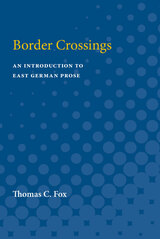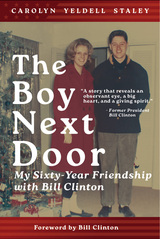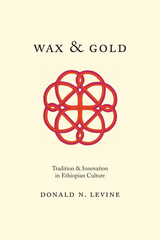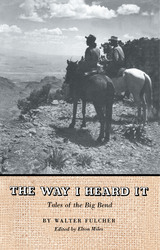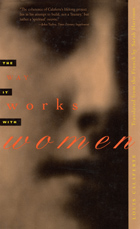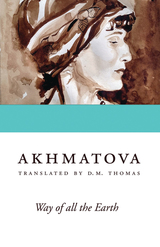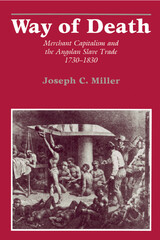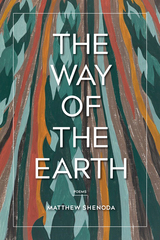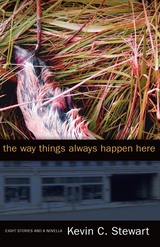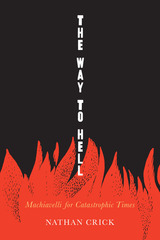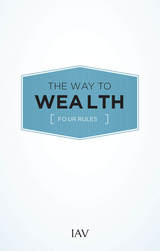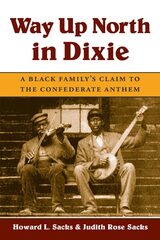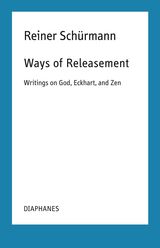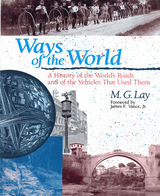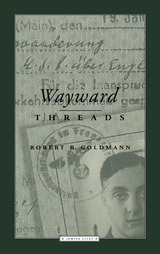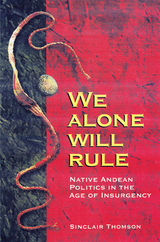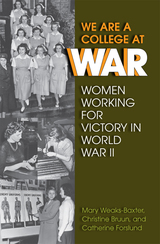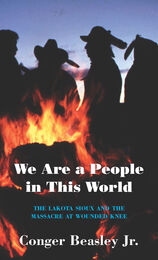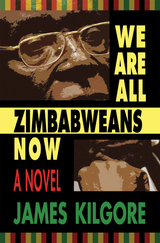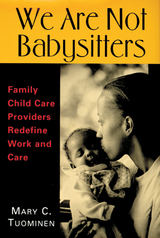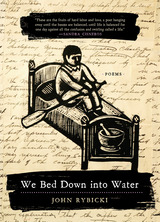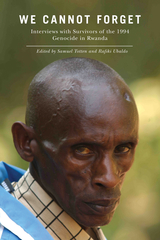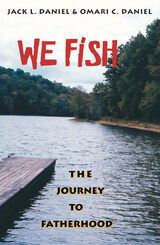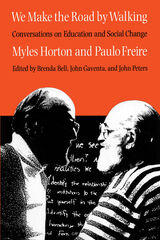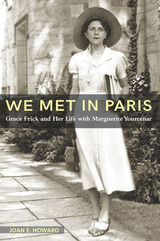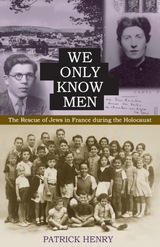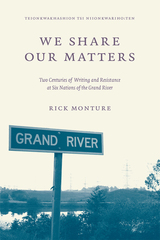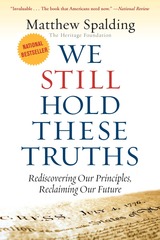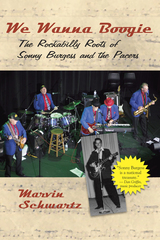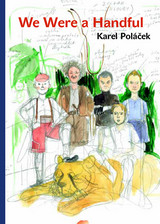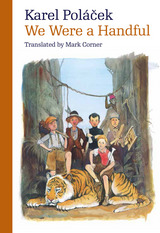 Waves of Protest: Popular Struggle in El Salvador, 1925–2005
Paul D. Almeida
University of Minnesota Press, 2008 One of the first longitudinal studies of collective resistance in the developing world, Waves of Protest examines large-scale contentious action in El Salvador during critical eras in the country’s history. Providing a compelling analysis of the massive waves of protests from the early twentieth century to the present in El Salvador, Paul D. Almeida fully chronicles one of the largest and most successful campaigns against globalization and privatization in the Americas. Drawing on original protest data from newspapers and other archival sources, Almeida makes an impassioned argument that regime liberalization organizes civil society and, conversely, acts of state-sponsored repression radicalize society. He correlates the ebb and flow of protest waves to the changes in regime liberalization and subsequent de-democratization and back to liberalization. Almeida shows how institutional access and competitive elections create opportunity for civic organizations that become radicalized when authoritarianism increases, resulting at times in violent protest campaigns that escalate to revolutionary levels. In doing so, he brings negative political conditions and threats to the forefront as central forces driving social movement activity and popular contention in the developing world. Paul D. Almeida is assistant professor of sociology at Texas A&M University. He is coeditor with Hank Johnston of Latin American Social Movements: Globalization, Democratization, and Transnational Networks.
Wax and Gold: Tradition and Innovation in Ethiopian Culture
Donald N. Levine
University of Chicago Press, 1965 In Abyssinian poetry, the “wax” is the obvious meaning, the “gold” is the hidden meaning. In Wax and Gold, Donald N. Levine explores mid-to-late-twentieth-century Ethiopian society on the same two levels, using modern sociology and psychology to seek answers to the following questions: What is the nature of the traditional culture of the dominant ethnic group, the Amhara, and what are its enduring values? What aspects of modern culture interest this society and by what means has it sought to institutionalize them? How has tradition both facilitated and hampered Ethiopian efforts to modernize? Enriched by the use of Ethiopian literature and by Levine’s deep knowledge of and affection for the society of which he writes, Wax and Gold is both a scholarly and a personal work.
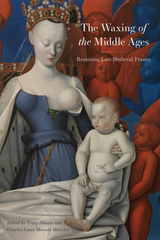 The Waxing of the Middle Ages: Revisiting Late Medieval France
Charles-Louis Morand-Métivier
University of Delaware Press, 2023 Johan Huizinga’s much-loved and much-contested Autumn of the Middle Ages, first published in 1919, encouraged an image of the Late French Middle Ages as a flamboyant but empty period of decline and nostalgia. Many studies, particularly literary studies, have challenged Huizinga’s perceptions of individual works or genres. Still, the vision of the Late French and Burgundian Middle Ages as a sad transitional phase between the High Middle Ages and the Renaissance persists. Yet, a series of exceptionally significant cultural developments mark the period.
The Waxing of the Middle Ages sets out to provide a rich, complex, and diverse study of these developments and to reassert that late medieval France is crucial in its own right. The collection argues for an approach that views the late medieval period not as an afterthought, or a blind spot, but as a period that is key in understanding the fluidity of time, traditions, culture, and history. Each essay explores some “cultural form,” to borrow Huizinga’s expression, to expose the false divide that has dominated modern scholarship.
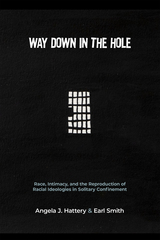 Way Down in the Hole: Race, Intimacy, and the Reproduction of Racial Ideologies in Solitary Confinement
Angela J. Hattery
Rutgers University Press, 2023 Based on ethnographic observations and interviews with prisoners, correctional officers, and civilian staff conducted in solitary confinement units, Way Down in the Hole explores the myriad ways in which daily, intimate interactions between those locked up twenty-four hours a day and the correctional officers charged with their care, custody, and control produce and reproduce hegemonic racial ideologies. Smith and Hattery explore the outcome of building prisons in rural, economically depressed communities, staffing them with white people who live in and around these communities, filling them with Black and brown bodies from urban areas and then designing the structure of solitary confinement units such that the most private, intimate daily bodily functions take place in very public ways. Under these conditions, it shouldn’t be surprising, but is rarely considered, that such daily interactions produce and reproduce white racial resentment among many correctional officers and fuel the racialized tensions that prisoners often describe as the worst forms of dehumanization. Way Down in the Hole concludes with recommendations for reducing the use of solitary confinement, reforming its use in a limited context, and most importantly, creating an environment in which prisoners and staff co-exist in ways that recognize their individual humanity and reduce rather than reproduce racial antagonisms and racial resentment. Way Down the Hole Video 1 (https://youtu.be/UuAB63fhge0) Way Down the Hole Video 2 (https://youtu.be/TwEuw1cTrcQ) Way Down the Hole Video 3 (https://youtu.be/bOcBv_UnHIs) Way Down the Hole Video 4 (https://youtu.be/cx_l1S8D77c)
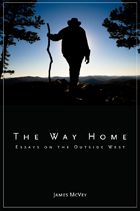 The Way Home: Essays on the Outside West
James McVey
University of Utah Press, 2010 "A sense of place can be a complicated matter," writes James McVey in the prologue to his new collection of essays, The Way Home. Based on twenty years of living and traveling in the West, the collection includes essays on river running, backcountry skiing, fly fishing, and backpacking—all describing various attempts to engage in meaningful contact with the elements of wild nature, and to have a deep firsthand knowledge of a place. With an essayists breadth McVey engages ecology, geology, anthropology, psychology, and history as well as his own personal outdoor experiences to peer into the particulars of living in as complicated a place as the West. While the essays function within the tradition of western nature writing, they transcend regional issues insofar as they maintain a broader philosophical context that accounts for such global concerns as mass extinction and climate change.
The essays use backcountry experiences as occasions for reflection on such topics as nature and culture, conservation, and the human relation to the wild. They combine the naturalist’s commitment to landscape with the adventurer’s attention to technique and skill. The outdoor experiences function as ritualized activity, the purpose of which is to explore a specific relation with a place. As such, the essays consider certain nonrational ways of knowing the world, including a perception of aesthetics based on sensory participation with the more-than-human world. This gets to the heart of the essential connection in this work between its adventure themes and nature concerns--a connection very much concerned with issues of lifestyle and worldview. McVey describes his own journey in the West, traveling through the varying philosophical revelations wilderness presents—"a lifetime of questions"—finally landing on a conservation ethic, a feeling of home.
The Way I Heard It: Tales of the Big Bend
By Walter Fulcher
University of Texas Press, 1959 The folklore of Texas' Big Bend region was still in the making during Walter Fulcher's lifetime. Born in Lampasas County in 1887, he worked on the Martin Ranch near Sheffield when a young man. There he witnessed events in the last outlaw activities of the Black Jack Ketchum gang. He also listened to legends told almost as gossip, and some of the legendary figures were still alive—or said to be alive, usually in hiding. In every village there was sure to be some ancient with a good memory and a better imagination, and Walter Fulcher heard many versions of many tales. He has set them down as he heard them, as simple folk tales that reflect the color of a wild and vivid country in 400 years of its settlement. The book has been edited, with introduction and notes, by Elton Miles, Professor of English at Sul Ross State College.
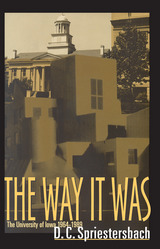 The Way It Was
Duane C. Spriestersbach
University of Iowa Press, 1999
The fall of 1964 was an exciting time at the University of Iowa. Its fourteenth president, Howard Bowen, had just arrived, and on a sunny October afternoon he made his first speech to the faculty. This occasion was note worthy enough—former president Virgil Hancher had held the job for twenty-four years—to attract the attention of a professor of speech pathology who had previously confined his considerable energies to teaching and research. Bowen's vision of what the university could become was so intriguing, so compelling, that this professor wrote and offered to help him achieve his objectives in any way possible. This quixotic offer changed Duane Spriestersbach's life and becomes the starting point for his story of his years as a University of Iowa administrator.
Drawing upon his personal files, the university archives, and interviews with many faculty members and administrators, Spriestersbach has created both an institutional and a personal history of the university. Judged by any standard, these years were tumultuous ones for higher education. Economic pressures from the state legislature, issues surrounding grants from such agencies as the National Institutes of Health and the National Science Foundation, the civil rights movement, student and faculty protests during the Vietnam era, massive changes in the physical and administrative shape of the campus, and the computerization of all parts of campus life had far-reaching consequences. Spriestersbach was at the center of these events at the University of Iowa; his perspective is unique, refreshing, and educational.
Spriestersbach's account of the Vietnam years and of the evolution of computers at Iowa will be particularly interesting to readers. He reported to four presidents, served as acting president, managed hundreds of meetings both dramatic and mundane, and reacted to many administrative restructurings. In this story of his life at the University of Iowa, he reveals the truth behind these words from his 1964 letter to President Bowen: “I think I am an idealist, a person with imagination, and a guy in a hurry. I believe investigation will show that I am a person with competitive administrative and executive abilities.”
The Way It Works with Women
Louis Calaferte
Northwestern University Press, 1998 Now in its first English translation, The Way It Works with Women is a brutal and relentless exploration of the dark side of desire. Shocking and poetic, the novel is composed of bits of dialogue: outbursts and exchanges spoken in the night and expressing naked physical and psychological yearning; murmurs of fragmentary declarations spoken in deserted doorways and dark hotel rooms. Grounded firmly in the literary tradition exemplified by Pierre Jean Jouve and Georges Bataille, The Way It Works with Women is a stunning introduction to one of the most unusual writers in contemporary French literature.
Way of All the Earth
Anna Akhmatova
Ohio University Press, 2001 Anna Akhmatova is considered one of Russia’s greatest poets. Her life encompassed the turmoil of the Russian Revolution and the paranoia and persecution of the Stalinist era: her works embody the complexities of the age. At the same time, she was able to merge these complexities into a single, poetic voice to speak to the Russian people with whom she so closely and proudly identified. Way of All the Earth contains short poems written between 1909 and 1964, selected from Evening, Rosary, White Flock, Plantain, Anno Domini, Reed, and The Seventh Book. Intricately observed and unwavering in their emotional immediacy, these strikingly modern poems represent one of the twentieth century’s most powerful voices.
 The Way Of All The Earth: Experiments in Truth and Religion
John S. Dunne
University of Notre Dame Press, 1978 "The holy man of our time, it seems, is not a figure like Gotama or Jesus or Mohammed, a man who could found a world religion, but a figure like Gandhi, a man who passes over by sympathetic understanding from his own religion to other religions and comes back again with new insight to his own. Passing over and coming back, it seems, is the spiritual adventure of our time. It is the adventure I want to undertake and describe in this book." -from the Preface
Through an examination of figures in various religions, including Gotama, Mohammed, and Gandhi, Dunne explores the possibilities of companionship with God.
"There is not another thinker--religious or secular--like [Dunne]. He brings to a too literal age the seer's gift for uncovering the connections between our existing approaches to knowledge."--Martin Marty
Other books by John S. Dunne that are available from the University of Notre Dame Press include The Homing Spirit: A Pilgrimage of the Mind, of the Heart, of the Soul [1997), The Mystic Road of Love (1999), and Reading the Gospel (2000).
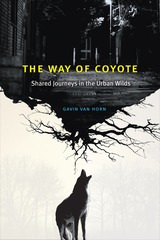 The Way of Coyote: Shared Journeys in the Urban Wilds
Gavin Van Horn
University of Chicago Press, 2018 Blending travelogue and philosophical reflection, Van Horn embarks on a quest for a new urban land ethic that reveals how urban animals can expand how we care for and understand place.
A hiking trail through majestic mountains. A raw, unpeopled wilderness stretching as far as the eye can see. These are the settings we associate with our most famous books about nature. But Gavin Van Horn isn’t most nature writers. He lives and works not in some perfectly remote cabin in the woods but in a city—a big city. And that city has offered him something even more valuable than solitude: a window onto the surprising attractiveness of cities to animals. What was once in his mind essentially a nature-free blank slate turns out to actually be a bustling place where millions of wild things roam. He came to realize that our own paths are crisscrossed by the tracks and flyways of endangered black-crowned night herons, Cooper’s hawks, brown bats, coyotes, opossums, white-tailed deer, and many others who thread their lives ably through our own.
With The Way of Coyote, Gavin Van Horn reveals the stupendous diversity of species that can flourish in urban landscapes like Chicago. That isn’t to say city living is without its challenges. Chicago has been altered dramatically over a relatively short timespan—its soils covered by concrete, its wetlands drained and refilled, its river diverted and made to flow in the opposite direction. The stories in The Way of Coyote occasionally lament lost abundance, but they also point toward incredible adaptability and resilience, such as that displayed by beavers plying the waters of human-constructed canals or peregrine falcons raising their young atop towering skyscrapers. Van Horn populates his stories with a remarkable range of urban wildlife and probes the philosophical and religious dimensions of what it means to coexist, drawing frequently from the wisdom of three unconventional guides—wildlife ecologist Aldo Leopold, Taoist philosopher Lao Tzu, and the North American trickster figure Coyote. Ultimately, Van Horn sees vast potential for a more vibrant collective of ecological citizens as we take our cues from landscapes past and present.
Part urban nature travelogue, part philosophical reflection on the role wildlife can play in waking us to a shared sense of place and fate, The Way of Coyote is a deeply personal journey that questions how we might best reconcile our own needs with the needs of other creatures in our shared urban habitats.
Way of Death: Merchant Capitalism and the Angolan Slave Trade, 1730–1830
Joseph Calder Miller
University of Wisconsin Press, 1996 This acclaimed history of Portuguese and Brazilian slaving in the southern Atlantic is now available in paperback.
With extraordinary skill, Joseph C. Miller explores the complex relationships among the separate economies of Africa, Europe, and the South Atlantic that collectively supported the slave trade. He places the grim history of the trade itself within the context of the rise of merchant capitalism in the eighteenth century. Throughout, Miller illuminates the experiences of the slaves themselves, reconstructing what can be known of their sufferings at the hands of their buyers and sellers.
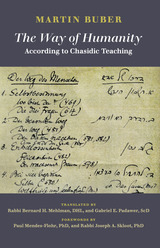 The Way of Humanity: According to Chasidic Teaching
Martin Buber
Central Conference of American Rabbis, 2023 Martin Buber (1878–1965) was one of the most influential Jewish
thinkers of the twentieth century. A philosopher, seeker, and nurturer of
dialogue, he responded to the complexities of his times by affirming the
fullness of interpersonal encounter and the spiritual everyday. In 1947,
Buber delivered lectures interpreting six traditional Chasidic stories
to a German-speaking audience, published as The Way of Humanity. In
the first new English translation in over half a century, Rabbi Bernard
H. Mehlman, DHL, and Gabriel E. Padawer, ScD, z"l, bring the work to
contemporary readers in a clear, accessible voice. The teachings within
highlight the subversion and innovation of the early Chasidic masters of
the eighteenth and nineteenth centuries, while providing meaningful
spiritual guidance and insight for any seeker today. Scholarly forewords
by Paul Mendes-Flohr, PhD, and Rabbi Joseph A. Skloot, PhD, as well
as an introduction, epilogue, and notes from the translators, place
Buber’s work in historical context. Timeless and enlightening, The Way
of Humanity guides us to inner meaning and highlights our human
wholeness.
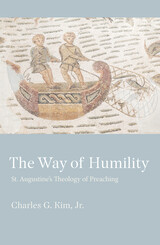 The Way of Humility: St. Augustine's Theology of Preaching
Charles J. Kim
Catholic University of America Press, 2023 For Augustine, that the Word became flesh transformed a merely human understanding of the virtues and grounds all virtue in humility. The Way of Humility: Augustine’s Theology of Preaching explores how this truth became a new paradigm for understanding the scriptures and thus, how Augustine embodied the virtue in the preaching of the scriptures. One of Augustine’s most devoted students, Possidius, said that anyone can learn from reading Augustine, but “those were able to profit still more who could hear him speak in church and see him with their own eyes. Truly, he was indeed one of those of whom it is written, ‘speak this way and act the same way.’” The Way of Humility searches for evidence of the virtue of humility in action through the preaching of the humble Word in the sermons of Augustine.
Many know of Augustine through his more famous treatises but few have encountered the Doctor of Grace where he had his most immediate impact, preaching. The Way of Humility follows the sermons through several traditional theological loci, ecclesiology, Christology, soteriology to uncover what can be learned about Augustine’s theology through the way he preached to a mixed audience of urbanites and rustics, many of whom did not have the benefit of a formal education. Throughout the book, we see the interplay between Augustine’s action in speech and Augustine’s more direct statements on his theology of Preaching. Through handing over Christ in his sermons, he became himself an example of humility for the congregation on their journey toward the final end for all people, the Beatific Vision.
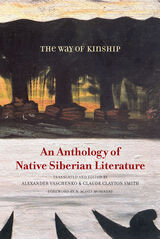 The Way of Kinship: An Anthology of Native Siberian Literature
Alexander Vaschenko
University of Minnesota Press, 2010 That these treasures are available to us as writing is a miracle. . . . The writings here, while altogether modern in one sense, are based upon a literature, albeit oral, that has existed for thousands of years. They are the reflections of people who have lived long on the earth, on their own terms, in harmony with the powers of nature. They are invaluable to us who have so much to learn from them. These stories, poems, songs give us a way, a sacred way, into a world that we ought to know for its own sake. It is our own world, after all. —N. Scott Momaday, from the Foreword
The first anthology of Native Siberian literature in English, The Way of Kinship represents writers from regions extending from the Ob River in the west to the Chukotka peninsula, the easternmost point of the Siberian Russian Arctic. Drawn from seven distinct ethnic groups, this diverse body of work-prose fiction, poetry, drama, and creative nonfiction-chronicles ancient Siberian cultures and traditions threatened with extinction in the contemporary world.
Translated and edited by Alexander Vaschenko and Claude Clayton Smith, leading scholars in Native Siberian literature, The Way of Kinship is an essential collection that will introduce readers to new writers and new worlds.
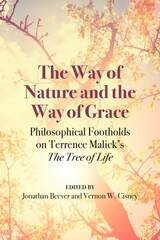 The Way of Nature and the Way of Grace: Philosophical Footholds on Terrence Malick's "The Tree of Life"
Jonathan Beever and Vernon W. Cisney
Northwestern University Press, 2016 Amid all the controversy, criticism, and celebration of Terrence Malick's award-winning film The Tree of Life, what do we really understand of it? The Way of Nature and the Way of Grace thoughtfully engages the philosophical riches of life, culture, time, and the sacred through Malick's film. This innovative collection traverses the relationships among ontological, moral, scientific, and spiritual perspectives on the world, demonstrating how phenomenological work can be done in and through the cinematic medium, and attempting to bridge the gap between narrow "theoretical" works on film and their broader cultural and philosophical significance. Exploring Malick's film as a philosophical engagement, this readable and insightful collection presents an excellent resource for film specialists, philosophers of film, and film lovers alike.
The Way of Oblivion: Heraclitus and Kafka
David Schur
Harvard University Press, 1998 If Heraclitus is one of our most ancient writers, Kafka seems especially modern. They share in a struggle between disclosure and obscurity that is perhaps as old as writing itself. In this lucid and engaging volume, David Schur takes us from philosophy to literature and back in a sustained examination of a fundamental philosophical metaphor: the way or path of method. Through close readings of texts by Heraclitus, Plato, Heidegger, Blanchot, and Kafka, he follows the development of a rhetorical commonplace into a distinctly Heraclitean paradox of method, concluding that Kafka's account of the way beyond mortal existence renews Heraclitus's emphasis on oblivion in the search for truth.
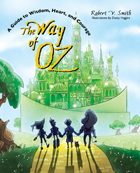 The Way of Oz: A Guide to Wisdom, Heart, and Courage
Robert V. Smith, with illustrations by Dusty Higgins
Texas Tech University Press, 2012 You’ve met them in your own life: the influential mentor who made a difference. The public servant whose energy and dedication were an inspiration to all. The business leader who overcame adversity and succeeded in an admirable endeavor. The visionary who drew an entire community or organization together. You may not realize that you’ve also met them in a classic of American literature and cinema. Veteran educator Robert V. Smith adopts the virtues of the beloved and familiar characters from the Wizard of Oz stories, along with the trials and triumphs of their creator, L. Frank Baum, as a road map for personal and professional growth. The magical archetypes of the Scarecrow, the Tin Woodman, the Cowardly Lion, Dorothy, Toto, and the Wizard guide readers—especially those preparing for college and career—to a deeper understanding of lifelong learning, loving, serving, and leading. Smith blends Baum’s fascinating biography and publishing history with practical advice and philosophy drawn from a rich array of sources. Further, the book’s chapters are enhanced with rich video content linked by interactive codes. For seekers and teachers alike, The Way of Oz opens the door to an imaginative, inspiring journey and challenges all aspirants to make a difference in their work and world.
 The Way of Suffering: A Geography of Crisis
Jerome Miller
Georgetown University Press, 1988 This book can best be described as an extended meditation on suffering, phenomenological in method and dialectical in point of view. The angle the author takes is that of moral self-examination rather that conventional scholarly inquiry, and his aim is to think through and evaluate a fundamental claim of our culture, from Aeschylus to Solzhenitsyn, that suffering is the greatest spiritual teacher. To bring the argument closer to home, Professor Miller focuses on the experience of crisis as the undermining of our attempts, at all costs, to keep control of our lives. This leads him to discuss topics such as the nature of vulnerability, the difference—as sketched by Heidegger—between ordinary fear and metaphysical dread, the ordinary avoidance of suffering, and the heroic willingness to embrace it exemplified by Nietzsche's Thus Spake Zarathustra. But this is a philosophical essay, not a historical monograph, and Miller's goal is to lead the reader ever deeper in to the heart of crisis where all our illusions about control are stripped away and we forced to face, like Oedipus, the harshest reality of all: that even our existence is not something we can claim as our own. It is here, and only here, Miller claims, the issue of religious conversion can be and must be seriously faced. This is a demanding book, as exhilarating as it is relentless in its unmasking of the evasions and duplicities with which we shore up our day-to-day lives. The late William F. Lynch, SJ, author of Christ and Apollo, called it "a profoundly moral study of man." To read it is to risk changing your life.
The Way of the Earth: Poems
Matthew Shenoda
Northwestern University Press, 2022 A lyrical collection examines the quotidian beauty that surrounds us despite deep loss and climate crisis
The Way of the Earth is the fourth collection from award-winning poet Matthew Shenoda. In this, his most personal collection to date, he explores the temporal and fleeting nature of human life and the earth we inhabit. Through ruminations on the intersections of culture and ecology, the death of loved ones, and the growing inequities in our midst, Shenoda explores what it means to be a person both grounded to the earth and with a yearning beyond it. Memories of landscapes and histories echo throughout the sensations of the present: the sight of egrets wading in the marshes, the smell of the ocean, a child’s hand nestled in a warm palm. “Time never goes back,” Shenoda writes, “but the imagination must.”
 The Way of the Gadfly: A Study of Coherency in Socratic Thought
Ryszard Legutko
St. Augustine's Press, 2024 This new series of scholarly reflections on the interpretation of Socratic philosophy is an inviting combination of intuition and meticulous analysis. Ryszard Legutko provides the reader a monumental service in his confrontation of the most important and influential literature written on the subject to date. He likewise opens the conversation to European contributions and renders Socrates truly a figurehead of future philosophy far beyond being a pillar in ancient thought.
Legutko argues that Socrates was systematic, and his moral views were ultimately grounded in his theory of knowledge that was composed of logically connected propositions (logoi). Reading Plato, Legutko's intuition that Socrates was quite the opposite of the quirky, ironic, and enigmatic character is supported by his demonstration of Socrates' consistency, unity, and hierarchy of thought. He extends Socrates' coherency to a criticism of the democratic mind, framing him even less as a random spit-fire and more the grounded observer. Socrates, argues Letgutko, is well aware of the importance of general concepts and he intended to free these concepts from democratic distortions and give them firm and independent foundations.
In short, 'the way of the gadfly' is a beautiful and precise exploration of order that seeks to be changed by the awareness of this order, and how to wield concepts apart from the motives of arrogance and chaos––neither of which represent nature, and therefore are foreign to the way of the gadfly.
 The Way of Western Art, 1776-1914
Edgar Preston Richardson
Harvard University Press On a large canvas and in very broad scope Mr. Richardson has laid in the whole development of nineteenth-century western art. Breaking away from the detailed analysis of individual artists and individual events, which has absorbed recent criticism, he has achieved a synthesis of all the arts, treating them together as an expression of civilization. He feels that the history of art during the past one hundred and fifty years is, like that of the Middle Ages, a record of the life and ideals and dreams of our civilization and not something produced in a vacuum to be judged by a special esthetic faculty. He adopts, moreover, the view that there has been as great a degree of intellectual and spiritual connection between modern nations (at least in the arts) as there ever was between the nations of the Middle Ages; and he therefore treats western art as a unit. He has limited his perspective to France, England, Germany, Austria, and the United States. Treating western art in this way involves the question of the place of American art in the larger whole of modern civilization. Furthermore it involves to a considerable degree a re-survey and re-estimation of much of our nineteenth century art and likewise the inclusion of a great deal of English, German, and Austrian work of wide interest. The volume is notable for the unusually large number of illustrations, which not only illuminate the discussion but add to the attractiveness of the work for personal study and for use as a holiday gift.
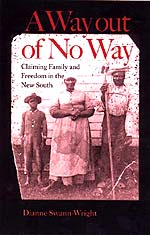 A Way out of No Way: Claiming Family and Freedom in the New South
Dianne Swann-Wright
University of Virginia Press, 2002 An African American folk saying declares, "Our God can make a way out of no way. . . . He can do anything but fail." When Dianne Swann-Wright set out to capture and relate the history of her ancestors--African Americans in central Virginia after the Civil War--she had to find that way, just as her people had done in creating a new life after emancipation. In order to tell their story, she could not rely solely on documents from the plantation where her forebears had lived. Unlike the register of babies born, marriages made, or lives lost that white families' Bibles contained, ledgers recorded Swann-Wright's ancestors, as commodities. Thus Swann-Wright took another route, setting out to gather spoken words--stories, anecdotes, and sayings. What results is a strikingly rich and textured history of a slave community.
Looking at relations between plantation owners and their slaves and the succeeding generations of both, A Way out of No Way explores what it meant for the master-slave relation to change to one of employer and employee and how patronage, work relationships, and land acquisition evolved as the people of Piedmont Virginia entered the twentieth century. Swann-Wright illustrates how two white landowners, one of whom had headed a plantation before the Civil War, learned to compensate freed persons for their labor. All the more fascinating is her study of how the emancipated learned to be free--of how they found their way out of no way.
"Dianne Swann-Wright has an obvious penchant for storytelling and thus makes the scenes she sets and the sources she employs come fully alive, almost as would scenes and characters in a work of fiction."
--Deborah E. McDowell, author of Leaving Pipe Shop: Memories of Kin
"Swann-Wright has imaginatively reconstructed both white and black experience in a place geographically tiny yet large in significance and resonance."
--Jack Kirby, author of Poquosin: A Study of Rural Landscape and Society
Dianne Swann-Wright is Director of African American and Special Programs and Project Historian for the Getting Word oral history program at Monticello. She has been an educator, historian, and museum consultant on issues of African American history and culture.
 The Way: Religious Thinkers of the Russian Emigration in Paris and Their Journal, 1925-1940
Antoine Arjakovsky
University of Notre Dame Press, 2013 The journal Put', or The Way, was one of the major vehicles for philosophical and religious discussion among Russian émigrés in Paris from 1925 until the beginning of World War II. This Russian language journal, edited by Nicholas Berdyaev among others, has been called one of the most erudite in all Russian intellectual history; however, it remained little known in France and the USSR until the early 1990s. This is the first sustained study of the Russian émigré theologians and other intellectuals in Paris who were associated with The Way and of their writings, as published in The Way. Although there have been studies of individual members of that group, this book places the entire generation in a broad historical and intellectual context. Antoine Arjakovsky provides assessments of leading religious figures such as Berdyaev, Bulgakov, Florovsky, Nicholas and Vladimir Lossky, Mother Maria Skobtsova, and Afanasiev, and compares and contrasts their philosophical agreements and conflicts in the pages of The Way. He examines their intense commitment to freedom, their often contentious struggles to bring the Christian tradition as experienced in the Eastern Church into conversation with Christians of the West, and their distinctive contributions to Western theology and ecumenism from the perspective of their Russian Orthodox experience. He also traces the influence of these extraordinary intellectuals in present-day Russia, Western Europe, and the United States.
Throughout this comprehensive study, Arjakovsky presents a wealth of arguments, from debates over "Russian exceptionalism" to the possibilities of a Christian and Orthodox version of socialist politics, the degree to which the church could allow its agenda to be shaped by both local and global political realities, and controversies about the distinctively Russian theology of Divine Wisdom, Sophia. Arjakovsky also maps out the relationships these émigré thinkers established with significant Western theologians such as Jacques Maritain, Yves-Marie Congar, Henri de Lubac, and Jean Daniélou, who provided the intellectual underpinnings of Vatican II.
"The Way is an important work, brilliantly researched, and the product of a true scholar who talks to us theologically as he progresses. Antoine Arjakovsky's main focus of interest is on ecumenical theology, and he argues convincingly that Orthodox thought as manifested in these leading-edge thinkers still has a major role to play in opening an authentically Orthodox but inclusive ecclesiological line of approach to contemporary Christianity." —John A. McGuckin, Union Theological Seminary
"The journal The Way was the heartbeat of the Russian religious intelligentsia from 1925 until the end of World War II, and no more creative band of religious thinkers existed anywhere in the world at the time than this small group of Russians coordinated by the indefatigable Berdyaev. This book is an extraordinarily rich study that deserves to be widely known. Its subject is of the first order of importance for modern intellectual history." —Paul Valliere, Butler University
"The Way is the first comprehensive study of one of the most important movements in modern Russian intellectual history. Arjakovsky provides a lucid account of a vibrant theological circle of Russian emigres in Paris who were in dialogue with their Western Christian counterparts. They sought to develop Christian thinking that remained rooted in tradition but could speak to modern problems, exploring its implications for philosophical, political, and cultural issues that still have much to say to contemporary Christian thought. We are deeply indebted to Arjakovsy for this masterful presentation." —Scott Kenworthy, Miami University
"Antoine Arjakovsky has provided English readers with the first in-depth study of an unparalleled creative moment in the history of modern Russian religious and Orthodox thought, the lasting impact of which has yet to be fully appreciated. Both a historical excursion and a critical intellectual enterprise in its own right, Arjakovsky’s study offers a detailed guide to the diversity of thought and philosophical debates among a stellar group of Russian émigré intellectuals. Those interested in the history of modern Orthodox Christian thought, Russian religious philosophy, and church politics among the first wave of Russia’s Orthodox emigration will find a trove of information in this volume." —Vera Shevzov, Smith College
THE WAY THINGS ALWAYS HAPPEN HERE
Eight Stories and a Novella by Kevin C. Stewart
West Virginia University Press, 2007 In his debut short-fiction collection, The Way Things Always Happen Here, Kevin C. Stewart takes his readers to the scene of a heinous murder, to the home of an alcoholic single mother, to the 1960s election campaign of JFK through West Virginia, and off the side of the New River Gorge Bridge. In these eight stories set in fictional Oak County in southern West Virginia, and one novella set in the Arkansas Ozarks, Stewart gives us characters who all love and hate where they’re from.
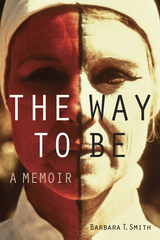 The Way to Be: A Memoir
Barbara T. Smith
J. Paul Getty Trust, The A firsthand account of the life and work of Barbara T. Smith, one of the most important yet underrecognized performance artists in the United States.
For over fifty years, Barbara T. Smith has been at the forefront of artistic movements in California. Her work across many mediums explores concepts that strike at the core of human nature, including sexuality, physical and spiritual sustenance, technology, and death. In this memoir, Smith weaves together descriptive accounts of her pioneering performances with an intimate narrative of her life.
The Way to Be covers the years 1931 to 1981, up to the artist’s fiftieth birthday, resulting in an exhaustive catalogue of her early work. It reveals the personal stories and events behind her pieces and the challenges she faced in an art world dominated by sexism and machismo. Drawing on Smith’s archive at the Getty Research Institute, this enthralling book presents previously unpublished notes, documents, photographs, and firsthand accounts of her life and practice, as well as her more recent reflections on the past. The Way to Be demonstrates Smith’s lasting contributions to the field of contemporary art and provides an engaging commentary on a recent period of great cultural and political change.
This volume is published to accompany an exhibition on view at the Getty Research Institute at the Getty Center from February 28 to July 16, 2023.
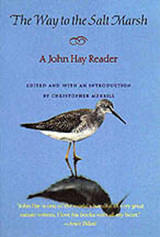 The Way to the Salt Marsh: A John Hay Reader
John Hay
Brandeis University Press, 1998 "In common things are greater extensions of ourselves than we ever conceived of." "Life on earth springs from a collateral magic that we rarely consult," observes John Hay, naturalist, essayist, sage, and inveterate walker of byways. This collection from the 50-year long career of America's preeminent nature writer illustrates the full range of Hay's work. An elegant and lyrical stylist, he is, in Merrill's words, "the nature writer's writer, an illustrator of the Emersonian notion that 'the world is emblematic.'" And so Hay reveals the ubiquitous but often unnoticed emblems all around us. The mad, impossible rush of alewives flinging themselves upstream to mate, for example, represents "the drive to be, a common and terrible sending out, to which men are also bound in helplessness." In the migratory movements of the terns and the green turtles past his beloved Cape Cod Hay sees the mystery and magnificence of homing: "To know your direction and return through outer signs, is as new as it is ancient. We are still people of the planet, with all its original directions waiting in our being." Whether describing the rugosa or bayberry of a sand dune, the plight of stranded pilot whales, or a spider swinging on its gossamer, Hay encourages us to enlarge our inner universe by observing, appreciating, and preserving the outer one we so often ignore. As a result, he says, "we may find that we are being led onto traveled ways that were once invisible to us," and by recognizing our "deep alliance with natural forces we find a new depth in ourselves. This is the common ground for all living things."
 The Way toward Wisdom: An Interdisciplinary and Intercultural Introduction to Metaphysics
Benedict M. Ashley, O.P.
University of Notre Dame Press, 2006
Working from a realist Thomistic epistemology, Ashley asserts that we must begin our search for wisdom in the natural sciences; only then, he believes, can we ensure that our claims about immaterial and invisible things are rooted in reliable experience of the material. Any attempt to share wisdom, he insists, must derive from a context that is both interdisciplinary and intercultural.
Ashley offers an ambitious analysis and synthesis of major historical contributions to the unification of knowledge, including non-Western traditions. Beginning with the question "Metaphysics: Nonsense or Wisdom?" Ashley moves from a critical examination of the foundations of modern science to quantum physics and the Big Bang; from Aristotle's theory of being and change, through Aquinas's five ways, to a critical analysis of modern and postmodern thought. Ashley is able to interweave the approaches of the great philosophers by demonstrating their contributions to philosophical thought in a concrete, specific manner. In the process, he accounts for a contemporary culture overwhelmed by the fragmentation of data and thirsting for an utterly transcendent yet personal God.
"This is an impressive, well-researched book, of great value. It offers the wider philosophical community a point of entrance, by a proponent of a certain type of Thomism, into a domain that all philosophers think they already understand. The result is the creation of a 'big picture' of human knowledge." -- Mark Johnson, Marquette University
Way Up North in Dixie: A Black Family's Claim to the Confederate Anthem
Howard L. Sacks and Judith Rose Sacks
University of Illinois Press, 2003 This book traces the lives of the Snowdens, an African American family of musicians and farmers living in rural Knox County, Ohio. Howard L. Sacks and Judith Rose Sacks examine the Snowdens' musical and social exchanges with rural whites from the 1850s through the early 1920s and provide a detailed exploration of the claim that the Snowden family taught the song "Dixie" to Dan Emmett-–the white musician and blackface minstrel credited with writing the song. This edition features a new introduction in which the authors discuss the public response to this controversial claim, and present new information on the Snowdens' musical and social experiences.
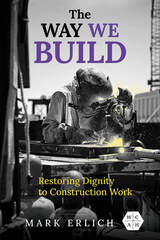 The Way We Build: Restoring Dignity to Construction Work
Mark Erlich
University of Illinois Press, 2023 The construction trades once provided unionized craftsmen a route to the middle class and a sense of pride and dignity often denied other blue-collar workers. Today, union members still earn wages and benefits that compare favorably to those of college graduates. But as union strength has declined over the last fifty years, a growing non-union sector offers lower compensation and more hazardous conditions, undermining the earlier tradition of upward mobility. Revitalization of the industry depends on unions shedding past racial and gender discriminatory practices, embracing organizing, diversity, and the new immigrant workforce, and preparing for technological changes. Mark Erlich blends long-view history with his personal experience inside the building trades to explain one of our economy’s least understood sectors. Erlich’s multifaceted account includes the dynamics of the industry, the backdrop of union policies, and powerful stories of everyday life inside the trades. He offers a much-needed overview of construction’s past and present while exploring roads to the future.
 The Way We Really Were: THE GOLDEN STATE IN THE SECOND GREAT WAR
Edited by Roger W. Lotchin
University of Illinois Press, 2000 The customary picture of the World War II era in California has been dominated by accounts of the Japanese American concentration camps, African Americans, and women on the home front.
The Way We Really Were substantially enlivens this view, addressing topics that have been neglected or incompletely treated in the past to create a more rounded picture of the wartime situation at home. Exploring the developments brought to fruition by the war and linking them to their roots in earlier decades, contributors address the diversity of the musical scene, which arose from a cross-pollination of styles brought by Okies, blacks, and Mexican migrants. They examine increased political involvement by women, Hollywood's response to the war, and the merging of business and labor interests in the Bay Area Council. They also reveal how wartime dynamics led to substantial environmental damage and lasting economic gains by industry.
The Way We Really Were examines significant wartime changes in the circumstances of immigrant groups that have been largely overlooked by historians. Among these are Italian Americans, heavily insular and pro-Fascist before the war and very pro-American and assimilationist after, and Chinese American men, who achieved new legitimacy and entitlement through military service. Also included is a look at cultural negotiation among multiple ethnic groups in the Golden State. A valuable addition to the literature on California history, The War We Really Were provides an entree into new areas of scholarship and a fresh look at familiar ones.
 The Way We Vote: The Local Dimension of American Suffrage
Alec C. Ewald
Vanderbilt University Press, 2009 To a degree unique among democracies, the United States has always placed responsibility for running national elections in the hands of county, city, and town officials. The Way We Vote explores the causes and consequences of America's localized voting system, explaining its historical development and its impact on American popular sovereignty and democratic equality. The book shows that local electoral variation has endured through dramatic changes in American political and constitutional structure, and that such variation is the product of a clear, repeated developmental pattern, not simple neglect or public ignorance. Legal materials, statutes and Congressional debates, state constitutional-convention proceedings, and the records of contested Congressional elections illuminate a long record of federal and state intervention in American electoral mechanics. Lawmakers have always understood that a certain level of disorder characterizes U.S. national elections, and have responded by exercising their authority over suffrage practices--but only in limited ways, effectively helping to construct our triply-governed electoral system.
 A Way With Words: Style in the Age of Artificial Intelligence
John Marsh
University of Michigan Press, 2026 A Way with Words helps readers learn the essentials of writing. Rather than lecturing about when to use who or whom, this book focuses on writing clear, concise, and lively prose: eliminating wordiness, using active verbs, avoiding run-on sentences. John Marsh applies his experience grading over 5,000 essays over a quarter century as a teacher to take readers through the issues he most commonly sees. While Marsh teaches in the humanities, the advice applies to writing regardless of discipline.
Using examples from papers students might actually write, the book invites readers to apply what they have learned to quizzes that mix and match issues—vague pronouns, sentence fragments, punctuating quotations—from previous chapters. The book includes a thoughtful discussion about balancing the competing demands of writing well and fighting linguistic discrimination. Finally, A Way with Words prompts readers to consider what artificial intelligence programs like ChatGPT and Bard will mean for student writing. It offers advice about how writers can distinguish their writing from the assembly-line writing that artificial intelligence tends to generate, and how they can develop their style to stand out to their teachers, employers, and clients.
 Wayang and Its Doubles: Javanese Puppet Theatre, Television and the Internet
Jan Mrázek
National University of Singapore Press, 2019 Wayang, or Javanese puppet theater, has been around for millennia, bringing people together for live performances while reflecting the changes and tensions in society. Television has been around for decades, bringing news and entertainment from around the world directly into homes and public spaces while completely reshaping culture. The two formats—one an ancient art, the other a relatively new media—seem like disparate pieces yet they are both intensely part of the Javanese world. They are inescapable from each other in a relationship that has been described as a “difficult marriage”: intimate on the one hand, deeply alienating on the other, institutionalized yet at the same time mercurial and shifting.
This book explores the ways two complex forms of media coexist and meet as well as haunt and invade each other. It looks at performance aesthetics and the technicalities of television production, as well as issues of time, space, light, place, and movement. It compares audience experiences of live and televised performances, and highlights the collaboration and struggle between performers and television producers. Interviews with performers from both sides are brought into a larger conversation on media and technology, one that includes ideas from Karl Marx, Martin Heidegger, Maurice Merleau-Ponty, Jacques Derrida, Paul Virilio, and James Siegel. The book also looks ahead to new formats that have the potential to disrupt in ways never imagined: the worlds of streaming and social media.
The Wayfarer
Cyrus Console
Omnidawn, 2024 Poetic ballads that speak to a father’s quest to chronicle daily life amid times of collapse.
Taking its name from part of a lost triptych by Dutch painter Hieronymus Bosch, The Wayfarer documents its speaker’s attempt to forge a path through the world—both as a father and as an artist—and to adequately capture the experience of living through poetry. In language that melds the vernacular and the archival, these ballads recall moments of love as they arise in an everyday existence dominated by an awareness of political and ecological collapse. Caught between the terror of wandering and the awe of witnessing new minds as they acquire early words and memories, the poems hold out hope for the tenuous transmission of meaning between generations.
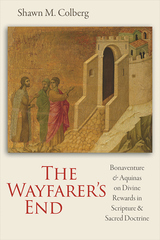 The Wayfarer's End: Bonaventure and Aquinas on Divine Rewards in Scripture and Sacred Doctrine
Shawn M. Colberg
Catholic University of America Press, 2020 The Wayfarer’s End follows the human person’s journey to union with God in the theologies of Saint Bonaventure and Saint Thomas Aquinas. It argues that these seminal thinkers of the 13th Century emphasize scriptural notions of divine rewards as ordering principles for the graced movement of human viators to eternal life. Divine rewards emerge as a fundamental category through the study’s emphasis on Thomas and Bonaventure as scriptural commentators and preachers whose work in sacra pagina structures the content of their sacra doctrina. Shawn Colberg places Bonaventure’s and Aquinas’s scriptural, dogmatic, and polemical works into conversation and illumines their mutually edifying depictions of the way to eternal life.
Looking to the journey itself, The Wayfarer’s End demonstrates a nuanced understanding of the roles played by God and human beings in the movement to full beatitude. To that end, it explores the relationships between grace and human nature, the effects of sin on the human person, the vital themes of predestination, conversion, perseverance, and the place of “reward-worthy” human action within the overall movement toward union with God. While St. Bonaventure and St. Thomas both stress the priority of grace and divine action for the journey, the study also illustrates their distinct frameworks for human action, unpacking Bonaventure’s preference for the language of acceptatio versus Thomas’s emphasis on ordinatio. This difference inflects their language of rewards, their exposition of scripture, and the scope of free human action in the movement to union with God.
This study places the two most seminal theologians of the 13th Century into conversation on central and enduring topics of Christian life. Such a comparative study has been sorely lacking in the field of studies on Aquinas and Bonaventure. It offers insight to those interested in high scholastic thought, Franciscan and Dominican understandings of human salvation, and Thomist and Franciscan theology as it pertains to questions of the Reformation, including biblical exegesis on justification and sanctification. Above all, the study appreciates and foregrounds the richness of Bonaventure’s and Aquinas’s vocations: mendicant theologians concerned to share the fruits of contemplation with fellow friars and others seeking the goal of the wayfarer’s end.
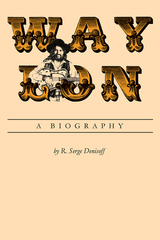 Waylon: A Biography
R. Serge Denisoff
University of Tennessee Press, 1983 From his earliest recordings to his posthumously released albums, the haunting baritone of Waylon Jennings marked him as an extraordinarily individualistic country music artist. This biography by the late R. Serge Denisoff, first published in 1983, recounts Waylon’s west Texas upbringing, his introduction to music as a radio announcer at thirteen years old, his tutelage by rock star Buddy Holly, and his eventual stellar yet stormy music career. Where the original 1983 biography ends, music scholar Travis Stimeling picks up with the waning years of Waylon’s recording and performing. Stimeling recounts in the new afterword Waylon’s continued musical success in the early 1980s—though his financial troubles and battle with drugs and alcohol would soon cost him both professionally and personally—his triumphant and sober return in the 1990s and collaboration with longtime recording artists in the industry, and his continued musical relevance in an evolving industry driven by Nashville’s urban popularization of country music. Additionally, series editor Ted Olson, in his foreword, touches on Waylon’s legacy and the continued influence of his outlaw style of country music. Fans of Waylon, country music, and the Nashville music scene are sure to find this second edition of R. Serge Denisoff’s classic biography a welcome addition to the publications on the father of outlaw country.
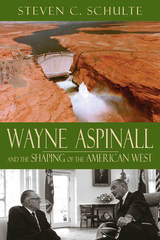 Wayne Aspinall and the Shaping of the American West
Steven C. Schulte
University Press of Colorado, 2002 Colorado Congressman Wayne N. Aspinall was variously dubbed the "Ruler of the Land," a "bridge between the old and new Wests," and the environmental movement's "most durable foe." The late David Brower, the notable Sierra Club leader, remarked that the environmental movement had seen "dream after dream dashed on the stony continents of Wayne Aspinall." In Wayne Aspinall and the Shaping of the American West, Steven C. Schulte details a political career that encompassed some of the most crucial years in the development of the twentieth-century West. As chairman of the House Interior and Insular Affairs Committee from 1959 to 1973, Aspinall shaped the nation's reclamation, land, wilderness, and natural resource policies. His crusty and dtermined personality was at the enter of some of the key environmental battles of the twentieth century, including the Echo Park Dam fight, the struggle for the Wilderness Act, and the long controversy over the Central Arizona Project.
 Ways & Power Of Love: Techniques Of Moral Transformation
Pitirim A. Sorokin
Templeton Press, 2002 The Ways and Power of Love was originally published in 1954 when Pitirim Sorokin was in the twilight of his career and leading the Harvard Research Center in Creative Altruism. His elaborate scientific analysis of love with regard to its higher and lower forms, its causes and effects, its human and cosmic significance, and its core features constitutes the first study on this topic in world literature to date. Sorokin was the one absolutely essential twentieth-century pioneer in the study of love at the interface of science and religion. Bringing The Ways and Power of Love back into print allows a new generation of readers to appreciate Sorokin's genius and to move forward with his endeavor at a time when civilization itself continues to be threatened by a marked inability to live up to the ideal of love for all humankind. It is certainly right to hope, with Sorokin, that progress in knowledge about love can move humanity forward to a better future. Turning the sciences toward the study of love is no easy task, but it can and must be done.
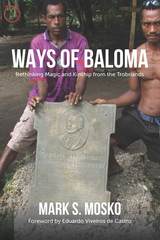 Ways of Baloma: Rethinking Magic and Kinship From the Trobriands
Mark S. Mosko
HAU, 2017 Bronislaw Malinowski’s path-breaking research in the Trobriand Islands shaped much of modern anthropology’s disciplinary paradigm. Yet many conundrums remain. For example, Malinowski asserted that baloma spirits of the dead were responsible for procreation but had limited influence on their living descendants in magic and other matters, claims largely unchallenged by subsequent field investigators, until now. Based on extended fieldwork at Omarakana village—home of the Tabalu “Paramount Chief”—Mark S. Mosko argues instead that these and virtually all contexts of indigenous sociality are conceived as sacrificial reciprocities between the mirror worlds that baloma and humans inhabit.
Informed by a synthesis of Strathern’s model of “dividual personhood” and Lévy-Bruhl’s theory of “participation,” Mosko upends a century of discussion and debate extending from Malinowski to anthropology’s other leading thinkers. His account of the intimate interdependencies of humans and spirits in the cosmic generation and coordination of “life” (momova) and “death” (kaliga) strikes at the nexus of anthropology’s received wisdom, and Ways of Baloma will inevitably lead practitioners and students to reflect anew on the discipline’s multifold theories of personhood, ritual agency, and sociality.
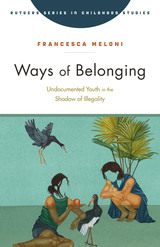 Ways of Belonging: Undocumented Youth in the Shadow of Illegality
Francesca Meloni
Rutgers University Press, 2024 Hart–SLSA Prize for Early Career Academics, Socio-Legal Studies Association Ways of Belonging examines the experiences of undocumented young people who are excluded from K–12 schools in Canada and are rendered invisible to the education system. Canadian law doesn’t mention the existence of undocumented children, and thus their access to education rests on discretionary practices and is often denied altogether. This book brings the stories of undocumented young people vividly alive, putting them into conversation with the perspectives of the different actors in schools and courts who fail to include these young people. Drawing on long-term ethnographic fieldwork, Francesca Meloni shows how ambivalence shapes the lives of young people who are caught between the desire to belong and the impossibility of fully belonging. Meloni pays close attention to these young people’s struggles and hopes, showing us what it means to belong and to endure in contexts of social exclusion. Ways of Belonging reveals the opacities and failures of a system that excludes children from education and puts their lives in invisibility mode. An interview with the author (https://www.qmul.ac.uk/clpn/news-views/book-interviews/items/interview-with-francesca-meloni-about-her-book-ways-of-belonging-undocumented-youth-in-the-shadow-of-illegality.html)
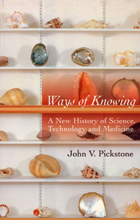 Ways of Knowing: A New History of Science, Technology, and Medicine
John V. Pickstone
University of Chicago Press, 2001 In Ways of Knowing, John V. Pickstone provides a new and accessible framework for understanding science, technology, and medicine (STM) in the West from the Renaissance to the present. Pickstone's approach has four key features. First, he synthesizes the long-term histories and philosophies of disciplines that are normally studied separately. Second, he dissects STM into specific ways of knowing—natural history, analysis, and experimentalism—with separate but interlinked elements. Third, he explores these ways of knowing as forms of work related to our various technologies for making, mending, and destroying. And finally, he relates scientific and technical knowledges to popular understandings and to politics.
Covering an incredibly wide range of subjects, from minerals and machines to patients and pharmaceuticals, and from experimental physics to genetic engineering, Pickstone's Ways of Knowing challenges the reader to reexamine traditional conceptualizations of the history, philosophy, and social studies of science, technology, and medicine.
 Ways of Lying: Dissimulation, Persecution and Conformity in Early Modern Europe
Perez Zagorin
Harvard University Press, 1990 The religious persecution and intellectual intolerance of the sixteenth and seventeenth centuries compelled many heterodox groups and thinkers to resort to misdirection, hidden meaning, secrecy, and deceit. In this highly unusual interpretation, Perez Zagorin traces the theory and practice of religious leaders, philosophers, intellectuals, and men of letters who used deception to cloak dissident beliefs.
Zagorin surveys some of the chief sources of early modern doctrines of dissimulation in the Bible and the works of theologians from Jerome andAugustine to Erasmus, Luther, and Calvin. Subjects covered include Nicodemism, the name given by Calvin to secret Protestants who concealed their faith behind a facade of conformity to Catholic worship; crypto-Judaism in Spain; and the hidden beliefs of English Catholics. Other topics include the Catholic doctrine of mental reservation; the place of dissimulation in English Protestant casuistry; occultism; and dissimulation of religious unbelief among philosophers and men of letters. In charting the widespread phenomenon of lying and deceit and by exploring its evolutions, Perez Zagorin has made an important contribution to the historiography of an intellectually roiling and perilous time. He adds a vital dimension to our understanding of the religious, intellectual, and cultural history of the epoch before the modern. Lacey Baldwin Smith finds this hook “an impressive and scholarly work of cultural synthesis that coins a fresh label for the sixteenth and seventeenth centuries: the age of dissimulation. Zagorin’s efforts to compare and contrast Catholic and Protestant styles of dissimulation and Nicodemism are important, casting a new perspective and focus on the religious and intellectual dissent of the era.”
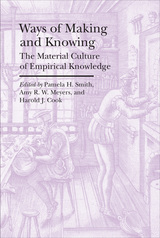 Ways of Making and Knowing: The Material Culture of Empirical Knowledge
Edited by Pamela H. Smith, Amy R. W. Meyers, and Harold J. Cook
Bard Graduate Center, 2017 Although craftspeople and artists often work with natural materials, the notion that making art can constitute a means of knowing nature is a novel one. This book, with contributions from historians of science, medicine, art, and material culture, shows that the histories of science and art are not simply histories of concepts or styles, but histories of the making and using of objects to understand the world. An examination of material practices makes it clear that the methods of the artisan represent a process of knowledge making that involves extensive experimentation and observation that parallel similar processes in the sciences. Ways of Making and Knowing offers a comprehensive and interdisciplinary history of the ways in which human beings have sought out, discovered, and preserved their own knowledge of the world around them; it has only been through material and human interaction with (and manipulation of) nature that we have come to understand it.
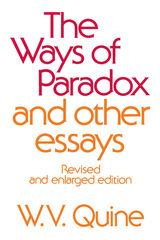 The Ways of Paradox and Other Essays: Revised and Enlarged Edition
W. V. Quine
Harvard University Press, 1976 This expanded edition of The Ways of Paradox includes papers that are among Professor W. V. Quine’s most important and influential, such as “Truth by Convention,” “Carnap and Logical Truth,” “On Carnap’s Views on Ontology,” “The Scope and Language of Science,” and “Posits and Reality.” Many of these essays deal with unresolved issues of central interest to philosophers today. About half of them are addressed to “a wider public than philosophers.” The remainder are somewhat more professional and technical. This new edition of The Ways of Paradox contains eight essays that appeared after publication of the first edition, and it retains the seminal essays that must be read by anyone who seeks to master Quine’s philosophy.
Quine has been characterized, in The New York Review of Books, as “the most distinguished American recruit to logical empiricism, probably the contemporary American philosopher most admired in the profession, and an original philosophical thinker of the first rank.” His “philosophical innovations add up to a coherent theory of knowledge which he has for the most part constructed single-handed.” In The Ways of Paradox new generations of readers will gain access to this philosophy.
Ways of Releasement: Writings on God, Eckhart, and Zen
Reiner Schürmann
Diaphanes, 2023 Never-before-published writing from a key twentieth-century philosopher.
In 1962, Reiner Schürmann began studying at the Dominican school of theology Le Saulchoir, outside Paris. That experience radically shaped his life and work, enabling him to begin to develop many of the ideas for which he would later be known: letting be, life without why, ontological anarchy, and the tragic double bind.
Ways of Releasement contains never-before-published material from Schürmann’s early period as well as a report Schürmann wrote about his encounter with Heidegger; a précis of his autobiographical novel, Origins; and translations and new editions of later groundbreaking essays. Ways of Releasement concludes with an extensive afterword setting Schürmann’s writings in the context of his thinking and life.
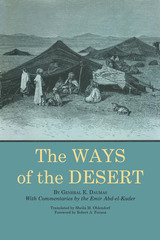 The Ways of the Desert
By General E. Daumas
University of Texas Press, 1971 The Ways of the Desert, translated from the French, offers an introduction to the North African Arab nomads—their way of life, customs, dress, and religion. The companion to this volume, The Horses of the Sahara, provides a detailed description and history of the great breeds of Arab horses. While part of this book is devoted to descriptions of the various animals that are both hunted and used for hunting, its appeal goes well beyond its attraction for those with a special interest in the lore of desert hunt and chase. General Daumas and his major collaborator-informant, the Emir Abd-el-Kader, together provide sensitive insights into the total culture of the North African desert people of the nineteenth century. Both spiritual and material aspects of desert life are encompassed in this work, which ranges from translations of Arab poetry to descriptions of the uses of the fat and remains of the ostrich. The patterns of conviction and conduct described form an important part of the rich cultural heritage of the modern Maghreb nations. The way of life described in this book is often presented from what comes very close to being an inside point of view. Occasionally Daumas feels obliged to disapprove of certain practices or beliefs or to criticize his Arab friends, but in large part his underlying sympathy for the Arab people permits his informants to speak clearly through his pen. General Melchior Joseph Eugene Daumas took part in the conquest of Algeria by France and, for his distinguished service, was named Director of the Bureau of Algerian Affairs in the French Ministry of War. During the campaigns and the occupation that followed, he studied and attempted to understand the native peoples with an objectivity and sympathy unusual among the colonialists of the period. He recorded a way of life that has changed much since the nineteenth century, and much of what he recorded has since been lost. His account, as well as being an important source for the historian and ethnographer, provides for the general reader a fascinating record of the vanishing ways of the desert.
Ways of the World: A History of the World's Roads and of the Vehicles that Used Them
Lay, M. G.
Rutgers University Press, 1999 This is the first comprehensive history of the world's roads, highways, bridges, and the people and vehicles that traverse them, from prehistoric times to the present. Encyclopedic in its scope, fascinating in its details, Ways of the World is a unique work for reference and browsing. Maxwell Lay considers the myriad aspects of roads and their users: the earliest pathways, the rise of wheeled vehicles and animals to pull them, the development of surfaced roads, the motives for road and bridge building, and the rise of cars and their influence on roads, cities, and society. The work is amply illustrated, well indexed and cross-referenced, and includes a chronology of road history and a full bibliography. It is indispensable for anyone interested in travel, history, geography, transportation, cars, or the history of technology.
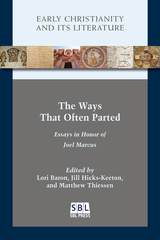 The Ways That Often Parted: Essays in Honor of Joel Marcus
Lori Baron
SBL Press, 2018 Focused studies on the historical interactions and formations of Judaism
and Christianity
This volume of essays, from an internationally renowned group of scholars, challenges popular ways of understanding how Judaism and Christianity came to be separate religions in antiquity. Essays in the volume reject the belief that there was one parting at an early point in time and contest the argument that there was no parting until a very late date. The resulting volume presents a complex account of the numerous ways partings occurred across the ancient Mediterranean spanning the first four centuries CE.
Features:
- Case studies that explore how Jews and Christians engaged in interaction, conflict, and collaboration
- Examinations of the gospels, Paul’s letters, the book of James, as well as rabbinic and noncanonical Christian texts
- New evidence for historical reconstructions of how Christianity came on the world scene
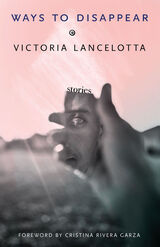 Ways to Disappear: Stories
Victoria Lancelotta, Foreword by Cristina Rivera Garza
University of Alabama Press, 2023 Winner of FC2’s Catherine Doctorow Prize in Innovative Fiction Some disappearances are chosen. Others are survived. The stories in Victoria Lancelotta’s Ways to Disappear excavate the unexamined places between dread and desire, promise and threat, where the body is both prison and salvation. Populated by the grieving and the exultant and those who see no difference between the two, by men and women who are only a little bit broken and boys and girls who can’t wait to be, by souls untethered, rootless, yet bound by blood and flesh, Lancelotta’s characters are driven by the irresistible need to be a bigger part of the worlds they each inhabit, by turns strange and commonplace. In language lush and jagged, never sentimental, these stories scrutinize the exhaustion and enchantment of the everyday: houses seething with resentment and devotion, cars dream-full and hurtling the children in them into a world they think they know but can’t imagine; front porches, back yards, luxury hotels, and truck stops. Lancelotta understands that sometimes people check their wounds not to see if they’ve healed, but to be sure they’re still there.
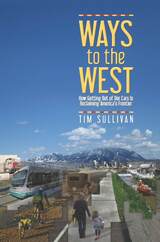 Ways to the West: How Getting Out of Our Cars Is Reclaiming America's Frontier
Tim Sullivan
Utah State University Press, 2015 In Ways to the West, Tim Sullivan embarks on a car-less road trip through the Intermountain West, exploring how the region is taking on what may be its greatest challenge: sustainable transportation. Combining personal travel narrative, historical research, and his professional expertise in urban planning, Sullivan takes a critical yet optimistic and often humorous look at how contemporary Western cities are making themselves more hospitable to a life less centered on the personal vehicle.
The modern West was built by the automobile, but so much driving has jeopardized the West’s mystic hold on the American future. At first, automobility heightened the things that made the West great, but love became dependence, and dependence became addiction. Via his travels by bicycle, bus, and train through Las Vegas, Phoenix, Denver, Boise, Salt Lake City, and Portland, Sullivan captures the modern transportation evolution taking place across the region and the resulting ways in which contemporary Western communities are reinterpreting classic American values like mobility, opportunity, adventure, and freedom.
Finding a West created, lost, and reclaimed, Ways to the West will be of great interest to anyone curious about sustainable transportation and the history, geography, and culture of the American West.
 THE WAYS WE TOUCH: POEMS
Miller Williams
University of Illinois Press, 1997 Includes
"Of History and Hope,"
the 1997 Presidential Inaugural Poem
When Miller Williams
read his Inaugural Poem, "Of History and Hope," to a world-wide
audience in January, his proverbial "fifteen minutes of fame"
lasted far less--somewhere between three and four minutes. That was long
enough to make a big impact on many. Said poet Paul Zimmer, one of the
millions in his viewing audience, "I came up out of my Lazy-Boy and
cheered loudly!"
Williams is an
American original whose poems have been praised for both the elegance
of their style and the simplicity of their language, for their wonderful
humor and genuine passion. The works in his newest collection, The
Ways We Touch, may be nostalgic or challenging, humorous or full of
moral fortitude; always Williams speaks with the kind of insight that
rises from wisdom and experience.
Praise for Williams's
earlier work:
"Miller
Williams is one of those writers whose books drag me snorkeling happily
along. Happy as a pig among truffles, I hurry to the next treasure."
-- William Stafford
"Most contemporary
poets might well go to him for lessons in the art of speaking plainly
in disciplined lines alive with emotional energy." -- X. J. Kennedy
"Better
than almost anything else being published." -- Donald Justice
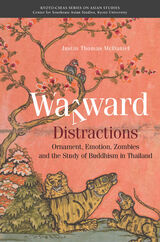 Wayward Distractions: Ornament, Emotion, Zombies and the Study of Buddhism in Thailand
Justin Thomas McDaniel
National University of Singapore Press, 2021 A collection of essays engaging with Buddhism in Thailand and the virtues of distraction and variety within the materialist turn in studies of religion.
In Thailand, Buddhism is deeply integrated into national institutions and ideologies, making it tempting to think of Buddhism in Thailand as a textual, institutional, cultural, and conceptual whole. At the same time, religious expression in the country reflects anything but a single order. Often gaudy, cacophonous, variegated, and jumbled, diversity and apparent contradiction abound. A more open engagement with Buddhism in Thailand requires a willingness to be distracted, to step away from received hierarchies and follow the intriguing detail in the ornate design, the odd textual reference, and to prefer "thin description" over a search for meaning. Justin McDaniel's well-known book-length writings in Buddhist and Theravada studies cannot be fully understood without taking into account his shorter writings, what he calls his wayward distractions. Collected together for the first time, these essays cover subjects ranging from ornamental art to marriage and emotion, the role of Hinduism, neglected gender and ethnic diversity, Buddhist inflections in contemporary art practice, and the boundaries between the living, dead, and undead. These writings will be of importance to students of Theravada and Thailand, of religion in Southeast Asia and more generally, of the materialist turn in studies of religion.
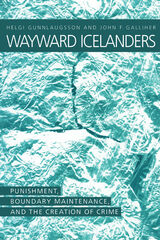 Wayward Icelanders: Punishment, Boundary Maintenance, And The
Helgi Gunnlaugsson
University of Wisconsin Press, 2000 Is Iceland, universally perceived as a peaceful, idyllic nation, being threatened by an inevitable flood of crime as it enters the global community? In recent decades the Icelandic state has taken serious steps to curb mounting crime, establishing a specialized drug court and an undercover drug police agency. Public opinion polls clearly demonstrate Icelanders’ growing concern that crime and drug use are on the rise. In their provocative new book, Wayward Icelanders, Helgi Gunnlaugsson and John Galliher offer another, more nuanced explanation for recent Icelandic attitudes toward crime, one that takes into account the unique history and culture of this relatively homogeneous and isolated nation.
Wayward Icelanders explores how the threat of crime has affected Icelanders’ collective self-identity, producing an ever greater need for social control. Historically Iceland has provided stiff sanctions for the use and abuse of mind-altering substances. Drunk driving has long been systematically punished, and even beer was prohibited for more than seventy years. The rate of conviction for these crimes is high, even in a democracy that prides itself on protecting civil liberties. Even more troubling, however, is the low rate of convictions for rape cases, which suggests that such crimes receive less attention from the state. Drawing on the classic work of Durkheim as well as Kai Erikson’s Wayward Puritans, Gunnlaugsson and Galliher demonstrate that an escalating war on crime can threaten freedom even in a small, affluent, and relatively nonviolent nation like Iceland with a long-standing commitment to democracy and individual rights.
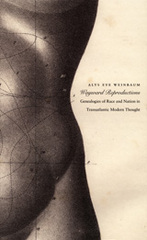 Wayward Reproductions: Genealogies of Race and Nation in Transatlantic Modern Thought
Alys Eve Weinbaum
Duke University Press, 2004 Wayward Reproductions breaks apart and transfigures prevailing understandings of the interconnection among ideologies of racism, nationalism, and imperialism. Alys Eve Weinbaum demonstrates how these ideologies were founded in large part on what she calls “the race/reproduction bind”––the notion that race is something that is biologically reproduced. In revealing the centrality of ideas about women’s reproductive capacity to modernity’s intellectual foundations, Weinbaum highlights the role that these ideas have played in naturalizing oppression. She argues that attention to how the race/reproduction bind is perpetuated across national and disciplinary boundaries is a necessary part of efforts to combat racism. Gracefully traversing a wide range of discourses––including literature, evolutionary theory, early anthropology, Marxism, feminism, and psychoanalysis––Weinbaum traces a genealogy of the race/reproduction bind within key intellectual formations of the late nineteenth and twentieth centuries. She examines two major theorists of genealogical thinking—Friedrich Nietzsche and Michel Foucault—and unearths the unacknowledged ways their formulations link race and reproduction. She explores notions of kinship and the replication of racial difference that run through Charlotte Perkins Gilman’s work; Marxist thinking based on Friedrich Engel’s The Origin of the Family; Charles Darwin’s theory of sexual selection; and Sigmund Freud’s early studies on hysteria. She also describes W. E. B. Du Bois’s efforts to transcend ideas about the reproduction of race that underwrite citizenship and belonging within the United States. In a coda, Weinbaum brings the foregoing analysis to bear on recent genomic and biotechnological innovations.
Wayward Threads
Robert Goldmann
Northwestern University Press, 1998 Wayward Threads is the story of Robert Goldmann's youth in Reinheim, a small German village; his experience in the early Nazi years in Frankfurt; his forced emigration in 1939; and his subsequent career in the United States, including service with the Voice of America, brushes with McCarthyism, and a brief tenure as head of the European bureau of the Anti-Defamation League. Goldmann also discusses his later experiences and encounters with his native Germany. Full of arresting vignettes, Wayward Threads stands out among other Holocaust memoirs for its strong American dimension.
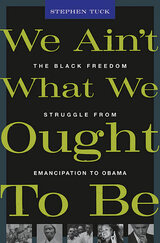 We Ain’t What We Ought To Be: The Black Freedom Struggle from Emancipation to Obama
Stephen Tuck
Harvard University Press, 2011 In this exciting revisionist history, Stephen Tuck traces the black freedom struggle in all its diversity, from the first years of freedom during the Civil War to President Obama’s inauguration. As it moves from popular culture to high politics, from the Deep South to New England, the West Coast, and abroad, Tuck weaves gripping stories of ordinary black people—as well as celebrated figures—into the sweep of racial protest and social change. The drama unfolds from an armed march of longshoremen in post–Civil War Baltimore to Booker T. Washington’s founding of Tuskegee Institute; from the race riots following Jack Johnson’s “fight of the century” to Rosa Parks’ refusal to move to the back of a Montgomery bus; and from the rise of hip hop to the journey of a black Louisiana grandmother to plead with the Tokyo directors of a multinational company to stop the dumping of toxic waste near her home.
We Ain’t What We Ought To Be rejects the traditional narrative that identifies the Southern non-violent civil rights movement as the focal point of the black freedom struggle. Instead, it explores the dynamic relationships between those seeking new freedoms and those looking to preserve racial hierarchies, and between grassroots activists and national leaders. As Tuck shows, strategies were ultimately contingent on the power of activists to protest amidst shifting economic and political circumstances in the U.S. and abroad. This book captures an extraordinary journey that speaks to all Americans—both past and future.
 We Ain't What We Was: Civil Rights in the New South
Frederick M. Wirt
Duke University Press, 1997 When officials of the U.S. Department of Justice came in 1961 to Panola County in the Mississippi delta, they found a closed society in which race relations had not altered significantly since Reconstruction. Much has changed, however, in Mississippi in the past three decades, as Frederick Wirt demonstrates in "We Ain’t What We Was," a remarkable look inside the New South. In this follow-up to his highly praised 1970 study of Panola County, The Politics of Southern Equality, Wirt shows how the implementation of civil rights law over the past quarter-century has altered racial reality that in turn altered white perceptions, and thus behavior and attitudes in a section of the country where segregation and prejudice had been most thoroughly entrenched.
Wirt uses multiple indicators—interviews with leaders, attitude tests of children, content analysis of newspapers, school records, and voting and job data—to record what has changed in the Deep South as a result of the 60s revolution in civil rights. Although racism continues to exist in Panola, Wirt maintains that the current generation of southerners is sharply distinguished from its predecessors, and he effectively documents the transformations in individuals and institutions. In a time of increasing popular challenges to the use of law in support of civil liberties, or the place of the federal government to effect necessary social change, this book testifies to the great changes, both public and personal, that were brought about by the strong implementation of civil rights law over thirty years ago. "We Ain’t What We Was" shows that adaptation to change was not overnight, not final, but gradual and always persistent.
 We All Feel: Understanding Animal Grief and Love
Barbara J. King
University of Chicago Press, 2013 From the time of our earliest childhood encounters with animals, we casually ascribe familiar emotions to them, though scientists have long cautioned against such anthropomorphizing. Recently, however, things have begun to shift in the other direction, and anthropologist Barbara J. King is at the forefront of that movement, arguing strenuously that we can—and should—attend to animal emotions. In the stories she tells here, King relays how some farm animals—horses, goats, chickens, and ducks—bond with others and engage in mourning when their friends die. Here, too, dolphins and whales exhibit striking signs of suffering over the loss of babies and companions: a mother dolphin will not give up her dead baby, and whales risk stranding themselves in small groups rather than abandon kin. As part of a larger web of life, death, love, and loss, King calls our attention to emotions—both our own and those of our companion species.
We All Got History: The Memory Books of Amos Webber
Nick Salvatore
University of Illinois Press, 2006 Lost for over a hundred years until their rediscovery by Nick Salvatore, Amos Webber’s “Thermometer Books” recorded six decades of the daily experiences of a black freeman in nineteenth-century Philadelphia and Worcester, Massachusetts. These diaries form the basis for Salvatore’s vital portrait of an everyday hero who struggled unrelentingly for his people in a land that still considered blacks to be less than human. In We All Got History, we see Amos Webber working as a janitor; rescuing fugitive slaves on the Underground Railroad; marching triumphantly into Richmond with the Fifth Massachusetts Cavalry; and active in the religious and fraternal organizations that became the cement of the African American community. What emerges from this moving history is not only a picture of Webber the man, but also of the vibrant African American culture that nurtured him.
We Alone Will Rule: Native Andean Politics in the Age of Insurgency
Sinclair Thomson
University of Wisconsin Press, 2003 In the same era as the American, French, and Haitian revolutions, a powerful anticolonial movement swept across the highland Andes in 1780–1781. Initially unified around Túpac Amaru, a descendant of Inka royalty from Cuzco, it reached its most radical and violent phase in the region of La Paz (present-day Bolivia) where Aymara-speaking Indians waged war against Europeans under the peasant commander Túpaj Katari. The great Andean insurrection has received scant attention by historians of the "Age of Revolution," but in this book Sinclair Thomson reveals the connections between ongoing local struggles over Indian community government and a larger anticolonial movement.
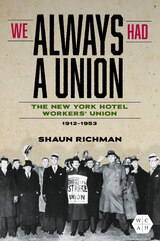 We Always Had a Union: The New York Hotel Workers' Union, 1912-1953
Shaun Richman
University of Illinois Press, 2025 One of New York City’s most powerful unions, the Hotel and Gaming Trades Council, AFL-CIO, represents almost 40,000 workers. Shaun Richman’s history places the labor organization within the context of American industrial and craft unionism and reveals how it came to influence politics and economic development in the city and beyond. From the start, New York’s organized hotel workers experimented with and adapted how they organized and governed members and related to other labor unions. Richman follows union fortunes from early IWW activity through the Communist-led affiliates of the American Federation of Labor in the 1920s and 1930s, the shaping of breakthrough negotiating strategies, and the postwar era. As Richman shows, workers adopted a radicalism and militancy seldom associated with an AFL organization while openly negotiating the Communist Party’s power and influence within the union, until the Party’s eclipse in the 1950s. An inspiring story of action and perseverance, We Always Had a Union profiles a foundational American labor union and offers lessons for today’s workers and organizers.
We Are a College at War: Women Working for Victory in World War II
Mary Weaks-Baxter, Christine Bruun, and Catherine Forslund
Southern Illinois University Press, 2010 We Are a College at War weaves together the individual World War II experiences of students and faculty at the all-female Rockford College (now Rockford University) in Rockford, Illinois, to draw a broader picture of the role American women and college students played during this defining period in U.S. history. It uses the Rockford community’s letters, speeches, newspaper stories, and personal recollections to demonstrate how American women during the Second World War claimed the right to be everywhere—in factories and other traditionally male workplaces, and even on the front lines—and links their efforts to the rise of feminism and the fight for women’s rights in the 1960s and 1970s.
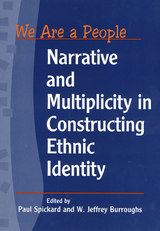 We Are A People
Paul Spickard
Temple University Press, 2000 As the twentieth century closes, ethnicity stands out as a powerful force for binding people together in a sense of shared origins and worldview. But this emphasis on a people's uniqueness can also develop into a distorted rationale for insularity, inter-ethnic animosity, or, as we have seen in this century, armed conflict. Ethnic identity clearly holds very real consequences for individuals and peoples, yet there is not much agreement on what exactly it is or how it is formed.
The growing recognition that ethnicity is not fixed and inherent, but elastic and constructed, fuels the essays in this collection. Regarding identity as a dynamic, on-going, formative and transformative process, We Are a People considers narrative -- the creation and maintenance of a common story -- as the keystone in building a sense of peoplehood. Myths of origin, triumph over adversity, migration, and so forth, chart a group's history, while continual additions to the larger narrative stress moving into the future as a people.
Still, there is more to our stories as individuals and groups. Most of us are aware that we take on different roles and project different aspects of ourselves depending on the situation. Some individuals who have inherited multiple group affiliations from their families view themselves not as this or that but all at once. So too with ethnic groups. The so-called hyphenated Americans are not the only people in the world to recognize or embrace their plurality. This relatively recent acknowledgment of multiplicity has potentially wide implications, destabilizing the limited (and limiting) categories inscribed in, for example, public policy and discourse on race relations.
We Are a People is a path-breaking volume, boldly illustrating how ethnic identity works in the real world.
We Are a People in This World: The Lakota Sioux and the Massacre at Wounded Knee
Conger Beasley Jr.
University of Arkansas Press, 1997 In this compelling book, the author alternately recounts the events and details of the 1890 massacre of the Lakota Sioux at Wounded Knee and his participation, one hundred years later, in the commemorative Big Foot Memorial Ride. The counterpoint and contrast between the two events produces a powerful effect; the oral accounts of the survivors of the slaughter are sometimes so brutal that the reader needs to be taken away, if only into the cold and wind of a century later.
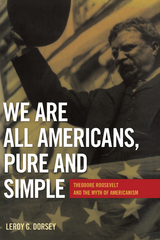 We Are All Americans, Pure and Simple: Theodore Roosevelt and the Myth of Americanism
Leroy G. Dorsey
University of Alabama Press, 2008 The turn of the 20th century represented one of the most chaotic periods in the nation's history, as immigrants, Native Americans, and African Americans struggled with their roles as Americans while white America feared their encroachments on national identity. This book examines Theodore Roosevelt’s public rhetoric—speeches, essays, and narrative histories—as he attempted to craft one people out of many. Leroy G. Dorsey observes that Roosevelt's solution to the problem appeared straightforward: everyone could become "Americans, pure and simple" if they embraced his notion of "Americanism." Roosevelt grounded his idea of Americanism in myth, particularly the frontier myth—a heroic combination of individual strength and character. When nonwhites and immigrants demonstrated these traits, they would become true Americans, earning an exalted status that they had heretofore been denied. Dorsey’s analysis illuminates how Roosevelt's rhetoric achieved a number of delicate, if problematic, balancing acts. Roosevelt gave his audiences the opportunity to accept a national identity that allowed "some" room for immigrants and nonwhites, while reinforcing their status as others, thereby reassuring white Americans of their superior place in the nation. Roosevelt’s belief in an ordered and unified nation did not overwhelm his private racist attitudes, Dorsey argues, but certainly competed with them. Despite his private sentiments, he recognized that racist beliefs and rhetoric were divisive and bad for the nation’s progress. The resulting message he chose to propagate was thus one of a rhetorical, if not literal, melting pot. By focusing on Roosevelt’s rhetorical constructions of national identity, as opposed to his personal exploits or his role as a policy maker, We Are All Americans offers new insights into Roosevelt’s use of public discourse to bind the nation together during one of the most polarized periods in its history.
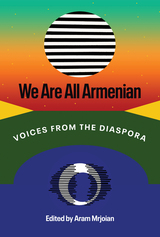 We Are All Armenian: Voices from the Diaspora
Edited by Aram Mrjoian
University of Texas Press, 2023 A collection of essays about Armenian identity and belonging in the diaspora.
In the century since the Armenian Genocide, Armenian survivors and their descendants have written of a vast range of experiences using storytelling and activism, two important aspects of Armenian culture. Wrestling with questions of home and self, diasporan Armenian writers bear the burden of repeatedly telling their history, as it remains widely erased and obfuscated. Telling this history requires a tangled balance of contextualizing the past and reporting on the present, of respecting a culture even while feeling lost within it. We Are All Armenian brings together established and emerging Armenian authors to reflect on the complications of Armenian ethnic identity today. These personal essays elevate diasporic voices that have been historically silenced inside and outside of their communities, including queer, multiracial, and multiethnic writers. The eighteen contributors to this contemporary anthology explore issues of displacement, assimilation, inheritance, and broader definitions of home. Through engaging creative nonfiction, many of them question what it is to be Armenian enough inside an often unacknowledged community.
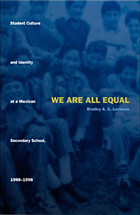 We Are All Equal: Student Culture and Identity at a Mexican Secondary School, 1988–1998
Bradley A. U. Levinson
Duke University Press, 2001 We Are All Equal is the first full-length ethnography of a Mexican secondary school available in English. Bradley A. U. Levinson observes student life at a provincial Mexican junior high, often drawing on poignant and illuminating interviews, to study how the the school’s powerful emphasis on equality, solidarity, and group unity dissuades the formation of polarized peer groups and affects students’ eventual life trajectories.
Exploring how students develop a cultural “game of equality” that enables them to identify—across typical class and social boundaries—with their peers, the school, and the nation, Levinson considers such issues as the organizational and discursive resources that students draw on to maintain this culture. He also engages cultural studies, media studies, and globalization theory to examine the impact of television, music, and homelife on the students and thereby better comprehend—and problematize—the educational project of the state. Finding that an ethic of solidarity is sometimes used to condemn students defined as different or uncooperative and that little attention is paid to accommodating the varied backgrounds of the students—including their connection to indigenous, peasant, or working class identities—Levinson reveals that their “schooled identity” often collapses in the context of migration to the United States or economic crisis in Mexico. Finally, he extends his study to trace whether the cultural game is reinforced or eroded after graduation as well as its influence relative to the forces of family, traditional gender roles, church, and global youth culture.
We Are All Equal will be of particular interest to educators, sociologists, Latin Americanists, and anthropologists.
 "We Are All Leaders": The Alternative Unionism of the Early 1930s
Edited by Staughton Lynd
University of Illinois Press, 1996 Contains the Bryant Spann Memorial Prize in Literature for 1997, an award-winning essay, "The Very Last Hurrah" by Eric Leif Davin
This collection of articles delves into the little-known community-based unionism of the 1930s. Worlds apart from bureaucratic business unions like the AFL-CIO, these organizations emerged from workers involved in many kinds of labor, from African American nutpickers in St. Louis to chemical and rubber workers in Akron, and from bootleg miners in Pennsylvania to tenant farmers in the Mississippi Delta. The contributors draw on eyewitness interviews, first-person narratives, trade union documents, and other primary sources to describe experimental forms of worker activism during the period. This alternative unionism was democratic, deeply rooted in mutual aid among workers in different crafts and work sites, and politically independent. The key to it was a value system based on egalitarianism. The cry, "We are all leaders!" resonated among rank-and-file activists. Their struggle, though often overlooked by historians, has much to teach us about union organizing today. Contributors: John Borsos, Eric Leif Davin, Elizabeth Faue, Rosemary Feurer, Janet Irons, Michael Kozura, Mark D. Naison, Peter Rachleff, and Stan Weir
 We Are All Multiculturalists Now
Nathan Glazer
Harvard University Press, 1997 The melting pot is no more. Where not very long ago we sought assimilation, we now pursue multiculturalism. Nowhere has this transformation been more evident than in the public schools, where a traditional Eurocentric curriculum has yielded to diversity--and, often, to confrontation and confusion. In a book that brings clarity and reason to this highly charged issue, Nathan Glazer explores these sweeping changes. He offers an incisive account of why we all--advocates and skeptics alike--have become multiculturalists, and what this means for national unity, civil society, and the education of our youth.
Focusing particularly on the impact in public schools, Glazer dissects the four issues uppermost in the minds of people on both sides of the multicultural fence: Whose "truth" do we recognize in the curriculum? Will an emphasis on ethnic roots undermine or strengthen our national unity in the face of international disorder? Will attention to social injustice, past and present, increase or decrease civil disharmony and strife? Does a multicultural curriculum enhance learning, by engaging students' interest and by raising students' self-esteem, or does it teach irrelevance at best and fantasy at worst?
Glazer argues cogently that multiculturalism arose from the failure of mainstream society to assimilate African Americans; anger and frustration at their continuing separation gave black Americans the impetus for rejecting traditions that excluded them. But, willingly or not, "we are all multiculturalists now," Glazer asserts, and his book gives us the clearest picture yet of what there is to know, to fear, and to ask of ourselves in this new identity.
 We Are All Sleeping with Our Sneakers On
Matthew Lippman
Four Way Books, 2024 We Are All Sleeping with Our Sneakers On showcases Matthew Lippman’s characteristic humor, strangeness, and honesty at the peak of his lyrical powers. These poems embrace mess as an inevitability of authentic living and human interconnection. Lippman gathers us into a bouquet. Picked from the garden and stems trimmed with the kitchen shears, maybe, but flowers all the same. In “The Big White American Segregation Machine,” Lippman narrates the moment when the partitions that maintain white cognitive dissonance collapse. He says to a friend, “Private education sucks,” but reflexive commiseration turns his gaze inward. “Then I realized I was a teacher. / Not that I was a teacher. / That I was a teacher in a private school.” He confronts, even as he does not solve, the way the collective delusion of the American Dream alienates us from sustainable living. “At some point in my life I wanted to be a firefighter,” Lippman reminisces. “So did the person next door and the stock broker / and the kid who punched the other kid on the playground. / I am sure of it.” Why such insistence? “It has to be true / because wanting to be a firefighter / is the only thing that keeps the world / from not being torn asunder / by flame, and ash, and an impossible, raging / heat.” In delineating the psychology of nostalgia, Lippman brilliantly reveals the fear of destruction and myopic sense of self-preservation that prevent us from leveraging goodness, from allowing combustion to clear the way for something better. “How does one change the culture, the mind culture, the heart culture?” he asks. “How does that happen? / More flowers? / More iced tea? / More ballet and modern dance? / Maybe more oboe and piano.” In the end, the strength of Lippman’s poems comes from the sincerity of their questioning and his willingness to muster an answer despite the world’s surplus of doubt and despair. “Hello kindness,” this poet tries again. “I am here and I want to hold your velvet hand / through the dark movie theater with the sticky, crunchy floors.” If that is all there is, it is mercifully enough.
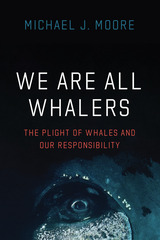 We Are All Whalers: The Plight of Whales and Our Responsibility
Michael J. Moore
University of Chicago Press, 2021 Relating his experiences caring for endangered whales, a veterinarian and marine scientist shows we can all share in the salvation of these imperiled animals. The image most of us have of whalers includes harpoons and intentional trauma. Yet eating commercially caught seafood leads to whales’ entanglement and slow death in rope and nets, and the global shipping routes that bring us readily available goods often lead to death by collision. We—all of us—are whalers, marine scientist and veterinarian Michael J. Moore contends. But we do not have to be. Drawing on over forty years of fieldwork with humpback, pilot, fin, and, in particular, North Atlantic right whales—a species whose population has declined more than 20 percent since 2017—Moore takes us with him as he performs whale necropsies on animals stranded on beaches, in his independent research alongside whalers using explosive harpoons, and as he tracks injured whales to deliver sedatives. The whales’ plight is a complex, confounding, and disturbing one. We learn of existing but poorly enforced conservation laws and of perennial (and often failed) efforts to balance the push for fisheries profit versus the protection of endangered species caught by accident. But despite these challenges, Moore’s tale is an optimistic one. He shows us how technologies for ropeless fishing and the acoustic tracking of whale migrations make a dramatic difference. And he looks ahead with hope as our growing understanding of these extraordinary creatures fuels an ever-stronger drive for change. For more information on Moore’s book and research, please visit his webpage at the Woods Hole Oceanographic Institution.
We Are All Zimbabweans Now
James Kilgore
Ohio University Press, 2011 We Are All Zimbabweans Now is a political thriller set in Zimbabwe in the hopeful, early days of Robert Mugabe’s rise to power in the late 1980s. When Ben Dabney, a Wisconsin graduate student, arrives in the country, he is enamored with Mugabe and the promises of his government’s model of racial reconciliation. But as Ben begins his research and delves more deeply into his hero’s life, he finds fatal flaws. Ultimately Ben reconsiders not only his understanding of Mugabe, but his own professional and personal life. James Kilgore brings an authentic voice to a work of youthful hope, disillusionment, and unsettling resolution.
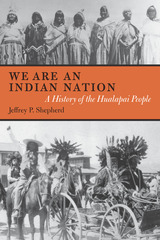 We are an Indian Nation: A History of the Hualapai People
Jeffrey P. Shepherd
University of Arizona Press, 2010 Though not as well known as the U.S. military campaigns against the Apache, the ethnic warfare conducted against indigenous people of the Colorado River basin was equally devastating. In less than twenty-five years after first encountering Anglos, the Hualapais had lost more than half their population and nearly all their land and found themselves consigned to a reservation.
This book focuses on the historical construction of the Hualapai Nation in the face of modern American colonialism. Drawing on archival research, interviews, and participant observation, Jeffrey Shepherd describes how thirteen bands of extended families known as The Pai confronted American colonialism and in the process recast themselves as a modern Indigenous nation.
Shepherd shows that Hualapai nation-building was a complex process shaped by band identities, competing visions of the past, creative reactions to modernity, and resistance to state power. He analyzes how the Hualapais transformed an externally imposed tribal identity through nationalist discourses of protecting aboriginal territory; and he examines how that discourse strengthened the Hualapais’ claim to land and water while simultaneously reifying a politicized version of their own history. Along the way, he sheds new light on familiar topics—Indian–white conflict, the creation of tribal government, wage labor, federal policy, and Native activism—by applying theories of race, space, historical memory, and decolonization.
Drawing on recent work in American Indian history and Native American studies, Shepherd shows how the Hualapai have strived to reclaim a distinct identity and culture in the face of ongoing colonialism. We Are an Indian Nation is grounded in Hualapai voices and agendas while simultaneously situating their history in the larger tapestry of Native peoples’ confrontations with colonialism and modernity.
 We Are Changed to Deer at the Broken Place
Kelly Weber
Tupelo Press, 2022 One could certainly say that Kelly Weber’s debut collection, We Are Changed to Deer at the Broken Place, depicts a non-binary experience that does not receive nearly enough representation in the literary landscape. While such an assertion would be factual, this kind of reading would underestimate Weber’s poetic gifts and the full range of the philosophical implications for her work. Weber writes, “What pulls a woman like me / out here alone, they want to know?” As she teases out possible answers to this question, Weber reveals—with remarkable lyricism and grace—the danger, richness, and multiplicity housed within solitary experience and within the individual subject. Adriana Cavererro, the famed scholar of vocal expression, once noted that thought itself is a collective endeavor, made possible by a shared cultural imagination. Weber reveals self as world, self as community in poems that situate an inherited tradition in conversation with postmodern innovation and undertheorized, urgently important concepts of identity. This is an unforgettable first book.
 We Are Civic Media
Sangita Shresthova, Dan Sinker, Pratik Nyaupane, Sophie Madej, and Colin Maclay
Northwestern University Press, 2025 A discipline-crossing introduction to civic media via accounts from grassroots practitioners
“Civic media” is the use of contemporary technologies to connect communities, inspire action, build civic capacity, and sustain social change efforts. Written by artists, creators, storytellers, organizers, and others working at the intersections of technology, social justice, and culture, this book summons civic media through the lived experiences of its contributors.
Latoya Peterson delves into the therapeutic power of gaming; Akilah Hughes discusses identity and community through the lens of her campaign to change her high school's racist mascot; and Tyree Boyd-Pates emphasizes the potential power of museum curation to challenge power dynamics and bridge digital and physical realms. Through the experiences of these grassroots practitioners and many others, We Are Civic Media offers accessible insights for those interested in understanding, respecting, and practicing civic media.
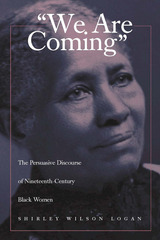 We Are Coming: The Persuasive Discourse of Nineteenth-Century Black Women
Shirley Wilson Logan
Southern Illinois University Press, 1999 Shirley Wilson Logan analyzes the distinctive rhetorical features in the persuasive discourse of nineteenth-century black women, concentrating on the public discourse of club and church women from 1880 until 1900. Logan develops each chapter in this illustrated study around a feature of public address as best exemplified in the oratory of a particular woman speaker of the era. She analyzes not only speeches but also editorials, essays, and letters. Logan first focuses on the prophetic oratory of Maria Stewart, the first American-born black woman to speak publicly. Turning to Frances Harper, she considers speeches that argue for common interests between divergent communities. And she demonstrates that central to the antilynching rhetoric of Ida Wells is the concept of "presence," or the tactic of enhancing certain selected elements of the presentation. In her discussion of Fannie Barrier Williams and Anna Cooper, Logan shows that when speaking to white club women and black clergymen, both Williams and Cooper employ what Kenneth Burke called identification. To analyze the rhetoric of Victoria Matthews, she applies Carolyn Miller's modification of Lloyd Bitzer's concept of the rhetorical situation. Logan also examines the discourse of women associated with the black Baptist women's movement and those participating in college-affiliated conferences. The book includes an appendix with little-known speeches and essays by Anna Julia Cooper, Selena Sloan Butler, Lucy Wilmot Smith, Mary V. Cook, Adella Hunt Logan, Victoria Earle Matthews, Lucy C. Laney, and Georgia Swift King.
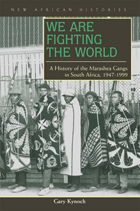 We Are Fighting the World: A History of the Marashea Gangs in South Africa, 1947–1999
Gary Kynoch
Ohio University Press, 2005 Since the late 1940s, a violent African criminal society known as the Marashea has operated in and around South Africa’s gold mining areas. With thousands of members involved in drug smuggling, extortion, and kidnapping, the Marashea was more influential in the day-to-day lives of many black South Africans under apartheid than were agents of the state. These gangs remain active in South Africa. In We Are Fighting the World: A History of the Marashea Gangs in South Africa, 1947–1999, Gary Kynoch points to the combination of coercive force and administrative weakness that characterized the apartheid state. As long as crime and violence were contained within black townships and did not threaten adjacent white areas, township residents were largely left to fend for themselves. The Marashea’s ability to prosper during the apartheid era and its involvement in political conflict led directly to the violent crime epidemic that today plagues South Africa. Highly readable and solidly researched, We Are Fighting the World is critical to an understanding of South African society, past and present. This pioneering study challenges previous social history research on resistance, ethnicity, urban spaces, and gender in South Africa. Kynoch’s interviews with many current and former gang members give We Are Fighting the World an energy and a realism that are unparalleled in any other published work on gang violence in southern Africa.
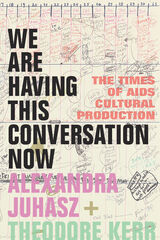 We Are Having This Conversation Now: The Times of AIDS Cultural Production
Alexandra Juhasz and Theodore Kerr
Duke University Press, 2022 We Are Having This Conversation Now offers a history, present, and future of AIDS through thirteen short conversations between Alexandra Juhasz and Theodore Kerr, scholars deeply embedded in HIV responses. They establish multiple timelines of the epidemic, offering six foundational periodizations of AIDS culture, tracing how attention to the crisis has waxed and waned from the 1980s to the present. They begin the book with a 1990 educational video produced by a Black health collective, using it to consider organizing intersectionally, theories of videotape, empowerment movements, and memorialization. This video is one of many powerful yet overlooked objects that the pair focus on through conversation to understand HIV across time. Along the way, they share their own artwork, activism, and stories of the epidemic. Their conversations illuminate the vital role personal experience, community, cultural production, and connection play in the creation of AIDS-related knowledge, archives, and social change. Throughout, Juhasz and Kerr invite readers to reflect and find ways to engage in their own AIDS-related culture and conversation.
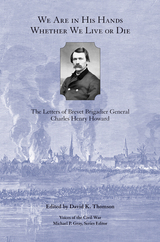 We Are in His Hands Whether We Live or Die: The Letters of Brevet Brigadier General Charles Henry Howard
David K. Thomson
University of Tennessee Press, 2013 Many soldiers who served in the American Civil War found solace in their faith during the most trying times of the war. But few soldiers took such a providential view of life and the Civil War as Charles Henry Howard. Born in a small town in Maine, Howard came from a family with a distinguished history of soldiering: his grandfather was a Revolutionary War veteran and his brother, the older and more well-known Oliver Otis Howard, attended West Point and rose to command an army in the Civil War. Following in his brother’s footsteps, Charles Henry Howard graduated from Bowdoin College in 1859. Following graduation, Charles visited his older brother at West Point during the tumultuous election of 1860. While at West Point, Howard saw the tensions between Northern and Southern cadets escalate as he weighed his options for a military or theological career. The choice was made for him on April 12, 1861, with the firing on Fort Sumter.
Responding to his brother’s plea for the sons of Maine to join the Union cause, Charles found himself a noncommissioned officer fighting in the disastrous Battle of First Bull Run. All told, Howard fought in several major battles of the Eastern Theater, including Antietam, Fredericksburg, Chancellorsville, and Gettysburg, and went on to participate in various military actions in the Western Theater including Sherman’s bloody Atlanta Campaign. He was wounded twice, first at the Battle of Fair Oaks and again at Fredericksburg. Yet, despite facing the worst horrors of war, Howard rarely wavered in his faith and rose steadily in rank throughout the conflict. By war’s end, he was a brevet brigadier general in command of the 128th U.S. Colored Troop Regiment.
Howard’s letters cover a wide-ranging period, from 1852 to 1908. His concern for his family is typical of a Civil War soldier, but his exceptionally firm reliance on divine providence is what makes these letters an extraordinary window into the mind of a Civil War officer. Howard’s grounded faith was often tested by the viciousness of war, and as a result his letters are rife with stirring confessions and his emotional grappling with the harsh realities he faced. Howard’s letters expose the greater theological and metaphysical dilemmas of the war faced by so many on both sides.
 We Are in This Dance Together: Gender, Power, and Globalization at a Mexican Garment Firm
Plankey-Videla, Nancy
Rutgers University Press, 2012 Changes in the global economy have real and contradictory outcomes for the everyday lives of women workers. In 2001, Nancy Plankey-Videla had a rare opportunity to witness these effects firsthand. Having secured access to one of Latin America's top producers of high-end men's suits in Mexico for participant-observer research, she labored as a machine operator for nine months on a shop floor made up, mostly, of women. The firm had recently transformed itself from traditional assembly techniques, to lean, cutting-edge, Japanese-style production methods. Lured initially into the firm by way of increased wages and benefits, workers had helped shoulder the company's increasing debts. When the company's plan for successful expansion went awry and it reneged on promises it had made to the workforce, women workers responded by walking out on strike. Building upon in-depth interviews with over sixty workers, managers, and policy makers, Plankey-Videla documents and analyzes events leading up to the female-led factory strike and its aftermath—including harassment from managers, corrupt union officials and labor authorities, and violent governor-sanctioned police actions. We Are in This Dance Together illustrates how the women's shared identity as workers and mothers—deserving of dignity, respect, and a living wage—became the basis for radicalization and led to further civic organizing against the state, the company, and the corrupt union to demand justice.
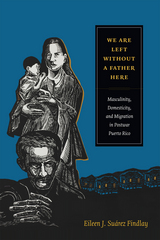 We Are Left without a Father Here: Masculinity, Domesticity, and Migration in Postwar Puerto Rico
Eileen J. Suárez Findlay
Duke University Press, 2015 We Are Left without a Father Here is a transnational history of working people's struggles and a gendered analysis of populism and colonialism in mid-twentieth-century Puerto Rico. At its core are the thousands of agricultural workers who, at the behest of the Puerto Rican government, migrated to Michigan in 1950 to work in the state's sugar beet fields. The men expected to earn enough income to finally become successful breadwinners and fathers. To their dismay, the men encountered abysmal working conditions and pay. The migrant workers in Michigan and their wives in Puerto Rico soon exploded in protest. Chronicling the protests, the surprising alliances that they created, and the Puerto Rican government's response, Eileen J. Suárez Findlay explains that notions of fatherhood and domesticity were central to Puerto Rican populist politics. Patriarchal ideals shaped citizens' understandings of themselves, their relationship to Puerto Rican leaders and the state, as well as the meanings they ascribed to U.S. colonialism. Findlay argues that the motivations and strategies for transnational labor migrations, colonial policies, and worker solidarities are all deeply gendered.
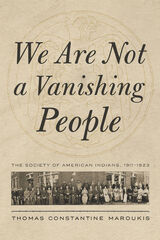 We Are Not a Vanishing People: The Society of American Indians, 1911–1923
Thomas Constantine Maroukis
University of Arizona Press, 2021 In 1911, a group of Native American intellectuals and activists joined together to establish the Society of American Indians (SAI), an organization by Indians for Indians. It was the first such nationwide organization dedicated to reform. They used a strategy of protest and activism that carried into the rest of the twentieth century. Some of the most prominent members included Charles A. Eastman (Dakota), Arthur Parker (Seneca), Carlos Montezuma (Yavapai), Zitkala-Ša (Yankton Sioux), and Sherman Coolidge (Peoria). They fought for U.S. citizenship and quality education. They believed these tools would allow Indigenous people to function in the modern world without surrendering one’s identity. They believed this could be accomplished by removing government controls over Indian life.
Historian Thomas Constantine Maroukis discusses the goals, strategies, successes, and failures of the Indigenous intellectuals who came together to form the SAI. They engaged in lobbying, producing publications, informing the media, hundreds of speaking engagements, and annual conferences to argue for reform. Unfortunately, the forces of this era were against reforming federal policies: The group faced racism, a steady stream of negative stereotyping as a so-called vanishing race, and an indifferent federal bureaucracy. They were also beset by internal struggles, which weakened the organization.
This work sheds new light on the origins of modern protest in the twentieth century, and it shows how the intellectuals and activists associated with the SAI were able to bring Indian issues before the American public, challenging stereotypes and the “vanishing people” trope. Maroukis argues that that the SAI was not an assimilationist organization; they were political activists trying to free Indians from government wardship while maintaining their cultural heritage.
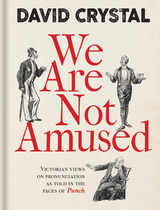 We Are Not Amused: Victorian Views on Pronunciation as Told in the Pages of Punch
David Crystal
Bodleian Library Publishing, 2017 Have you ever cringed while hearing someone mispronounce a word—or, worse, been tripped up by a wily silent letter yourself? Consider yourself lucky that you do not live in Victorian England, when the way you pronounced a word was seen as a sometimes-damning index of who you were and how you should be treated. No wonder then that jokes about English usage provided one of Punch magazine’s most fruitful veins of humor for sixty years, from its first issue in 1841 to 1900.
For We Are Not Amused, renowned English-language expert David Crystal has explored the most common pronunciation-related controversies during the reign of Queen Victoria and brought together the cartoons and articles that poked fun at them, adding insightful commentary on the context of the times. The collection brings to light a society where class distinctions ruled. Crystal explains why people felt so strongly about accents and identifies which accents were the main sources of jokes, from the dropped h’s of the Cockney working class to the upper-class tendency to drop the final g in words like “huntin’” and “fishin’.”
In this fascinating and highly entertaining book, Crystal shows that outrage over proper pronunciation is nothing new—our feelings today have their origins in the ways our Victorian predecessors thought about the subject.
We Are Not Babysitters: Family Childcare Providers Redefine Work and Care
Tuominen, Mary
Rutgers University Press, 2003 Using in-depth interviews with child care providers, Mary C. Tuominen explores the social, political, and economic forces and processes that draw women into the work of family child care. In We Are Not Babysitters, the lives and work of twenty family child care providers of diverse race, ethnicity, immigrant status, and social class serve as a window into understanding the changing meanings of community, family, work, and care. Their stories require us to rethink the social and economic value of paid child care providers and their work.
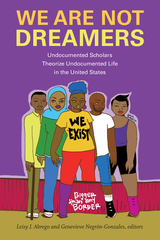 We Are Not Dreamers: Undocumented Scholars Theorize Undocumented Life in the United States
Leisy J. Abrego and Genevieve Negrón-Gonzales, editors
Duke University Press, 2020 The widely recognized “Dreamer narrative” celebrates the educational and economic achievements of undocumented youth to justify a path to citizenship. While a well-intentioned, strategic tactic to garner political support of undocumented youth, it has promoted the idea that access to citizenship and rights should be granted only to a select group of “deserving” immigrants. The contributors to We Are Not Dreamers—themselves currently or formerly undocumented—poignantly counter the Dreamer narrative by grappling with the nuances of undocumented life in this country. Theorizing those excluded from the Dreamer category—academically struggling students, transgender activists, and queer undocumented parents—the contributors call for an expansive articulation of immigrant rights and justice that recognizes the full humanity of undocumented immigrants while granting full and unconditional rights. Illuminating how various institutions reproduce and benefit from exclusionary narratives, this volume articulates the dangers of the Dreamer narrative and envisions a different way forward.
Contributors. Leisy J. Abrego, Gabrielle Cabrera, Gabriela Garcia Cruz, Lucía León, Katy Joseline Maldonado Dominguez, Grecia Mondragón, Gabriela Monico, Genevieve Negrón-Gonzales, Maria Liliana Ramirez, Joel Sati, Audrey Silvestre, Carolina Valdivia
 We Are Not South African: Mediating National Identity in a Postcolonial and Postapartheid State
Rachel Lara van der Merwe
Rutgers University Press, 2026 We Are Not South African explores how national identity functions as a colonial tool of communication, control, and power. Author Rachel Lara van der Merwe examines how humans and the planet are integrally shaped by the idea of the nation, and speculates on how different sociopolitical imaginaries, instead of the nation, could inform ways of being-together in the world. Linking national identity to colonialism, the book broadens the idea of the nation to include its impact on all forms of life, human and more-than-human. Van der Merwe builds her argument on three central observations: that nations are made up of conflicting and fractured imaginaries, not unified, cohesive ones; the nation is divisive by nature, tracing back to its colonial origins; and the nation, along with the state, exploits both humans and more-than-humans. In order to build a more just and sustainable planetary society, she argues, liberation from such colonial formations is vital. In response, the book asks: How could we reimagine how we organize our societies through values of relationality and mutual care rather than rigid borders? What sociopolitical imaginaries do we need, or already possess, that might inform new configurations of community?
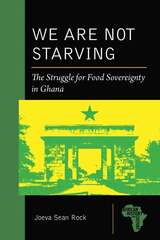 We Are Not Starving: The Struggle for Food Sovereignty in Ghana
Joeva Sean Rock
Michigan State University Press, 2022 This critical text is a timely ethnography of how global powers, local resistance, and capital flows are shaping contemporary African foodways. Ghana was one of the first countries targeted by a group of US donors and agribusiness corporations that funded an ambitious plan to develop genetically modified (GM) crops for African farmers. The collective believed that GM crops would help farmers increase their yields and help spark a “new” Green Revolution on the continent. Soon after the project began in Ghana, a nationwide food sovereignty movement emerged in opposition to GM crops. Today, in spite of impressive efforts and investments by proponents, only two GM crops remain in the pipeline. Why, after years of preparation, millions of dollars of funding, and multiple policy reforms, did these megaprojects effectively come to a halt? One of the first ethnographies to take on the question of GM crops in the African context, We Are Not Starving: The Struggle for Food Sovereignty in Ghana blends archival analysis, interviews, and participant observation with Ghanaian scientists, farmers, activists, and officials. Ultimately the text aims to illuminate why GM crops have animated the country and to highlight how their introduction has opened an opportunity to air grievances about the systematic de-valuing and exploitation of African land, labor, and knowledge that have been centuries in the making.
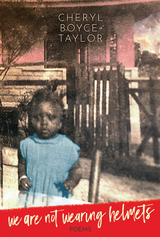 We Are Not Wearing Helmets: Poems
Cheryl Boyce-Taylor
Northwestern University Press, 2022 We Are Not Wearing Helmets is a collection of political love poems rendered through the eyes of Cheryl Boyce‑Taylor, an immigrant living in New York City. For many women of color, aging in America means experiencing a lack of proper medical treatment, inhumane living conditions, poor nutrition, and often isolation. Many seniors feel thrown away, useless, and vulnerable. These poems challenge the injustices of ageism, racism, and oppression with rage, forgiveness, honor, and endurance. During these rough political times, they are salve and balm.
Born in Trinidad and having grown up in Queens, Boyce‑Taylor creates a framework for her own experience out of the life experiences and work of beloved Black women in history. She salutes the women who have lifted her, including Audre Lorde, Fannie Lou Hamer, Ntozake Shange, and Winnie Mandela, as well as her mother, Eugenia Boyce, and her beloved daughter‑in‑law, Deisha Head Taylor.
The poems in this collection are unapologetic, fierce, and confrontational while remaining caring and intimate. They stand strong in the face of adversity and boldly demand what is owed while still honoring and cherishing what is loved.
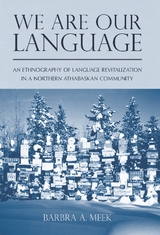 We Are Our Language: An Ethnography of Language Revitalization in a Northern Athabaskan Community
Barbra A. Meek
University of Arizona Press, 2012 For many communities around the world, the revitalization or at least the preservation of an indigenous language is a pressing concern. Understanding the issue involves far more than compiling simple usage statistics or documenting the grammar of a tongue—it requires examining the social practices and philosophies that affect indigenous language survival.
In presenting the case of Kaska, an endangered language in an Athabascan community in the Yukon, Barbra A. Meek asserts that language revitalization requires more than just linguistic rehabilitation; it demands a social transformation. The process must mend rips and tears in the social fabric of the language community that result from an enduring colonial history focused on termination. These “disjunctures” include government policies conflicting with community goals, widely varying teaching methods and generational viewpoints, and even clashing ideologies within the language community.
This book provides a detailed investigation of language revitalization based on more than two years of active participation in local language renewal efforts. Each chapter focuses on a different dimension, such as spelling and expertise, conversation and social status, family practices, and bureaucratic involvement in local language choices. Each situation illustrates the balance between the desire for linguistic continuity and the reality of disruption.
We Are Our Language reveals the subtle ways in which different conceptions and practices—historical, material, and interactional—can variably affect the state of an indigenous language, and it offers a critical step toward redefining success and achieving revitalization.
We are Starved
Joshua Kryah
University Press of Colorado, 2011 "Joshua Kryah is redefining what it means to write spiritual poetry. This is not another book about longings for the spiritual; this is a book of offerings to the spiritual. These poems answer the plea of Yeats's spirits ('We are starved') and give them what they crave, depicting the particulars of human appetite and the way each 'peculiar and appalling hunger' unfolds. The scope of these poems is dizzying; they echo and glitter and sear as they, against all odds, give us a'world [that] is/suddener than any idea about the world.' We Are Starved is unabashed and unflinching, and it is deeply, exquisitely satisfying."
-Mary Szybist, author of Granted
Mountain West Poetry Series
Published by the Center for Literary Publishing at Colorado State University
 We Are Still in the Fort: Poems
Muyaka bin Haji al-Ghassaniy; Translated from the Swahili by Richard Prins
Vanderbilt University Press, 2026 We Are Still in the Fort is a curated selection of about seventy poems by Muyaka bin Haji al-Ghassaniy divided into three sections spanning the quotidian, the amorous, and the political. The first part “I Swipe Their String of Fish: Poems of Mombasan Society” features his often satirical commentary on daily life in Mombasa. The second part “Take Your Misery With You: Poems of Love and Marriage” focuses on his psychologically sensitive observations on the volatility of love, marriage, and illicit affairs. The last part “We Are Still in the Fort: Poems of War and State” includes epigrammatic critiques of local political leaders and a series of anti-imperialist poems defending Mombasa's independence against the invading Omani Empire. The volume also features contextual materials on Muyaka and the context of Swahili poetry, a translator's note, and introductions for each of the three sections.
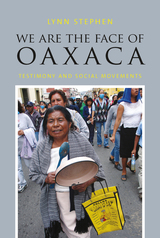 We Are the Face of Oaxaca: Testimony and Social Movements
Lynn Stephen
Duke University Press, 2013 A massive uprising against the Mexican state of Oaxaca began with the emergence of the Popular Assembly of the Peoples of Oaxaca (APPO) in June 2006. A coalition of more than 300 organizations, APPO disrupted the functions of Oaxaca's government for six months. It began to develop an inclusive and participatory political vision for the state. Testimonials were broadcast on radio and television stations appropriated by APPO, shared at public demonstrations, debated in homes and in the streets, and disseminated around the world via the Internet. The movement was met with violent repression. Participants were imprisoned, tortured, and even killed. Lynn Stephen emphasizes the crucial role of testimony in human rights work, indigenous cultural history, community and indigenous radio, and women's articulation of their rights to speak and be heard. She also explores transborder support for APPO, particularly among Oaxacan immigrants in Los Angeles. The book is supplemented by a website featuring video testimonials, pictures, documents, and a timeline of key events.
 We Are the Leaders We Have Been Looking For
Eddie S. Glaude Jr.
Harvard University Press, 2024 From the author of the New York Times bestseller Begin Again, a politically astute, lyrical meditation on how ordinary people can shake off their reliance on a small group of professional politicians and assume responsibility for what it takes to achieve a more just and perfect democracy.
Preeminent scholar and New York Times bestselling author Eddie Glaude makes the case that the hard work of becoming a better person should be a critical feature of Black politics. Through virtuoso interpretations of Martin Luther King, Malcolm X, and Ella Baker, Glaude shows how we can become the heroes that our democracy desperately needs.
Based on the Du Bois Lectures delivered at Harvard University, We Are the Leaders We Have Been Looking For begins by recalling Glaude’s unease with the Obama years. The excitement around the Obama presidency, Glaude argues, constrained our politics as we turned to yet another prophet-like figure who overwhelmed citizen voices. Weaving together a personal story of political evolution with the writings of Ralph Waldo Emerson, John Dewey, Toni Morrison, James Baldwin, and Ralph Ellison, Glaude encourages us to address imaginatively the challenges of our day in voices uniquely our own.
With passion and philosophical insight, Glaude offers a powerful reminder that if American democracy is to survive, we must step out from under the shadows of giants and build a society that derives its strength from the pews, not the pulpit.
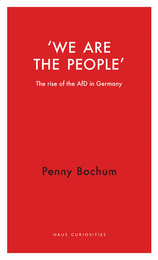 We are the People: The Rise of the AfD in Germany
Penny Bochum
Haus Publishing, 2020 Recent years have seen a surge of populism across the Western world, exposing the vulnerabilities of liberal democracy and driving the international political agenda to the right. In Germany in 2017 the recently founded far-right populist party—the Alternative for Germany (AfD)—swept into the Bundestag, claiming to be the voice of the people against a corrupt liberal elite and overturning the delicate postwar political consensus in Germany.
We are the People analyzes the sudden growth and radicalization of the AfD, from its Euroskeptic beginnings in 2013 to its increasing extremism. Penny Bochum shows us how the leaders’ use of inflammatory, xenophobic, and even Nazi-era language mirrors that of emerging far-right forces across much of the Western world. At the same time, through a lucid examination of the group’s ideology, Bochum shows how their brand of populism is distinct and based on German experiences and history.
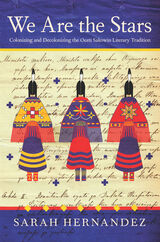 We Are the Stars: Colonizing and Decolonizing the Oceti Sakowin Literary Tradition
Sarah Hernandez
University of Arizona Press, 2023 After centuries of colonization, this important new work recovers the literary record of Oceti Sakowin (historically known to some as the Sioux Nation) women, who served as their tribes’ traditional culture keepers and culture bearers. In so doing, it furthers discussions about settler colonialism, literature, nationalism, and gender.
Women and land form the core themes of the book, which brings tribal and settler colonial narratives into comparative analysis. Divided into two parts, the first section of the work explores how settler colonizers used the printing press and boarding schools to displace Oceti Sakowin women as traditional culture keepers and culture bearers with the goal of internally and externally colonizing the Dakota, Nakota, and Lakota nations. The second section focuses on decolonization and explores how contemporary Oceti Sakowin writers and scholars have started to reclaim Dakota, Nakota, and Lakota literatures to decolonize and heal their families, communities, and nations.
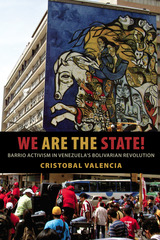 We Are the State!: Barrio Activism in Venezuela’s Bolivarian Revolution
Cristobal Valencia
University of Arizona Press, 2015 Chavistas are the local leaders and activists in Venezuela’s Bolivarian Revolution, working to establish democracy through government-sponsored social missions, community self-governance, and popular collectives. We Are the State! tells the story of their grassroots activism. In perspectives gleaned from participant observation with barrio residents in workplaces, communal kitchens, city-wide forums, and grassroots meetings and assemblies, as well as family and recreational events, anthropologist Cristobal Valencia vividly recounts tensions between activists, local officials, and the wealthy opposition.
The author offers an anthropological analysis of the state, social movements, and democracy as lived experiences of the poor, gendered, and racialized residents of two parishes in Caracas, Venezuela, and Afro-Venezuelan communities nearby. Ethnographic research reveals the shift in relationships of power and the evolving political practices among the Chavistas, the Chávez government, and the opposition. Examining the subjective experiences of barrio residents in everyday processes of state formation, this book provides a new perspective on the Chavistas, arguing that they are a broad-based social movement and driving force behind a revolution struggling to transfer state power to organized civil society.
Through his intense engagement with the constantly changing social, political, and economic dynamics, Valencia dramatically challenges top-down understandings of the state and power in Venezuela. He shows the unequal relationships between sectors of civil society, and he shows state formation as a process enmeshed in the struggles for social justice, demonstrating that the state is a sociopolitical entity that acts through civil society, rather than above it.
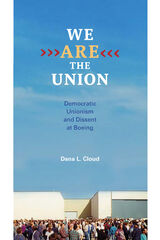 We Are the Union: Democratic Unionism and Dissent at Boeing
Dana L. Cloud
University of Illinois Press, 2011 In this extraordinary tale of union democracy, Dana L. Cloud engages union reformers at Boeing in Wichita and Seattle to reveal how ordinary workers attempted to take command of their futures by chipping away at the cozy partnership between union leadership and corporate management. Taking readers into the central dilemma of having to fight an institution while simultaneously using it as a bastion of basic self-defense, We Are the Union offers a sophisticated exploration of the structural opportunities and balance of forces at play in modern unions told through a highly relevant case study. Focusing on the 1995 strike at Boeing, Cloud renders a multi-layered account of the battles between company and the union and within the union led by Unionists for Democratic Change and two other dissident groups. She gives voice to the company's claims of the hardships of competitiveness and the entrenched union leaders' calls for concessions in the name of job security, alongside the democratic union reformers' fight for a rank-and-file upsurge against both the company and the union leaders.
We Are the Union is grounded in on-site research and interviews and focuses on the efforts by Unionists for Democratic Change to reform unions from within. Incorporating theory and methods from the fields of organizational communication as well as labor studies, Cloud methodically uncovers and analyzes the goals, strategies, and dilemmas of the dissidents who, while wanting to uphold the ideas and ideals of the union, took up the gauntlet to make it more responsive to workers and less conciliatory toward management, especially in times of economic stress or crisis. Cloud calls for a revival of militant unionism as a response to union leaders' embracing of management and training programs that put workers in the same camp as management, arguing that reform groups should look to the emergence of powerful industrial unions in the United States for guidance on revolutionizing existing institutions and building new ones that truly accommodate workers' needs.
Drawing from communication studies, labor history, and oral history and including a chapter co-written with Boeing worker Keith Thomas, We Are the Union contextualizes what happened at Boeing as an exemplar of agency that speaks both to the past and the future.
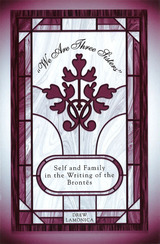 We Are Three Sisters: Self and Family in the Writing of the Brontës
Drew Lamonica
University of Missouri Press, 2003
While biographers have widely acknowledged the importance of family relationships to Charlotte, Emily, and Anne Brontë and to their writing processes, literary critics have yet to give extensive consideration to the family as a subject of the writing itself. In “We Are Three Sisters,” Drew Lamonica focuses on the role of families in the Brontës’ fictions of personal development, exploring the ways in which their writings recognize the family as a defining community for selfhood.
Drawing on extensive primary sources, including works by Sarah Ellis, Sarah Lewis, Ann Richelieu Lamb, Harriet Martineau, Thomas Carlyle, Charles Dickens, and Elizabeth Gaskell, Lamonica examines the dialogic relationship between the Brontës’ novels and a mid-Victorian domestic ideology that held the family to be the principal nurturer of subjectivity. Using a sociohistorical framework, “We Are Three Sisters” shows that the Brontës’ novels display a heightened awareness of contemporary female experience and the complex problems of securing a valued sense of selfhood not wholly dependent on family ties.
The opening chapters discuss the mid-Victorian “culture of the family,” in which the Brontës emerged as voices exploring the adequacy of the family as the site for personal, and particularly female, development. These chapters also introduce the Brontës’ early collaborative writings, showing that the sisters’ shared interest in the family’s formative role arose from their own experience as a family of authors. Lamonica also examines the seldom-recognized influences of Patrick and Branwell Brontë on the development of the sisters’ writing.
Of the numerous studies on the Brontës, comparatively few consider all seven novels, and no previous study has undertaken to examine the Brontës’ writing in the context of mid-Victorian ideas regarding the family—its relationships, roles, and responsibilities. Lamonica explores in detail the various constructions of family in the sisters’ novels, concluding that the Brontës were attuned to complexities; they were not polemical writers with fixed feminist agendas.
The Brontës disputed the promotion of the family as the exclusive site for female development, morality, and fulfillment, without ever explicitly denying the possibility of domestic contentment. In doing so, the Brontës continue to challenge our readings and our understanding of them as mid-Victorian women. “We Are Three Sisters” is an important addition to the study of these fascinating women and their novels.
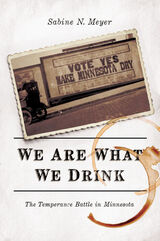 We Are What We Drink: The Temperance Battle in Minnesota
Sabine N. Meyer
University of Illinois Press, 2015 Sabine N. Meyer eschews the generalities of other temperance histories to provide a close-grained story about the connections between alcohol consumption and identity in the upper Midwest.
Meyer examines the ever-shifting ways that ethnicity, gender, class, religion, and place interacted with each other during the long temperance battle in Minnesota. Her deconstruction of Irish and German ethnic positioning with respect to temperance activism provides a rare interethnic history of the movement. At the same time, she shows how women engaged in temperance work as a way to form public identities and reforges the largely neglected, yet vital link between female temperance and suffrage activism. Relatedly, Meyer reflects on the continuities and changes between how the movement functioned to construct identity in the heartland versus the movement's more often studied roles in the East. She also gives a nuanced portrait of the culture clash between a comparatively reform-minded Minneapolis and dynamic anti-temperance forces in whiskey-soaked St. Paul--forces supported by government, community, and business institutions heavily invested in keeping the city wet.
 We Are What We Drink: The Temperance Battle in Minnesota
Sabine N Meyer
University of Illinois Press, 2018 Sabine N. Meyer eschews the generalities of other temperance histories to provide a close-grained story about the connections between alcohol consumption and identity in the upper Midwest. Meyer examines the ever-shifting ways that ethnicity, gender, class, religion, and place interacted with each other during the long temperance battle in Minnesota. Her deconstruction of Irish and German ethnic positioning with respect to temperance activism provides a rare interethnic history of the movement. At the same time, she shows how women engaged in temperance work as a way to form public identities and reforges the largely neglected, yet vital link between female temperance and suffrage activism. Relatedly, Meyer reflects on the continuities and changes between how the movement functioned to construct identity in the heartland versus the movement's more often studied roles in the East. She also gives a nuanced portrait of the culture clash between a comparatively reform-minded Minneapolis and dynamic anti-temperance forces in whiskey-soaked St. Paul--forces supported by government, community, and business institutions heavily invested in keeping the city wet.
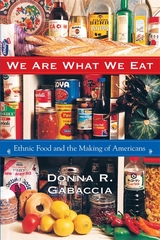 We Are What We Eat: Ethnic Food and the Making of Americans
Donna R. Gabaccia
Harvard University Press, 2000 Ghulam Bombaywala sells bagels in Houston. Demetrios dishes up pizza in Connecticut. The Wangs serve tacos in Los Angeles. How ethnicity has influenced American eating habits—and thus, the make-up and direction of the American cultural mainstream—is the story told in We Are What We Eat. It is a complex tale of ethnic mingling and borrowing, of entrepreneurship and connoisseurship, of food as a social and political symbol and weapon—and a thoroughly entertaining history of our culinary tradition of multiculturalism.
The story of successive generations of Americans experimenting with their new neighbors’ foods highlights the marketplace as an important arena for defining and expressing ethnic identities and relationships. We Are What We Eat follows the fortunes of dozens of enterprising immigrant cooks and grocers, street hawkers and restaurateurs who have cultivated and changed the tastes of native-born Americans from the seventeenth century to the present. It also tells of the mass corporate production of foods like spaghetti, bagels, corn chips, and salsa, obliterating their ethnic identities. The book draws a surprisingly peaceful picture of American ethnic relations, in which “Americanized” foods like Spaghetti-Os happily coexist with painstakingly pure ethnic dishes and creative hybrids.
Donna Gabaccia invites us to consider: If we are what we eat, who are we? Americans’ multi-ethnic eating is a constant reminder of how widespread, and mutually enjoyable, ethnic interaction has sometimes been in the United States. Amid our wrangling over immigration and tribal differences, it reveals that on a basic level, in the way we sustain life and seek pleasure, we are all multicultural.
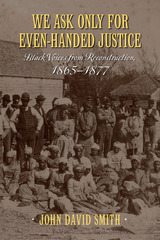 We Ask Only for Even-Handed Justice: Black Voices from Reconstruction, 1865-1877
John David Smith
University of Massachusetts Press, 2014 The sesquicentennial of the Civil War and Reconstruction invites reflection on the broad meaning of American democracy, including the ideals of freedom, equality, racial justice, and self-determination. In We Ask Only for Even-Handed Justice, John David Smith brings together a wealth of primary texts—editorials, letters, newspaper articles, and personal testimonies—to illuminate the experience of emancipation for the millions of African Americans enmeshed in the transition from chattel slavery to freedom from 1865 to 1877.
The years following Appomattox offered the freed people numerous opportunities and challenges. Ex-slaves reconnected with relatives dispersed by the domestic slave trade and the vicissitudes of civil war. They sought their own farms and homesteads, education for their children, and legal protection from whites hostile to their new status. They negotiated labor contracts, established local communities, and, following the 1867 Reconstruction Acts, entered local, state, and national politics.
Though aided by Freedmen's Bureau agents and sympathetic whites, former slaves nevertheless faced daunting odds. Ku Klux Klansmen and others terrorized blacks who asserted themselves, many northerners lost interest in their plight, and federal officials gradually left them to their own resources. As a result, former Confederates regained control of the southern state governments following the 1876 presidential election.
We Ask Only for Even-Handed Justice is a substantially revised and expanded edition of a book originally published under the title Black Voices from Reconstruction, 1865–1877.
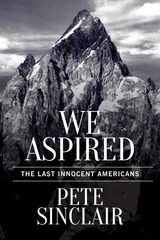 We Aspired: The Last Innocent Americans
Pete Sinclair
University of Utah Press, 2017 Imbued with a sense of place, Pete Sinclair climbed mountains and rescued others trying the same. He thrived on the risky business of ascending sheer rock, of moving from one adrenaline-boosting moment to another. In this book he recounts his mountain-climbing and park ranger days from 1959 to 1970, a time some people call a golden era of climbing in America, a time when climbers knew one another and frequently gathered in Grand Teton National Park. There, Sinclair was the ranger in charge of mountain rescue, a job that, especially when it involved the North Face of Grand Teton, drew on all his young team’s climbing skills. Mixing adventure with personal reflection, Sinclair recounts expeditions taken with friends to scale mountains in Alaska, Mexico, and other parts of North America, as well as his work rescuing injured climbers in the Tetons. The book serves as a history of a past era in mountaineering as well as a meditation on what it all meant. Throughout the book, he challenges readers to consider their relationship with the western landscape. Originally published in 1993, We Aspired was a finalist for the Boardman-Tasker Award for Mountain Literature. The account of one famous rescue on the North Face of the Grand Teton is retold in The Grand Rescue, a film by independent Utah producer Jenny Wilson.
We Bed Down into Water: Poems
John Rybicki
Northwestern University Press, 2008 John Rybicki offers up an unafraid set of poems in this charged book of verse. We Bed Down Into Water is rich with imagery of family, love, illness, death, and, indeed, water, which seeps in throughout the pages: rivers, pools, rain, and tears. His moving stories, in both prose and verse, struggle to hang on to a vision of the world that can still allow benevolence, luck, and laughter. In this, the collection embodies a contradiction: it is a tender book of fury, a book of bleak hopefulness. Rybicki’s work is steeped in challenge: the biological and spiritual challenge posed by his beloved’s recurrent cancer or the daily challenges of an adopted child who could be, all too easily, lost. He spins these phenomenal struggles into a lyrical book that offers hope and awakens the reader into a new way of seeing.
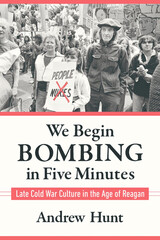 We Begin Bombing in Five Minutes: Late Cold War Culture in the Age of Reagan
Andrew Hunt
University of Massachusetts Press, 2021 In the moments before his weekly radio address hit the airwaves in 1984, Ronald Reagan made an off-the-record joke: "I've signed legislation that will outlaw Russia forever. We begin bombing in five minutes." As reports of the stunt leaked to the press, many Americans did not find themselves laughing along with the president. Long a fervent warrior against what he termed the "Evil Empire," by the mid-1980s, Reagan confronted growing domestic opposition to his revival of the Cold War. While numerous histories of the era have glorified the "Decade of Greed," historian Andrew Hunt instead explores the period's robust political and cultural dissent.
We Begin Bombing in Five Minutes focuses on a striking array of protest movements that took up issues such as the nuclear arms race, U.S. intervention in Central America, and American investments in South Africa. Hunt's new history of the eighties investigates how film, television, and other facets of popular culture critiqued Washington's Cold War policies and reveals that activists and cultural rebels alike posed a more meaningful challenge to the Cold War's excesses than their predecessors in the McCarthy era.
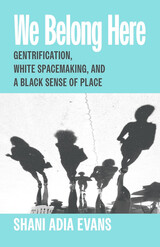 We Belong Here: Gentrification, White Spacemaking, and a Black Sense of Place
Shani Adia Evans
University of Chicago Press, 2025 A landmark study that shows how Black residents experience and respond to the rapid transformation of historically Black places. Although Portland, Oregon, is sometimes called “America’s Whitest city,” Black residents who grew up there made it their own. The neighborhoods of Northeast Portland, also called “Albina,” were a haven for and a hub of Black community life. But between 1990 and 2010, Albina changed dramatically—it became majority White. In We Belong Here, sociologist Shani Adia Evans offers an intimate look at gentrification from the inside, documenting the reactions of Albina residents as the racial demographics of their neighborhood shift. As White culture becomes centered in Northeast, Black residents recount their experiences with what Evans refers to as “White watching,” the questioning look on the faces of White people they encounter, which conveys an exclusionary message: “What are you doing here?” This, Evans shows, is a prime example of what she calls “White spacemaking”: the establishment of White space—spaces in which Whiteness is assumed to be the norm and non-Whites are treated with suspicion—in formerly non-White neighborhoods. Evans also documents Black residents’ efforts to create and maintain places for Black belonging in White-dominated Portland. While gentrification typically describes socioeconomic changes that may have racial implications, White spacemaking allows us to understand racism as a primary mechanism of neighborhood change. We Belong Here illuminates why gentrification and White spacemaking should be examined as intersecting, but not interchangeable, processes of neighborhood change.
We Belong to the Land: The Story of a Palestinian Israeli Who Lives for Peace and Reconciliation
Elias Chacour
University of Notre Dame Press, 2001 Nominated several times for the Noble Peace Prize, world-renowned Palestinian priest, Elias Chacour, narrates the gripping story of his life spent working to achieve peace and reconciliation among Israeli Jews, Christians, and Muslims. From the destruction of his boyhood village and his work as a priest in Galilee to his efforts to build school, libraries, and summer camps for children of all religions, this peacemaker’s moving story brings hope to one of the most complex struggles of our time.
 We Boys Together: Teenagers in Love Before Girl-Craziness
Jeffery P. Dennis
Vanderbilt University Press, 2007 Teenage boys are wild about girls.When their hormones kick in at puberty, they can think of nothing else, and that"s the way it has always been-- right? Wrong. Before World War II, only sissies liked girls. Masculine, red-blooded, all-American boys were supposed to ignore girls until they were 18 or 19. Instead, parents, teachers, psychiatrists, and especially the mass media encouraged them to form passionate, intense, romantic bonds with each other. This book explores romantic relationships between teenage boys as they were portrayed before, during, and immediately after World War II. The author takes the reader through a rich landscape of media -- sci fi pulps, comics, adventure stories, tales of teen sleuths, boys' serial novels, wartime bestsellers, and movies populated by many types of male adolescents: Boys Next Door, Adventure Boys, Jungle Boys, and Lost Boys. In Hollywood movies, Boys Next Door like Jackie Cooper, Ronald Sinclair, and Jimmy Lydon were constantly falling in love, but not with girls. In serial novels, Jungle Boys like Bomba, Sorak, and Og Son of Fire swung through the trees to rescue teenage boys, not teenage girls. In comic strips and on the radio, Adventure Boys like Don Study, Jack Armstrong, and Tim Tyler formed lasting romantic partnerships with other boys or men. Lost Boys like Frankie Darro, Leo Gorcey, and Billy Halop starred in dozens of movies about pairs of poor urban teenagers sticking together, with never a girl in sight.
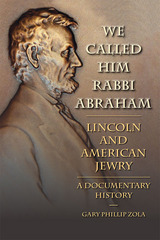 We Called Him Rabbi Abraham: Lincoln and American Jewry, a Documentary History
Gary Phillip Zola
Southern Illinois University Press, 2014 Over the course of American history, Jews have held many American leaders in high esteem, but they maintain a unique emotional bond with Abraham Lincoln. From the time of his presidency to the present day, American Jews have persistently viewed Lincoln as one of their own, casting him as a Jewish sojourner and, in certain respects, a Jewish role model. This pioneering compendium— The first volume of annotated documents to focus on the history of Lincoln’s image, influence, and reputation among American Jews— considers how Lincoln acquired his exceptional status and how, over the past century and a half, this fascinating relationship has evolved. Organized into twelve chronological and thematic chapters, these little-known primary source documents—many never before published and some translated into English for the first time—consist of newspaper clippings, journal articles, letters, poems, and sermons, and provide insight into a wide variety of issues relating to Lincoln’s Jewish connection. Topics include Lincoln’s early encounters with Central European Jewish immigrants living in the Old Northwest; Lincoln’s Jewish political allies; his encounters with Jews and the Jewish community as President; Lincoln’s response to the Jewish chaplain controversy; General U. S. Grant’s General Orders No. 11 expelling “Jews, as a class” from the Military Department of Tennessee; the question of amending the U.S. Constitution to legislate the country’s so-called Christian national character; and Jewish eulogies after Lincoln’s assassination. Other chapters consider the crisis of conscience that arose when President Andrew Johnson proclaimed a national day of mourning for Lincoln on the festival of Shavuot (the Feast of Weeks), a day when Jewish law enjoins Jews to rejoice and not to mourn; Lincoln’s Jewish detractors contrasted to his boosters; how American Jews have intentionally “Judaized” Lincoln ever since his death; the leading role that American Jews have played in in crafting Lincoln’s image and in preserving his memory for the American nation; American Jewish reflections on the question “What Would Lincoln Do?”; and how Lincoln, for America’s Jewish citizenry, became the avatar of America’s highest moral aspirations. With thoughtful chapter introductions that provide readers with a context for the annotated documents that follow, this volume provides a fascinating chronicle of American Jewry’s unfolding historical encounter with the life and symbolic image of Abraham Lincoln, shedding light on how the cultural interchange between American ideals and Jewish traditions influences the dynamics of the American Jewish experience.
Finalist, 2014 National Jewish Book Award
Finalist, 2015 Ohioana Book Award
 We Called it MAG-nificent: Dow Chemical and Magnesium, 1916-1998
E. N. Brandt
Michigan State University Press, 2013 During World War I, in 1916, Herbert Dow, founder of The Dow Chemical Company, received news of “star shells,” weapons that glowed eerily as they descended over the trenches of the enemy, making them easier to attack. The critical component in these flares was magnesium, a metal that was suddenly in great demand. Dow, along with a half-dozen other U.S. firms, swiftly began manufacturing magnesium, but by 1927 Dow was the only U.S. company still in the business. Dow’s key innovation was a method of extracting the metal from seawater, an engineering accomplishment finally achieved at Freeport, Texas, only eleven months prior to the Pearl Harbor attack. Dow was the principal supplier of magnesium for U.S. and British planes during World War II, a distinction that ironically yielded an indictment from the U.S. government on monopoly charges. The company eventually became the world’s largest manufacturer of magnesium until 1990, when the Chinese entered the market and offered the metal at rock-bottom prices. Dow quietly ended its production of magnesium in 1998. Brandt’s history is an engaging look at Dow’s eighty-three-year romance with this remarkable metal.
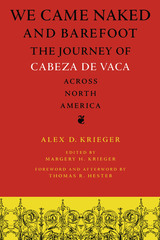 We Came Naked and Barefoot: The Journey of Cabeza de Vaca across North America
By Alex D. Krieger
University of Texas Press, 2002 Second place, Presidio La Bahia Award, Sons of the Republic of Texas, 2003 Perhaps no one has ever been such a survivor as álvar Núñez Cabeza de Vaca. Member of a 600-man expedition sent out from Spain to colonize "La Florida" in 1527, he survived a failed exploration of the west coast of Florida, an open-boat crossing of the Gulf of Mexico, shipwreck on the Texas coast, six years of captivity among native peoples, and an arduous, overland journey in which he and the three other remaining survivors of the original expedition walked some 1,500 miles from the central Texas coast to the Gulf of California, then another 1,300 miles to Mexico City. The story of Cabeza de Vaca has been told many times, beginning with his own account, Relación de los naufragios, which was included and amplified in Gonzalo Fernando de Oviedo y Váldez's Historia general de las Indias. Yet the route taken by Cabeza de Vaca and his companions remains the subject of enduring controversy. In this book, Alex D. Krieger correlates the accounts in these two primary sources with his own extensive knowledge of the geography, archaeology, and anthropology of southern Texas and northern Mexico to plot out stage by stage the most probable route of the 2,800-mile journey of Cabeza de Vaca. This book consists of several parts, foremost of which is the original English version of Alex Krieger's dissertation (edited by Margery Krieger), in which he traces the route of Cabeza de Vaca and his companions from the coast of Texas to Spanish settlements in western Mexico. This document is rich in information about the native groups, vegetation, geography, and material culture that the companions encountered. Thomas R. Hester's foreword and afterword set the 1955 dissertation in the context of more recent scholarship and archaeological discoveries, some of which have supported Krieger's plot of the journey. Margery Krieger's preface explains how she prepared her late husband's work for publication. Alex Krieger's original translations of the Cabeza de Vaca and Oviedo accounts round out the volume.
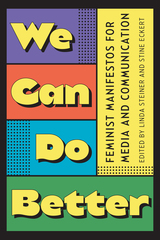 We Can Do Better: Feminist Manifestos for Media and Communication
Linda Steiner
Rutgers University Press, 2025 Feminist Manifestos for Media and Communication brings together evidence-based manifestos for media and communication that take a feminist perspective and add up to a provocative vision of feminist media practices and of feminist communication. The book discusses critical problems and complaints in ways that identify and make the case for actionable, concrete solutions to media problems and deficiencies; it shows how feminist thinking can be usefully and effectively applied to a wide range of journalism, media, and communication practices. The manifestos are not “only” about women but rather offer specific, feasible blueprints for restructuring media in ways that make them fairer and more equitable along many vectors of identity, so that media can better serve democracy. These manifestos give concrete solutions to specific problems that can and should be implemented by journalists, media practitioners, students, faculty, and scholars. The manifestos are organized around three sets of demands: for better media practices, for more participatory online spaces, and for more precise and appropriate language.
We Cannot Escape History: Lincoln and the Last Best Hope of Earth
Edited by James M. McPherson
University of Illinois Press, 1995 A classic collection examining Lincoln's commitment to preserving a union, free of slavery
A who's who of Lincoln scholars explores why Lincoln considered the Union the "last best hope of earth" and how his words and deeds have continued to shape the nation through modern times. Focusing on Lincoln's view of American history and his legacy for the United States and the world, this volume demonstrates the complexity of the problems Lincoln faced and the genius of his leadership in preserving the nation while purging it of slavery.
We Cannot Forget: Interviews with Survivors of the 1994 Genocide in Rwanda
Totten, Samuel
Rutgers University Press, 2011 During a one-hundred-day period in 1994, Hutus murdered between half a million and a million Tutsi in Rwanda. The numbers are staggering; the methods of killing were unspeakable. Utilizing personal interviews with trauma survivors living in Rwandan cities, towns, and dusty villages, We Cannot Forget relates what happened during this period and what their lives were like both prior to and following the genocide. Through powerful stories that are at once memorable, disturbing, and informative, readers gain a critical sense of the tensions and violence that preceded the genocide, how it erupted and was carried out, and what these people faced in the first sixteen years following the genocide.
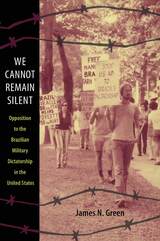 We Cannot Remain Silent: Opposition to the Brazilian Military Dictatorship in the United States
James N. Green
Duke University Press, 2010 In 1964, Brazil’s democratically elected, left-wing government was ousted in a coup and replaced by a military junta. The Johnson administration quickly recognized the new government. The U.S. press and members of Congress were nearly unanimous in their support of the “revolution” and the coup leaders’ anticommunist agenda. Few Americans were aware of the human rights abuses perpetrated by Brazil’s new regime. By 1969, a small group of academics, clergy, Brazilian exiles, and political activists had begun to educate the American public about the violent repression in Brazil and mobilize opposition to the dictatorship. By 1974, most informed political activists in the United States associated the Brazilian government with its torture chambers. In We Cannot Remain Silent, James N. Green analyzes the U.S. grassroots activities against torture in Brazil, and the ways those efforts helped to create a new discourse about human-rights violations in Latin America. He explains how the campaign against Brazil’s dictatorship laid the groundwork for subsequent U.S. movements against human rights abuses in Chile, Uruguay, Argentina, and Central America. Green interviewed many of the activists who educated journalists, government officials, and the public about the abuses taking place under the Brazilian dictatorship. Drawing on those interviews and archival research from Brazil and the United States, he describes the creation of a network of activists with international connections, the documentation of systematic torture and repression, and the cultivation of Congressional allies and the press. Those efforts helped to expose the terror of the dictatorship and undermine U.S. support for the regime. Against the background of the political and social changes of the 1960s and 1970s, Green tells the story of a decentralized, international grassroots movement that effectively challenged U.S. foreign policy.
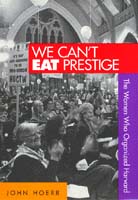 We Cant Eat Prestige: The Women Who Organized Harvard
John Hoerr
Temple University Press, 2001 This story explodes the popular belief that women white-collar workers tend to reject unionization and accept a passive role in the workplace. On the contrary, the women workers of Harvard University created a powerful and unique union--one that emphasizes their own values and priorities as working women and rejects unwanted aspects of traditional unionism. The workers involved comprise Harvard's 3,600-member "support staff," which includes secretaries, library and laboratory assistants, dental hygienists, accounting clerks, and a myriad of other office workers who keep a great university functioning. Even at prestigious private universities like Harvard and Yale, these workers--mostly women--have had to put up with exploitive management policies that denied them respect and decent wages because they were women. But the women eventually rebelled, declaring that they could not live on "prestige" alone. Encouraged by the women's movement of the early 1970's, a group of women workers (and a few men) began what would become a 15-year struggle to organize staff employees at Harvard. The women persisted in the face of patronizing and sexist attitudes of university administrators and leaders of their own national unions. Unconscionably long legal delays foiled their efforts. But they developed innovative organizing methods, which merged feminist values with demands for union representation and a means of influencing workplace decisions. Out of adversity came an unorthodox form of unionism embodied in the Harvard Union of Clerical and Technical Workers (HUCTW). Its founding was marked by an absorbing human drama that pitted unknown workers, such as Kris Rondeau, a lab assistant who came to head the union, against famous educators such as Harvard President Derek Bok and a panoply of prestigious deans. Other characters caught up in the drama included Harvard's John T. Dunlop, the nation's foremost industrial relations scholar and former U.S. Secretary of Labor. The drama was played out in innumerable hearings before the National Labor Relations Board, in the streets of Cambridge, and on the walks of historic Harvard Yard, where union members marched and sang and employed new tactics like "ballooning," designed to communicate a message of joy and liberation rather than the traditional "hate-the-boss" hostility. John Hoerr tells this story from the perspective of both Harvard administrators and union organizers. With unusual access to its meetings, leaders, and files, he examines the unique culture of a female-led union from the inside. Photographs add to the impact of this dramatic narrative. postamble();
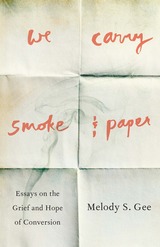 We Carry Smoke and Paper: Essays on the Grief and Hope of Conversion
Melody S. Gee
University of Iowa Press, 2024 Answering an unexpected call to faith in her thirties, Melody Gee contends with what saying “yes” to conversion requires of an adopted daughter of Chinese immigrants. Faced with a new framework for her place in the world, grief and doubt shadow her tentative steps toward becoming a believer. She looks for answers and consolation in her family’s story of immigration trauma and cultural assimilation, in the ways their burdens and limitations made her answer-seeking both impossible and inevitable.
In essays that explore the parallels between conversion and language acquisition, isolated liturgies, cultural inheritances, stalled initiations, disrupted storytelling, and adoption, Gee examines conversion’s grief and hope, losses and gains, hauntings and promises. We Carry Smoke and Paper is a memoir about what we owe to those who sacrifice everything for us, and it is about the many conversions in a lifetime that turn our heads via whispers and shouts, calling us to ourselves.
 We Could Not Fail: The First African Americans in the Space Program
By Richard Paul and Steven Moss
University of Texas Press, 2015 The Space Age began just as the struggle for civil rights forced Americans to confront the long and bitter legacy of slavery, discrimination, and violence against African Americans. Presidents John F. Kennedy and Lyndon Johnson utilized the space program as an agent for social change, using federal equal employment opportunity laws to open workplaces at NASA and NASA contractors to African Americans while creating thousands of research and technology jobs in the Deep South to ameliorate poverty. We Could Not Fail tells the inspiring, largely unknown story of how shooting for the stars helped to overcome segregation on earth. Richard Paul and Steven Moss profile ten pioneer African American space workers whose stories illustrate the role NASA and the space program played in promoting civil rights. They recount how these technicians, mathematicians, engineers, and an astronaut candidate surmounted barriers to move, in some cases literally, from the cotton fields to the launching pad. The authors vividly describe what it was like to be the sole African American in a NASA work group and how these brave and determined men also helped to transform Southern society by integrating colleges, patenting new inventions, holding elective office, and reviving and governing defunct towns. Adding new names to the roster of civil rights heroes and a new chapter to the story of space exploration, We Could Not Fail demonstrates how African Americans broke the color barrier by competing successfully at the highest level of American intellectual and technological achievement.
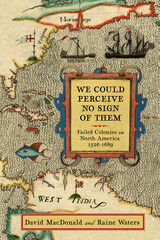 We Could Perceive No Sign of Them: Failed Colonies in North America, 1526–1689
David MacDonald
Westholme Publishing, 2020 The Story of the Many Ill-Fated Attempts by Europeans to Create Permanent Settlements in the New World
The nations of the modern Americas began as successful colonies, but not all colonies succeeded, and the margin between colonies that survived and those that failed was small. Both contribute to our understanding of the ordeals of the Europeans who first settled in the New World and of the Native Americans who had to interact with them, but with the exception of the famous lost Roanoke colony, the failed colonies of North America remain largely unknown except to specialists in colonial history. The Spanish and French repeatedly attempted to colonize parts of Georgia, Florida, and Virginia, while the Dutch, French, and English sought to establish permanent settlements along the northern waterways of the New World. The greatest problem faced by every colony was the specter of starvation. Native Americans gave food to newly arrived colonists, but such generosity could not endure. Indigenous people soon realized that colonists of every nationality were prepared to make war against Native peoples, conquer, subjugate, and even massacre whole communities unless they were cooperative and offered no resistance to the intrusion into their territory. In response, Native Americans withheld aid or resorted to retaliatory violence, dooming many European settlements.
In We Could Perceive No Sign of Them: Failed Colonies in North America, 1526–1689, historians David MacDonald and Raine Waters tell the fascinating stories of the many attempts to establish a European foothold in the New World, from the first Spanish colony in 1526 on the coast of Georgia to the final disastrous French endeavors near the arctic. Using primary source texts, the authors synthesize the shared experiences of Europeans to better understand the very fine line between success and failure and the varieties of Native American responses.
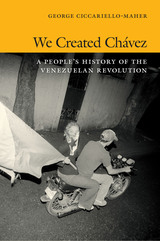 We Created Chávez: A People's History of the Venezuelan Revolution
Geo Maher
Duke University Press, 2013 Since being elected president in 1998, Hugo Chávez has become the face of contemporary Venezuela and, more broadly, anticapitalist revolution. George Ciccariello-Maher contends that this focus on Chávez has obscured the inner dynamics and historical development of the country’s Bolivarian Revolution. In We Created Chávez, by examining social movements and revolutionary groups active before and during the Chávez era, Ciccariello-Maher provides a broader, more nuanced account of Chávez’s rise to power and the years of activism that preceded it. Based on interviews with grassroots organizers, former guerrillas, members of neighborhood militias, and government officials, Ciccariello-Maher presents a new history of Venezuelan political activism, one told from below. Led by leftist guerrillas, women, Afro-Venezuelans, indigenous people, and students, the social movements he discusses have been struggling against corruption and repression since 1958. Ciccariello-Maher pays particular attention to the dynamic interplay between the Chávez government, revolutionary social movements, and the Venezuelan people, recasting the Bolivarian Revolution as a long-term and multifaceted process of political transformation.
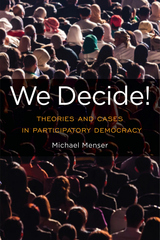 We Decide!: Theories and Cases in Participatory Democracy
Michael Menser
Temple University Press, 2017 Participatory democracy calls for the creation and proliferation of practices and institutions that enable individuals and groups to better determine the conditions in which they act and relate to others. Michael Menser’s timely book We Decide! is arguably the most comprehensive treatment of participatory democracy. He explains the three waves of participatory democracy theory to show that this movement is attentive to the mechanics of contemporary political practices. Menser also outlines “maximal democracy,” his own view of participatory democracy that expands people’s abilities to shape their own lives, reduce inequality, and promote solidarity. We Decide! draws on liberal, feminist, anarchist, and environmental justice philosophies as well as in-depth case studies of Spanish factory workers, Japanese housewives, and Brazilian socialists to show that participatory democracy actually works. Menser concludes his study by presenting a reconstructed version of the state that is shaped not by corporations but by inclusive communities driven by municipal workers, elected officials, and ordinary citizens working together. In this era of Bernie Sanders and Donald Trump, the participatory democracy proposed in We Decide! is more significant than ever.
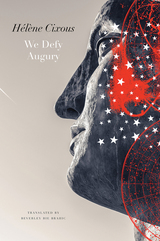 We Defy Augury
Hélène Cixous
Seagull Books, 2020 We defy augury. There’s a special providence in the fall of a sparrow. If it be now, ’tis not to come … the readiness is all. Under the sign of Hamlet’s last act, Hélène Cixous, in her eightieth year, launched her new book—and the latest chapter in her Human Comedy, her Search for Lost Time. Surely one of the most delightful, in its exposure of the seams of her extraordinary craft, We Defy Augury finds the reader among familiar faces. In these pages we encounter Eve, the indomitable mother; Jacques Derrida, the faithful friend; children, neighbors; and always the literary forebears: Montaigne, Diderot, Proust, and, in one moving passage, Erich Maria Remarque. We Defy Augury moves easily from Cixous’s Algerian childhood, to Bacharach in the Rhineland, to, eerily, the Windows on the World restaurant atop the World Trade Center, in the year 2000. In one of the most astonishing passages in this tour-de-force performance of the art of digression, Cixous proclaims: “My books are free in their movements and in their choice of routes […] They are the product of many makers, dreamed, dictated, cobbled together.” This unique experience, which could only have come from the pen of Cixous, is now available in English, and readers are sure to delight in this latest work by one of France’s most celebrated writer-philosophers.
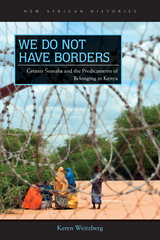 We Do Not Have Borders: Greater Somalia and the Predicaments of Belonging in Kenya
Keren Weitzberg
Ohio University Press, 2017 Though often associated with foreigners and refugees, many Somalis have lived in Kenya for generations, in many cases since long before the founding of the country. Despite their long residency, foreign and state officials and Kenyan citizens often perceive the Somali population to be a dangerous and alien presence in the country, and charges of civil and human rights abuses have mounted against them in recent years. In We Do Not Have Borders, Keren Weitzberg examines the historical factors that led to this state of affairs. In the process, she challenges many of the most fundamental analytical categories, such as “tribe,” “race,” and “nation,” that have traditionally shaped African historiography. Her interest in the ways in which Somali representations of the past and the present inform one another places her research at the intersection of the disciplines of history, political science, and anthropology. Given tragic events in Kenya and the controversy surrounding al-Shabaab, We Do Not Have Borders has enormous historical and contemporary significance, and provides unique inroads into debates over globalization, African sovereignty, the resurgence of religion, and the multiple meanings of being African.
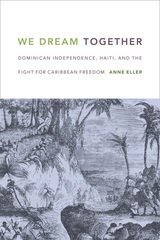 We Dream Together: Dominican Independence, Haiti, and the Fight for Caribbean Freedom
Anne Eller
Duke University Press, 2016 In We Dream Together Anne Eller breaks with dominant narratives of conflict between the Dominican Republic and Haiti by tracing the complicated history of Dominican emancipation and independence between 1822 and 1865. Eller moves beyond the small body of writing by Dominican elites that often narrates Dominican nationhood to craft inclusive, popular histories of identity, community, and freedom, summoning sources that range from trial records and consul reports to poetry and song. Rethinking Dominican relationships with their communities, the national project, and the greater Caribbean, Eller shows how popular anticolonial resistance was anchored in a rich and complex political culture. Haitians and Dominicans fostered a common commitment to Caribbean freedom, the abolition of slavery, and popular democracy, often well beyond the reach of the state. By showing how the island's political roots are deeply entwined, and by contextualizing this history within the wider Atlantic world, Eller demonstrates the centrality of Dominican anticolonial struggles for understanding independence and emancipation throughout the Caribbean and the Americas.
We Europeans?: Media, Representations, Identities
William Uricchio
Intellect Books, 2009 We Europeans? explores the relationship between media and identity along the fault lines and fissures of the shifting ethnicities, religions, tastes, generations, and languages that make up contemporary Europe. Addressing topics such as film, television, public monuments, and the press, an international group of contributors reveal how European identity is shaped as the continent administratively consolidates. In essays that explore cultural homogenization, longed-for identities, and the fears surrounding transnational media, this volume uncovers the intricate interactions of history and memory as they inform the European present.
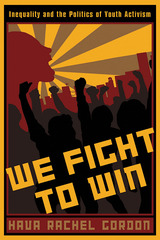 We Fight To Win: Inequality and the Politics of Youth Activism
Hava Rachel Gordon
Rutgers University Press, 2009 In an adult-dominated society, teenagers are often shut out of participation in politics. We Fight to Win offers a compelling account of young people's attempts to get involved in community politics, and documents the battles waged to form youth movements and create social change in schools and neighborhoods. Hava Rachel Gordon compares the struggles and successes of two very different youth movements: a mostly white, middle-class youth activist network in Portland, Oregon, and a working-class network of minority youth in Oakland, California. She examines how these young activists navigate schools, families, community organizations, and the mainstream media, and employ a variety of strategies to make their voices heard on some of today's most pressing issuesùwar, school funding, the environmental crisis, the prison industrial complex, standardized testing, corporate accountability, and educational reform. We Fight to Win is one of the first books to focus on adolescence and political action and deftly explore the ways that the politics of youth activism are structured by age inequality as well as race, class, and gender.
We Fish: The Journey to Fatherhood
Jack L. Daniel
University of Pittsburgh Press, 2005
We Fish is the tale of a father and son's shared dialogue in poetry and in prose, memoir and reflection, as they delight in their time spent fishing while considering the universal challenge of raising good children. Their story and their lesson have the power to teach today's young African American men about friendship, family, and trust; and the potential to save a generation from the dangers of the modern world and from themselves.
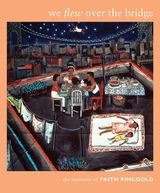 We Flew over the Bridge: The Memoirs of Faith Ringgold
Faith Ringgold
Duke University Press, 2005 In We Flew over the Bridge, one of the country’s preeminent African American artists—and award-winning children’s book authors—shares the fascinating story of her life. Faith Ringgold’s artworks—startling “story quilts,” politically charged paintings, and more—hang in the Studio Museum in Harlem, the Metropolitan Museum of Art, the Guggenheim Museum, the Museum of Modern Art, and other major museums around the world, as well as in the private collections of Maya Angelou, Bill Cosby, and Oprah Winfrey. Her children’s books, including the Caldecott Honor Book Tar Beach, have sold hundreds of thousands of copies. But Ringgold’s path to success has not been easy. In this gorgeously illustrated memoir, she looks back and shares the story of her struggles, growth, and triumphs. Ringgold recollects how she had to surmount a wall of prejudices as she worked to refine her artistic vision and raise a family. At the same time, the story she tells is one of warm family memories and sustaining friendships, community involvement, and hope for the future.
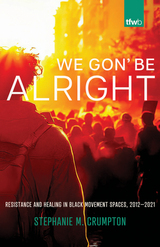 We Gon’ Be Alright: Resistance and Healing in Black Movement Spaces, 2012–2021
Stephanie M. Crumpton
University of Arizona Press, 2025 We Gon’ Be Alright: Resistance and Healing in Black Movement Spaces, 2012–2021 is a profound exploration of Black activism and organizing during a pivotal decade in American history. Rev. Dr. Stephanie M. Crumpton explores the practices of care, reflection, and creativity that Black activists employed to heal and resist amidst the sociopolitical turbulence from the Obama era through the first Trump presidency. This period, marked by the myth of a “post-racial” America, saw a resurgence in racial violence and hate crimes, culminating in the 2021 Capitol insurrection. Against this backdrop, Crumpton captures the resilience and ingenuity of Black movement workers as they navigated these challenges.
Drawing on oral histories and personal narratives, Crumpton provides an intimate look at the lived experiences of thirty-seven full-time community organizers. These activists and organizers share their strategies for maintaining an ethic of care that sustains them while fighting against both external oppression and internal community struggles. The book highlights how contemporary Black resisters have leveraged a growing understanding of trauma and healing to enhance their activism. This blend of historical knowledge and modern therapeutic practices has equipped them with a broader array of tools to support their communities.
Rooted in womanist practical theology, We Gon’ Be Alright emphasizes the interconnectedness of white supremacy with other forms of oppression such as sexism, homophobia, and classism. Crumpton’s work underscores the necessity of “deep, deep healing” to address these multifaceted threats to Black life. This book is an essential resource for scholars, activists, and anyone interested in understanding the dynamics of Black resistance and healing in contemporary America. Through its detailed examination of the past decade, it offers valuable insights into the ongoing struggle for Black humanity, dignity, and a thriving future.
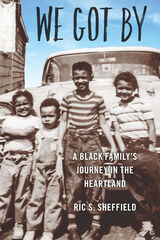 We Got By: A Black Family’s Journey in the Heartland
Ric S. Sheffield
Ohio State University Press, 2022 Life along the color line in rural Ohio was hard. Being Black often meant feeling frightened and alone. For a family like Ric S. Sheffield’s, examining this reality closely meant confronting challenges and tragedies that often felt overwhelming, even as their odyssey also included the joyful and inspiring. Navigating day-to-day existence in a world where trusting white neighbors required a careful mixture of caution and faith, Sheffield and his kin existed in a space where they were both seen and unseen.
Spanning four generations and assessing the legacies of traumatic events (arrests, murders, suicide) that are inextricable from the racial dynamics of the small community his family called home, this gripping memoir is a heartfelt, clear-eyed, and rare chronicle of Black life in the rural Midwest. Experiencing the burden of racism among people who refused to accept that such a thing existed only made the isolation feel that much worse to Sheffield and his relatives. And yet, they overcame the obstacles and managed to persist: they got by.
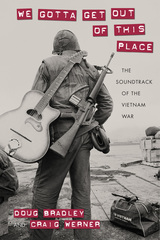 We Gotta Get Out of This Place: The Soundtrack of the Vietnam War
Doug Bradley
University of Massachusetts Press, 2015 For a Kentucky rifleman who spent his tour trudging through Vietnam's Central Highlands, it was Nancy Sinatra's "These Boots Are Made for Walkin'." For a "tunnel rat" who blew smoke into the Viet Cong's underground tunnels, it was Jimi Hendrix's "Purple Haze." For a black marine distraught over the assassination of Martin Luther King Jr., it was Aretha Franklin's "Chain of Fools." And for countless other Vietnam vets, it was "I Feel Like I'm Fixin' to Die," "Who'll Stop the Rain," or the song that gives this book its title.
In We Gotta Get Out of This Place, Doug Bradley and Craig Werner place popular music at the heart of the American experience in Vietnam. They explore how and why U.S. troops turned to music as a way of connecting to each other and the World back home and of coping with the complexities of the war they had been sent to fight. They also demonstrate that music was important for every group of Vietnam veterans—black and white, Latino and Native American, men and women, officers and "grunts"—whose personal reflections drive the book's narrative. Many of the voices are those of ordinary soldiers, airmen, seamen, and marines. But there are also "solo" pieces by veterans whose writings have shaped our understanding of the war—Karl Marlantes, Alfredo Vea, Yusef Komunyakaa, Bill Ehrhart, Arthur Flowers—as well as songwriters and performers whose music influenced soldiers' lives, including Eric Burdon, James Brown, Bruce Springsteen, Country Joe McDonald, and John Fogerty. Together their testimony taps into memories—individual and cultural—that capture a central if often overlooked component of the American war in Vietnam.
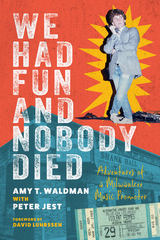 We Had Fun and Nobody Died: Adventures of a Milwaukee Music Promoter
Amy T. Waldman
Wisconsin Historical Society Press, 2024 The entertaining and inspiring story of a stubbornly independent promoter and club owner This irreverent biography provides a rare window into the music industry from a promoter’s perspective. From a young age, Peter Jest was determined to make a career in live music, and despite naysayers and obstacles, he did just that, bringing national acts to his college campus at UW–Milwaukee, booking thousands of concerts across Wisconsin and the Midwest, and opening Shank Hall, the beloved Milwaukee venue named after a club in the cult film This Is Spinal Tap. This funny, nostalgia-inducing book details the lasting friendships Jest established over the years with John Prine, Arlo Guthrie, and Milwaukee’s own Violent Femmes, among others. It also shines a light into the seldom-seen world of music promotion, as Jest attempts to manage a turbulent band on the road, negotiates with agents, deals with fires (both real and metaphorical), struggles through a pandemic, and takes pleasure in presenting music of all kinds—from world-famous acts to up-and-coming local bands. In addition to photos of celebrated musicians, the book includes concert posters, tickets, and backstage passes documenting decades of rock, folk, and alternative shows that helped put Milwaukee on the live music map. As the music industry has become dominated by profit-driven corporations, We Had Fun and Nobody Died chronicles the career of a one-of-a-kind independent promoter whose hardheadedness and love of music have helped him keep it real and make it in the music business for more than forty years.
"[An] adventure-filled biography of music promoter Peter Jest. . . . Reflecting decades of changes to the music business, We Had Fun and Nobody Died is a fascinating biography of a passionate promoter’s work to transform Milwaukee’s music scene."
—Foreword Reviews
“Amy Waldman and Peter Jest weave a thrilling tale of fanhood gone pro. Dreams followed, dragons slain, and the roof of a venerable venue repeatedly blown sky-high. We’re proud to have provided the name [for Shank Hall]; it took men and women of sterner stuff to do the heavy lifting.”
—Michael McKean, actor and comedian, This Is Spinal Tap
“We Had Fun and Nobody Died is a fantastic journey of a Midwest boy, his love of music, and his excitement to be part of it all.”
—Kevn Kinney, lead singer and guitarist of Drivin N Cryin
“Peter Jest’s story is one that conveys a winning combination of friendship, determination, and entrepreneurial insights that led him to a lifelong career in support of the live music industry and the community that comes together in common appreciation of it.”
—Shana Morrison, singer-songwriter
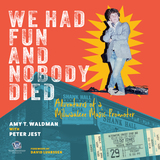 We Had Fun and Nobody Died: Adventures of a Milwaukee Music Promoter
Amy T. Waldman
Wisconsin Historical Society Press, 2025 The entertaining and inspiring story of a stubbornly independent promoter and club owner This irreverent biography provides a rare window into the music industry from a promoter’s perspective. From a young age, Peter Jest was determined to make a career in live music, and despite naysayers and obstacles, he did just that, bringing national acts to his college campus at UW–Milwaukee, booking thousands of concerts across Wisconsin and the Midwest, and opening Shank Hall, the beloved Milwaukee venue named after a club in the cult film This Is Spinal Tap. This funny, nostalgia-inducing book details the lasting friendships Jest established over the years with John Prine, Arlo Guthrie, and Milwaukee’s own Violent Femmes, among others. It also shines a light into the seldom-seen world of music promotion, as Jest attempts to manage a turbulent band on the road, negotiates with agents, deals with fires (both real and metaphorical), struggles through a pandemic, and takes pleasure in presenting music of all kinds—from world-famous acts to up-and-coming local bands. As the music industry has become dominated by profit-driven corporations, We Had Fun and Nobody Died chronicles the career of a one-of-a-kind independent promoter whose hardheadedness and love of music have helped him keep it real and make it in the music business for more than forty years.
"[An] adventure-filled biography of music promoter Peter Jest. . . . Reflecting decades of changes to the music business, We Had Fun and Nobody Died is a fascinating biography of a passionate promoter’s work to transform Milwaukee’s music scene."
—Foreword Reviews
“Amy Waldman and Peter Jest weave a thrilling tale of fanhood gone pro. Dreams followed, dragons slain, and the roof of a venerable venue repeatedly blown sky-high. We’re proud to have provided the name [for Shank Hall]; it took men and women of sterner stuff to do the heavy lifting.”
—Michael McKean, actor and comedian, This Is Spinal Tap
“We Had Fun and Nobody Died is a fantastic journey of a Midwest boy, his love of music, and his excitement to be part of it all.”
—Kevn Kinney, lead singer and guitarist of Drivin N Cryin
“Peter Jest’s story is one that conveys a winning combination of friendship, determination, and entrepreneurial insights that led him to a lifelong career in support of the live music industry and the community that comes together in common appreciation of it.”
—Shana Morrison, singer-songwriter
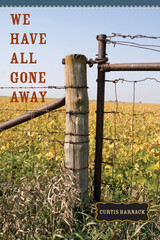 We Have All Gone Away
Curtis Harnack
University of Iowa Press, 1973 In We Have All Gone Away, his emotionally moving memoir, Curtis Harnack tells of growing up during the Great Depression on an Iowa farm among six siblings and an extended family of relatives. With a directness and a beauty that recall Thoreau, Harnack balances a child’s impressions with the knowledge of an adult looking back to produce what Publishers Weekly called “a country plum of a book, written with genuine affection and vivid recall.” In a community related by blood and harvest, rural life could be bountiful even when hard economic times threatened. The adults urged children to become educated and to keep an eye on tomorrow. “We were all taught to lean enthusiastically into the future,” Harnack recalls, which would likely be elsewhere, in distant cities. At the same time, the children were cultivating a resiliency that would serve them well in the unknown world of the second half of the twentieth century. Inevitably, the Midwest’s small, diversified family farm gave way to large-scale agriculture, which soon changed the former intimate way of life. “Our generation, using the mulched dead matter of agrarian life like projectile fuel for our thrust into the future, became part of that enormous vitality springing out of rural America,” notes Harnack. Both funny and elegiac, We Have All Gone Away is a masterful memoir of the joys and sorrows of Iowa farm life at mid-century, a world now gone “by way of learning, wars, and marriage” but still a lasting part of America’s heritage.
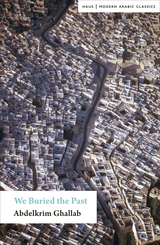 We Have Buried the Past
Abdelkrim Ghallab
Haus Publishing, 2018 Abdelkrim Ghallab’s postcolonial We Buried the Past, originally published in 1966, was the first breakthrough Moroccan novel written in Arabic instead of French. Newly translated into English, this edition brings Ghallab’s most widely read and lauded work to a new audience.
Written after the country gained independence, the historical novel follows two generations of al-Tihamis, a well-to-do family residing in Fez’s ancient medina. The family members’ lives reflect the profound social changes taking place in Morocco during that time. Bridging two worlds, We Buried the Past begins during the quieter days of the late colonial period, a world of seemingly timeless tradition, in which the patriarch, al-Haj Muhammad, proudly presides over the family. Here, religion is unquestioned and permeates all aspects of daily life. But the coming upheaval and imminent social transition are reflected in al-Haj’s three sons, particularly his second son, Abderrahman, who eventually defies his father and comes to symbolize the break between the old ways and the new.
Noted for marrying classical Arabic style and European literary form, this book also offers insight into the life of Ghallab himself, who was deeply involved in the nationalist movement that led to Moroccan independence. A pioneering work, We Buried the Past beautifully characterizes an influential period in the history of Morocco.
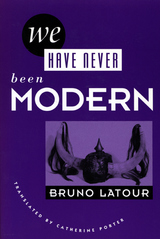 We Have Never Been Modern
Bruno Latour
Harvard University Press, 1993 With the rise of science, we moderns believe, the world changed irrevocably, separating us forever from our primitive, premodern ancestors. But if we were to let go of this fond conviction, Bruno Latour asks, what would the world look like? His book, an anthropology of science, shows us how much of modernity is actually a matter of faith.
What does it mean to be modern? What difference does the scientific method make? The difference, Latour explains, is in our careful distinctions between nature and society, between human and thing, distinctions that our benighted ancestors, in their world of alchemy, astrology, and phrenology, never made. But alongside this purifying practice that defines modernity, there exists another seemingly contrary one: the construction of systems that mix politics, science, technology, and nature. The ozone debate is such a hybrid, in Latour’s analysis, as are global warming, deforestation, even the idea of black holes. As these hybrids proliferate, the prospect of keeping nature and culture in their separate mental chambers becomes overwhelming—and rather than try, Latour suggests, we should rethink our distinctions, rethink the definition and constitution of modernity itself. His book offers a new explanation of science that finally recognizes the connections between nature and culture—and so, between our culture and others, past and present.
Nothing short of a reworking of our mental landscape, We Have Never Been Modern blurs the boundaries among science, the humanities, and the social sciences to enhance understanding on all sides. A summation of the work of one of the most influential and provocative interpreters of science, it aims at saving what is good and valuable in modernity and replacing the rest with a broader, fairer, and finer sense of possibility.
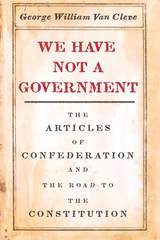 We Have Not a Government: The Articles of Confederation and the Road to the Constitution
George William Van Cleve
University of Chicago Press, 2017 In 1783, as the Revolutionary War came to a close, Alexander Hamilton resigned in disgust from the Continental Congress after it refused to consider a fundamental reform of the Articles of Confederation. Just four years later, that same government collapsed, and Congress grudgingly agreed to support the 1787 Philadelphia Constitutional Convention, which altered the Articles beyond recognition. What occurred during this remarkably brief interval to cause the Confederation to lose public confidence and inspire Americans to replace it with a dramatically more flexible and powerful government? We Have Not a Government is the story of this contentious moment in American history.
In George William Van Cleve’s book, we encounter a sharply divided America. The Confederation faced massive war debts with virtually no authority to compel its members to pay them. It experienced punishing trade restrictions and strong resistance to American territorial expansion from powerful European governments. Bitter sectional divisions that deadlocked the Continental Congress arose from exploding western settlement. And a deep, long-lasting recession led to sharp controversies and social unrest across the country amid roiling debates over greatly increased taxes, debt relief, and paper money. Van Cleve shows how these remarkable stresses transformed the Confederation into a stalemate government and eventually led previously conflicting states, sections, and interest groups to advocate for a union powerful enough to govern a continental empire.
Touching on the stories of a wide-ranging cast of characters—including John Adams, Patrick Henry, Daniel Shays, George Washington, and Thayendanegea—Van Cleve makes clear that it was the Confederation’s failures that created a political crisis and led to the 1787 Constitution. Clearly argued and superbly written, We Have Not a Government is a must-read history of this crucial period in our nation’s early life.
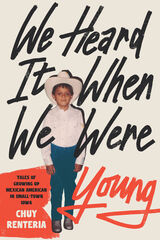 We Heard It When We Were Young
Renteria, Chuy
University of Iowa Press, 2021 Most agree that West Liberty is a special place. The first majority Hispanic town in Iowa, it has been covered by media giants such as Reuters, Telemundo, NBC, and ESPN. But Chuy Renteria and his friends grew up in the space between these news stories, where a more complicated West Liberty awaits. We Heard It When We Were Young tells the story of a young boy, first-generation Mexican American, who is torn between cultures: between immigrant parents trying to acclimate to midwestern life and a town that is, by turns, supportive and disturbingly antagonistic.
Renteria looks past the public celebrations of diversity to dive into the private tensions of a community reflecting the changing American landscape. There are culture clashes, breakdancing battles, fistfights, quinceañeras, vandalism, adventures on bicycles, and souped-up lowriders, all set to an early 2000s soundtrack. Renteria and his friends struggle to find their identities and reckon with intergenerational trauma and racism in a town trying to do the same. A humorous and poignant reflection on coming of age, We Heard It When We Were Young puts its finger on a particular cultural moment at the turn of the millennium.
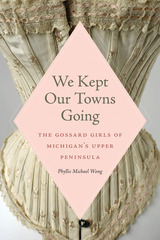 We Kept Our Towns Going: The Gossard Girls of Michigan's Upper Peninsula
Phyllis Michael Wong
Michigan State University Press, 2022 WITH A FOREWORD BY LISA M. FINE, MICHIGAN STATE UNIVERSITY—Michigan’s Upper Peninsula is known for its natural beauty and severe winters, as well as the mines and forests where men labored to feed industrial factories elsewhere in the nineteenth and twentieth centuries. But there were factories in the Upper Peninsula, too, and women who worked in them. Phyllis Michael Wong tells the stories of the Gossard Girls, women who sewed corsets and bras at factories in Ishpeming and Gwinn from the early twentieth century to the 1970s. As the Upper Peninsula’s mines became increasingly exhausted and its stands of timber further depleted, the Gossard Girls’ income sustained both their families and the local economy. During this time the workers showed their political and economic strength, including a successful four-month strike in the 1940s that capped an eight-year struggle to unionize. Drawing on dozens of interviews with the surviving workers and their families, this book highlights the daily challenges and joys of these mostly first- and second-generation immigrant women. It also illuminates the way the Gossard Girls navigated shifting ideas of what single and married women could and should do as workers and citizens. From cutting cloth and distributing materials to getting paid and having fun, Wong gives us a rare ground-level view of piecework in a clothing factory from the women on the sewing room floor.
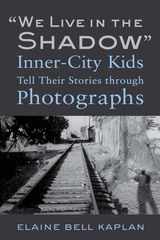 "We Live in the Shadow": Inner-City Kids Tell Their Stories through Photographs
Elaine Bell Kaplan
Temple University Press, 2013 Looking at their photo of railroad tracks, a group of preteen students in South Central Los Angeles see either "a way out of the ghetto," or a "dirty, bad environment." Such are the impressions expressed in the poignant "We Live in the Shadow": Inner-City Kids Tell Their Stories through Photographs. In Elaine Bell Kaplan's perceptive book, at-risk youth were given five-dollar cameras to tell stories about their world. Their photos and stories show us their response to negative inner-city teen images. We follow them into their schools, and we hear about their creative coping strategies. While these kids see South Central as dangerous, they also see themselves as confident enough to not let the inner city take them down. They refuse to be labeled as "ghetto thugs," as outsiders sometimes do. These outsiders include police, teachers, and other groups representing the institutional voices governing their daily lives. The kids in "We Live in the Shadow": Inner-City Kids Tell Their Stories through Photographs have developed a multilayered view of society. This impressive book gives voice to their resilience.
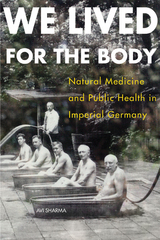 We Lived for the Body: Natural Medicine and Public Health in Imperial Germany
Avi Sharma
Northern Illinois University Press, 2014 Nature was central to the Wilhelmine German experience. Medical cosmologies and reform-initiatives were a key to consumer practices and lifestyle choices. Nature’s appeal transcended class, confession, and political party. Millions of Germans recognized that nature had healing effects and was intimately tied to quality of life. In the 1880s and 1890s, this preoccupation with nature became an increasingly important part of German popular culture.
In this pioneering study, Avi Sharma shows that nature, health, and the body became essential ways of talking about real and imagined social and political problems. The practice of popular medicine in the Wilhelmine era brought nature back into urban everyday experience, transforming the everyday lives of ordinary citizens. Sharma explores the history of natural healing in Germany and shows how social and medical practices that now seem foreign to contemporary eyes were, just decades ago, familiar to everyone from small children to their aged grandparents, from tradesmen and women to research scientists. Natural healing was not simply a way to cure illness. It was also seen as a way to build a more healthful society. Using interpretive methods drawn from the history of science and science studies, Sharma provides a readable and groundbreaking inquiry into how popular health and hygiene movements shaped German ideas about progress, modernity, nature, health, and the body at the end of the 19th and the beginning of the 20th century.
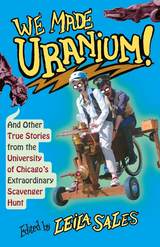 We Made Uranium!: And Other True Stories from the University of Chicago's Extraordinary Scavenger Hunt
Edited by Leila Sales
University of Chicago Press, 2018 Item #176: A fire drill. No, not an exercise in which occupants of a building practice leaving the building safely. A drill which safely emits a bit of fire, the approximate shape and size of a drill bit.
Item #74: Enter a lecture class in street clothes. Receive loud phone call. Shout “I NEED TO GO, THE CITY NEEDS ME!” Remove street clothes to reveal superhero apparel. Run out for the good of the land.
Item #293: Hypnotizing a chicken seems easy, but if the Wikipedia article on the practice is to be believed, debate on the optimal method is heated. Do some trials on a real chicken and submit a report . . . for science of course.
Item #234: A walking, working, people-powered but preferably wind-powered Strandbeest.
Item #188: Fattest cat. Points per pound.
The University of Chicago’s annual Scavenger Hunt (or “Scav”) is one of the most storied college traditions in America. Every year, teams of hundreds of competitors scramble over four days to complete roughly 350 challenges. The tasks range from moments of silliness to 1,000-mile road trips, and they call on participants to fully embrace the absurd. For students it is a rite of passage, and for the surrounding community it is a chance to glimpse the lighter side of a notoriously serious university.
We Made Uranium! shares the stories behind Scav, told by participants and judges from the hunt’s more than thirty-year history. The twenty-three essays range from the shockingly successful (a genuine, if minuscule, nuclear reaction created in a dorm room) to the endearing failures (it’s hard to build a carwash for a train), and all the chicken hypnotisms and permanent tattoos in between. Taken together, they show how a scavenger hunt once meant for blowing off steam before finals has grown into one of the most outrageous annual traditions at any university. The tales told here are absurd, uplifting, hilarious, and thought-provoking—and they are all one hundred percent true.
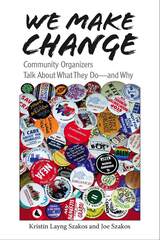 We Make Change: Community Organizers Talk About What They Do--and Why
Kristin Layng Szakos
Vanderbilt University Press, 2007 Community organizers work at their jobs because they are passionate, because they believe that change is possible, and because they enjoy working with people. Although it's not an occupation that leads to great wealth, community organizers can make a living at it. They get salaries, pensions and health insurance. They raise families. They do well by doing good. This book explores the world of community organizing through the voices of real people working in the field, in small towns and city neighborhoods--women and men of different races and economic backgrounds, ranging in age from those in their twenties to those in their sixties. Fourteen in-depth profiles tell the life stories of a cross-section of the diverse people who choose the life of an organizer. Other chapters, focused on issues of organizing, are tapestries of experience woven from the 81 interviews the authors conducted.
 We Make Our Own History: Marxism and Social Movements in the Twilight of Neoliberalism
Laurence Cox and Alf Gunvald Nilsen
Pluto Press, 2014 We live in the twilight of neoliberalism: the ruling classes can no longer rule as before, and ordinary people are no longer willing to be ruled in the old way. Pursued by global elites since the 1970s, neoliberalism is defined by dispossession and ever-increasing inequality. The refusal to continue to be ruled like this - "ya basta!" - appears in an arc of resistance stretching from rural India to the cities of the global North.
From this network of movements, new visions are emerging of a future beyond neoliberalism. We make our own History responds to these visions by reclaiming Marxism as a theory born from activist experience and practice.
This book marks a break both with established social movement theory, and with those forms of Marxism which treat the practice of social movement organising as an unproblematic process. It shows how movements can develop from local conflicts to global struggles; how neoliberalism operates as a social movement from above, and how popular struggles can create new worlds from below.
 We Mark Your Memory: writings from the descendants of indenture
Edited by David Dabydeen, Maria del Pilar Kaladeen, and Tina K. Ramnarine
University of London Press, 2018 Customers based in the United States and Canada, please order from here: https://bit.ly/2GAV2YR The abolition of slavery was the catalyst for the arrival of the first Indian indentured labourers into the sugar colonies of Mauritius (1834), Guyana (1838) and Trinidad (1845), followed some years later by the inception of the system in South Africa (1860) and Fiji (1879). By the time indenture was abolished in the British Empire (1917–20), over one million Indians had been contracted, the overwhelming majority of whom never returned to India. Today, an Indian indentured labour diaspora is to be found in Commonwealth countries including Belize, Kenya, Malaysia, Sri Lanka and the Seychelles. Indenture, whereby individuals entered, or were coerced, into an agreement to work in a colony in return for a fixed period of labour, was open to abuse from recruitment to plantation. Hidden within this little-known system of nineteenth- and early twentieth-century Indian migration under the British Empire are hitherto neglected stories of workers who were both exploited and unfree. These include indentured histories from Madeira to the Caribbean, from West Africa to the Caribbean, and from China to the Caribbean, Mauritius and South Africa. To mark the centenary of the abolition of the system in the British Empire (2017–20) this volume brings together, for the first time, new writing from across the Commonwealth. It is a unique attempt to explore, through the medium of poetry and prose, the indentured heritage of the twenty-first century.
"We Met in Paris": Grace Frick and Her Life with Marguerite Yourcenar
Joan E. Howard
University of Missouri Press, 2020 Grace Frick introduced English-language readers all over the world to the distinguished French author Marguerite Yourcenar with her award-winning translation of Yourcenar’s novel Memoirs of Hadrian in 1954. European biographies of Yourcenar have often disparaged Frick and her relationship with Yourcenar, however. This work shows Frick as a person of substance in her own right, and paints a portrait of both women that is at once intimate and scrupulously documented. It contains a great deal of new information that will disrupt long-held beliefs about Yourcenar and may even shock some of her scholars and fans.
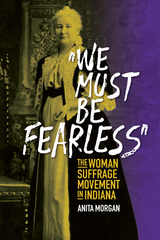 "We Must Be Fearless": The Woman Suffrage Movement in Indiana
Anita Morgan
Indiana Historical Society Press, 2020 Commemorating the centennial of women receiving the right to vote in the United States in 1920, "We Must Be Fearless": The Woman Suffrage Movement in Indiana by historian Anita Morgan examines the struggles and triumphs of a myriad of Hoosier women-black and white, rich and poor, urban and rural-who banded together to seek equal rights with men at the ballot box. The story of the Indiana women's suffrage movement can be divided into three stages. The first began with the first woman's rights association meeting in 1851 and ended in 1869. Hoosier women held yearly meetings and agreed upon basic goals that included not only suffrage, but also equal pay for equal work, changes to married women's property laws, and greater employment opportunities and access to the professions. Most members of this early group put their efforts aside during the Civil War to devote their time to nursing and other war work. The exception to this was Lizzie Bunnell, who published The Mayflower from her home in Peru, Indiana. Bunnell's bi-monthly newspaper supported both the Union and woman's rights and is believed to be the only woman's rights newspaper published during the war. Following the Civil War, the fight for woman's rights resumed, but with a new, almost singular focus on suffrage. This second phase of woman's suffrage work in Indiana began in 1869 when the Indiana Woman's Rights Association reformed with a new name-the Indiana Woman's Suffrage Association. The association aligned itself with Lucy Stone's American Woman Suffrage Association, a national group that focused more on gaining the vote and less on social issues than the National Woman Suffrage Association led by Elizabeth Cady Stanton and Susan B. Anthony. The Indianapolis-based Equal Suffrage Society joined the fight in 1878. The combined power of these groups pushed the Indiana General Assembly to the brink of woman suffrage in 1881-83, but in the end the fear that women would vote as one in favor of temperance legislation got in the way of the passage of the state woman's suffrage amendment. The final phase of the suffrage movement in Indiana started with the 1890s as many Hoosier women worked with national women's groups or worked on local and state progressive reforms aside from or in addition to their work on suffrage. After sporadic failed attempts to push through suffrage in this era, the joint efforts of the Woman's Franchise League and the nonpartisan Legislative Council of Indiana Women, combined with a strong and growing acceptance of woman's suffrage at the national level (in part as a result of women's work during World War I), once again pushed Indiana to the brink of woman's suffrage. The Indiana legislature passed the Woman's Suffrage Act of 1917, which gave women partial suffrage in the November elections that year and passed the first reading of the Beardsley Full Suffrage Amendment. This meant that Indiana women would achieve full suffrage in 1919 if the amendment also passed that legislative session. As women across the state registered to vote, William Knight filed suit against women voting and he won. Hoosier women did not get to vote in the elections that November and had to wait for passage of the Nineteenth Amendment to gain full voting rights.
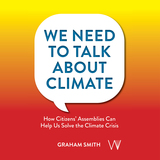 We Need To Talk About Climate: How Citizens' Assemblies Can Help Us Solve The Climate Crisis
Graham Smith
University of Westminster Press, 2024 Citizens’ assemblies bring the shared wisdom of ordinary people into political decision making on the climate and ecological crisis. They are increasingly being used at local, national and even global levels. But with what impact? Can they take us beyond the shortcomings of electoral and partisan politics? Can they make a real difference? This book explains why climate assemblies have captured the imagination of governments and activists alike, exploring the ways they can have a meaningful impact on climate politics. This book charts the development of climate assemblies across Europe and beyond. It explores what ordinary people want, highlighting the ways in which assembly recommendations take us beyond current government policies and offer new visions and directions for change. It shows that not all assemblies are the same and that the context and design of climate assemblies have differed quite profoundly – as have their impacts on policy and public discourse. The book also lays out the key elements needed for climate assemblies to have sustained impact, providing essential insights for anyone wanting to run or advocate for them, and concludes with reflections on what we can expect from assemblies as they evolve. The transition to net zero and climate resilient societies requires deep social and economic transformations that will have significant impacts on citizens’ choices and behaviours. Such a transition needs to engage the public directly and this book shows how climate assemblies can achieve this, allowing us to address the issues we all face together.
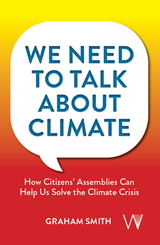 We Need To Talk About Climate: How Citizens' Assemblies Can Help Us Solve The Climate Crisis
Graham Smith
University of Westminster Press, 2024 Citizens’ assemblies bring the shared wisdom of ordinary people into political decision making on the climate and ecological crisis. They are increasingly being used at local, national and even global levels. But with what impact? Can they take us beyond the shortcomings of electoral and partisan politics? Can they make a real difference? This book explains why climate assemblies have captured the imagination of governments and activists alike, exploring the ways they can have a meaningful impact on climate politics. This book charts the development of climate assemblies across Europe and beyond. It explores what ordinary people want, highlighting the ways in which assembly recommendations take us beyond current government policies and offer new visions and directions for change. It shows that not all assemblies are the same and that the context and design of climate assemblies have differed quite profoundly – as have their impacts on policy and public discourse. The book also lays out the key elements needed for climate assemblies to have sustained impact, providing essential insights for anyone wanting to run or advocate for them, and concludes with reflections on what we can expect from assemblies as they evolve. The transition to net zero and climate resilient societies requires deep social and economic transformations that will have significant impacts on citizens’ choices and behaviours. Such a transition needs to engage the public directly and this book shows how climate assemblies can achieve this, allowing us to address the issues we all face together.
We Only Know Men: The Rescue of Jews in France during the Holocaust
Patrick Henry
Catholic University of America Press, 2007 Patrick Henry, working with more than one thousand unpublished autobiographical pages written by key rescuers and with documents, letters, and interviews never before available, reconsiders the Holocaust rescue of Jews on the plateau of Vivarais-Lignon between the years 1939 and 1944
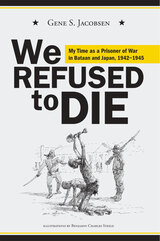 We Refused to Die: My time as a prisoner of war in Bataan and Japan, 1942-1945
Gene S Jacobsen
University of Utah Press, 2004 Gene Jacobsen was a nineteen-year-old Idaho ranch kid when he decided to join the Army Air Corps in September 1940. By December 1941 he was supply sergeant for the Twentieth Pursuit Squadron at Clark Field in the Philippines. Five months later he was a captive of the Imperial Japanese Army, enduring the Bataan death march and subsequent horrors in the Philippines and Japan. Of the 207 officers and men who made up Jacobsen’s squadron at the beginning of the war, sixty-five survived to return to the United States. We Refused to Die recounts Jacobsen’s struggle, against all odds, to remain one of those sixty-five men.
In engaging, direct prose, Jacobsen’s three-and-a-half year experience as a prisoner of war takes the reader on a brutal and harrowing march through hatred and forgiveness, fortitude and freedom. We Refused to Die is an honest memoir that shines light on one of history’s darkest moments.
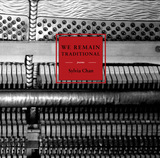 We Remain Traditional
Sylvia Chan
University Press of Colorado, 2018 In We Remain Traditional, Sylvia Chan juxtaposes the elegy, the conflict, and the brashness of a relationship that summons wild musicality in its love and frustration. Through the speaker and Adam, the beloveds offer thirty-two consolations for the gendered history of Chinese American women—a break and affirmation of their traditions. What saves these two characters is their music—a peace treaty for the book’s form or “fractured paradise,” a language that protects and protests their bodies in Oakland, California. Marked by vulnerability and intimacy, Chan interrogates a young woman’s childhood sexual abuse. In the vein of Stacy Doris and Paul Celan, Chan asks, because she is a child of violent tradition, what is her visceral grief? This is a speaker who aspires to create universal experiences for her listeners, to transform jazz into narrative. This is a wild, beautiful, and ambitious first book: Chan refuses to apologize for the terror in her conviction and compassion. To choose a man who is behind her sexual, psychological, and political exploitation is to forgive his narcissism, aggression, and addiction. To love, simply, is to live unafraid of pushing boundaries and being happy.
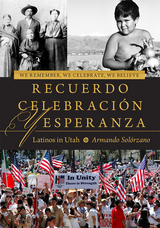 We Remember, We Celebrate, We Believe / Recuerdo, Celebración, y Esperanza: Latinos in Utah
Armando Solórzano
University of Utah Press, 2014 The history of Mexican Americans in Utah is complex, but it is also a history that is neither well represented in mainstream recounting nor well recognized in the mainstream understanding of Utah’s past. Convoluted interactions among Native Americans, Spaniards, French, Mexicans, Anglos, and others shaped the story of Utah. Awareness of the long presence of Hispanics in Utah is essential to understanding the history of the state. This volume is an attempt to piece together that history through photos and oral histories.
As Armando Solórzano and other researchers conducted oral history interviews with Mexicans, Mexican Americans, and other Latinos throughout the state, a number of participants began giving the team photographs, some dating back to 1895, which provided an opportunity to begin reconstructing a history through pictures, as a community project. Within two years, Solórzano and his colleagues were able to create the pictorial history of Mexican-Americans and Latinos in Utah and launched their efforts as a photo-documentary exhibit. This book collects photographs to represent different historical periods and the manifold contributions of Latinos to the state of Utah.
Readers who delve into this book may see these photos as artistic expressions or artifacts of history and photographic technique. Some readers will see images of their relatives and precursors who labored to create a better life in Utah. The images evoke both nostalgia for a time gone by and the possibility of reconstructing history with a fairer premise. The book does not tell the full story of Latinos in Utah but should prove to be a catalyst, inspiring others to continue documenting and reconstructing the neglected threads of Utah’s history, making it truly the history of all of us.
Recipient of the Meritorious Book Award from the Utah Division of State History.
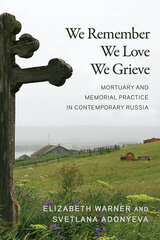 We Remember, We Love, We Grieve: Mortuary and Memorial Practice in Contemporary Russia
Elizabeth Warner and Svetlana Adonyeva
University of Wisconsin Press, 2021 This is a book about death, comprehensive in its discussion of strategies for coping with loss and grief in rural northern Russia. Elizabeth Warner and Svetlana Adonyeva bring forth the voices of those for whom caring for their dead is deeply personal and firmly rooted in practices of everyday life. Thoroughly researched chapters consider lamenting traditions, examine beliefs surrounding natural symbols, and parse sensitive and profound funereal rituals.
“We remember, we love, we grieve” is a common epitaph in this part of the world. As contemporary Russia contends with the Soviet Union’s legacy of dismantling older ways of life, the phrase ripples beyond individual loss—it encapsulates communities’ determination to preserve their customs when faced with oppression. This volume offers insight into a core cultural practice, exploring the dynamism of tradition.
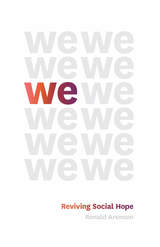 We: Reviving Social Hope
Ronald Aronson
University of Chicago Press, 2017 The election of Donald Trump has exposed American society’s profound crisis of hope. By 2016 a generation of shrinking employment, rising inequality, the attack on public education, and the shredding of the social safety net, had set the stage for stunning insurgencies at opposite ends of the political spectrum. Against this dire background, Ronald Aronson offers an answer. He argues for a unique conception of social hope, one with the power for understanding and acting upon the present situation. Hope, he argues, is far more than a mood or feeling—it is the very basis of social will and political action. It is this kind of hope that Aronson sees brewing in the supporters of Bernie Sanders, who advocated the tough-minded and inspired disposition to act collectively to make the world more equal, more democratic, more peaceful, and more just. And it was directly contrasted by Trump’s supporters who showed a cynical and nostalgic faith in an authoritarian strongman replete with bigotry and misogyny.
Beneath today’s crisis Aronson examines our heartbreaking story: a century of catastrophic violence and the bewildering ambiguity of progress—all of which have contributed to the evaporation of social hope. As he shows, we are now in a time when hope is increasingly privatized, when—despite all the ways we are connected to each other—we are desperately alone, struggling to weather the maelstrom around us, demoralized by the cynicism that permeates our culture and politics, and burdened with finding personal solutions to social problems.
Yet, Aronson argues, even at a time when false hopes are rife, social hope still persists. Carefully exploring what we mean when we say we “hope” and teasing hope apart from its dangerously misconstrued sibling, “progress,” he locates seeds of real change. He argues that always underlying our experience—even if we completely ignore it—is the fact of our social belonging, and that this can be reactivated into a powerful collective force, an active we. He looks to various political movements, from the massive collective force of environmentalists to the movements around Sanders and Jeremy Corbyn, as powerful examples of socially energized, politically determined, and actionably engaged forms of hope. Even in this age of Donald Trump, the result is an illuminating and inspiring call that anyone can clearly hear: we can still create a better future for everyone, but only if we resist false hopes and act together.
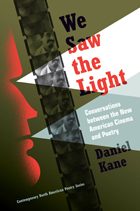 We Saw the Light: Conversations between New American Cinema and Poetry
Daniel Kane
University of Iowa Press, 2009 By the mid-1960s, New American poets and Underground filmmakers had established a vibrant community. Allen Ginsberg, John Ashbery, Robert Duncan, Robert Creeley, and Frank O’Hara joined Kenneth Anger, Stan Brakhage, Robert Frank, Alfred Leslie, and Andy Warhol to hang out, make films, read poems, fight censorship, end racism, and shut down the Vietnam War. Their personal, political, and artistic collaborations led them to rethink the moving picture and the lyric, resulting in an extraordinary profusion of poetry/film hybrids.
Drawing on unpublished correspondences and personal interviews with key figures in the innovative poetry and film communities, Daniel Kane’s stunningly erudite and accessible work not only provides a fresh look at avant-garde poetry and film but also encourages readers to rethink the artistic scenes of the 1960s and today. We Saw the Light will reframe the very way we talk about how film influences poetry and force us to think anew about the radical ways in which art is created and in turn influences subsequent work.
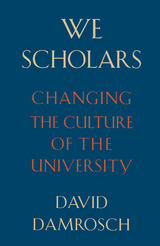 We Scholars: Changing the Culture of the University
David Damrosch
Harvard University Press, 1995 Never before have so many scholars produced so much work--and never before have they seemed to have so little to say to one another, or to the public at large. This is the dilemma of the modern university, which today sets the pattern for virtually all scholarship. In his eloquent book, David Damrosch offers a lucid, often troubling assessment of the state of scholarship in our academic institutions, a look at how these institutions acquired their present complexion, and a proposal for reforms that can promote scholarly communication and so, perhaps, broader, more relevant scholarship.
We Scholars explores an academic culture in which disciplines are vigorously isolated and then further divided into specialized fields, making for a heady mix of scholarly alienation and disciplinary territorialism, a wealth of specialized inquiry and a poverty of general discussion. This pattern, however, is not necessary and immutable; rather, it stems from decisions made a century ago, when the American university assumed its modern form. Damrosch traces the political and economic assumptions behind these decisions and reveals their persisting effects on academic structures despite dramatic changes in the larger society. We Scholars makes a compelling case for a scholarly community more reflective of and attuned to today's needs. The author's call for cooperation as the basis for intellectual endeavor, both within and outside the academy, will resonate for anyone concerned with the present complexities and future possibilities of academic work.
 We Shall Be All: A History of the Industrial Workers of the World (abridged ed.)
Melvyn Dubofsky
University of Illinois Press, 2000 This is the classic history of the Industrial Workers of the World, the influential band of labor militants whose activism mobilized America's poorest and most marginalized workers in the years before World War I.
Originally published in 1969, Melvyn Dubofsky's We Shall Be All has remained the definitive archive-based history of the IWW. While much has been written on aspects of the IWW's history in the past three decades, nothing has duplicated or surpassed this authoritative work. The present volume, an abridged version of this labor history classic, makes the compelling story of the IWW accessible to a new generation of readers.
In its heyday, between 1905 and 1919, the IWW nourished a dream of a better America where poverty-–material and spiritual–-would be erased and where all people, regardless of nationality or color, would walk free and equal. More than half a century ago the Wobblies tried in their own ways to grapple with issues that still plague the nation in a more sophisticated and properous era. Their example has inspired radicals in America and abroad over the greater part of a century
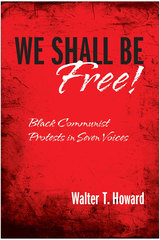 We Shall Be Free!: Black Communist Protests in Seven Voices
Walter T. Howard
Temple University Press, 2013 A groundbreaking contribution to scholarship of the African American Left, We Shall Be Free! gives voice to black Communists and recognizes the intellectual contributions found in their protest writings. Walter Howard provides a fascinating documentary history of seven diverse and historically significant black Communists--B.D. Amis, Harry Haywood, James W. Ford, Benjamin J. Davis, Jr., Louise Thompson Patterson, William Patterson, and Claudia Jones--who attempted to foster a black culture of resistance to white racism within the workings of the Communist Party.
Howard draws on FBI files, Moscow documents, and the records of the U.S. Communist Party. He surveys these black Communists addressing a wide range of vital issues such as the Great Depression, World War II, genocide and the Cold War.
We Shall Be Free! presents an important section of the African American community whose thought has been minimized, discounted, or overlooked altogether by the historical profession in general.
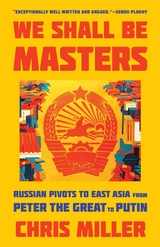 We Shall Be Masters: Russian Pivots to East Asia from Peter the Great to Putin
Chris Miller
Harvard University Press, 2021 An illuminating account of Russia’s attempts—and failures—to achieve great power status in Asia.
Since Peter the Great, Russian leaders have been lured by opportunity to the East. Under the tsars, Russians colonized Alaska, California, and Hawaii. The Trans-Siberian Railway linked Moscow to Vladivostok. And Stalin looked to Asia as a sphere of influence, hospitable to the spread of Soviet Communism. In Asia and the Pacific lay territory, markets, security, and glory.
But all these expansionist dreams amounted to little. In We Shall Be Masters, Chris Miller explores why, arguing that Russia’s ambitions have repeatedly outstripped its capacity. With the core of the nation concentrated thousands of miles away in the European borderlands, Russia’s would-be pioneers have always struggled to project power into Asia and to maintain public and elite interest in their far-flung pursuits. Even when the wider population professed faith in Asia’s promise, few Russians were willing to pay the steep price. Among leaders, too, dreams of empire have always been tempered by fears of cost. Most of Russia’s pivots to Asia have therefore been halfhearted and fleeting.
Today the Kremlin talks up the importance of “strategic partnership” with Xi Jinping’s China, and Vladimir Putin’s government is at pains to emphasize Russian activities across Eurasia. But while distance is covered with relative ease in the age of air travel and digital communication, the East remains far off in the ways that matter most. Miller finds that Russia’s Asian dreams are still restrained by the country’s firm rooting in Europe.
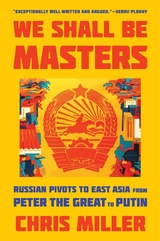 We Shall Be Masters: Russian Pivots to East Asia from Peter the Great to Putin
Chris Miller
Harvard University Press “Miller’s terrific book reminds that Russia made moves toward the East five hundred years ago, and explains why ignoring the Russian factor in Asian geopolitics today would be a big mistake.”
—Michael McFaul, author of From Cold War to Hot Peace
“Miller presents a Russia little known in the West: a Eurasian power that treats its eastern calling as seriously as it does its western one. Exceptionally well written and argued, We Shall Be Masters helps us understand Russia on its own terms and offers historical insight into the future of its relations with China, its main rival and occasional ally.”
—Serhii Plokhy, author of The Gates of Europe
“Challenges the conventional view that [Russia] has enduring interests in the Far East…For Russia, Miller argues, Asia has been a land of unfulfilled promises.”
—Foreign Affairs
“Captures the immensity, complexity, and importance of Russia’s eastern borderlands through the eyes of its explorers…Comprehensive and fluidly written.”
—Publishers Weekly
Ever since Peter the Great, Russian leaders have been lured by the promise of the East. But from the tsars to Stalin and beyond, Russia’s ambitions have repeatedly outstripped its capacity. In We Shall Be Masters, Chris Miller explores why these expansionist dreams so often ended in disappointment. With the heart of the nation in the European borderlands, Russia’s would-be pioneers struggled to maintain public interest in their far-flung pursuits. But its leaders never stopped setting their sights on the riches of the East. Today, as Vladimir Putin seeks to cement his strategic partnership with Xi Jinping’s China, the East remains as elusive and attractive to Russia as ever—and is likely to be as unattainable.
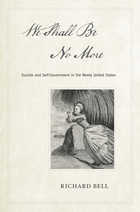 We Shall Be No More: Suicide and Self-Government in the Newly United States
Richard Bell
Harvard University Press, 2012 Suicide is a quintessentially individual act, yet one with unexpectedly broad social implications. Though seen today as a private phenomenon, in the uncertain aftermath of the American Revolution this personal act seemed to many to be a public threat that held no less than the fate of the fledgling Republic in its grip.
Salacious novelists and eager newspapermen broadcast images of a young nation rapidly destroying itself. Parents, physicians, ministers, and magistrates debated the meaning of self-destruction and whether it could (or should) be prevented. Jailers and justice officials rushed to thwart condemned prisoners who made halters from bedsheets, while abolitionists used slave suicides as testimony to both the ravages of the peculiar institution and the humanity of its victims. Struggling to create a viable political community out of extraordinary national turmoil, these interest groups invoked self-murder as a means to confront the most consequential questions facing the newly united states: What is the appropriate balance between individual liberty and social order? Who owns the self? And how far should the control of the state (or the church, or a husband, or a master) extend over the individual?
With visceral prose and an abundance of evocative primary sources, Richard Bell lays bare the ways in which self-destruction in early America was perceived as a transgressive challenge to embodied authority, a portent of both danger and possibility. His unique study of suicide between the Revolution and Reconstruction uncovers what was at stake—personally and politically—in the nation’s fraught first decades.
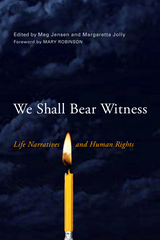 We Shall Bear Witness: Life Narratives and Human Rights
Edited by Meg Jensen and Margaretta Jolly, Foreword by Mary Robinson
University of Wisconsin Press, 2014 Personal testimonies are the life force of human rights work, and rights claims have brought profound power to the practice of life writing. This volume explores the connections and conversations between human rights and life writing through a dazzling, international collection of essays by survivor-writers, scholars, and human rights advocates.
In We Shall Bear Witness, editors Meg Jensen and Margaretta Jolly assemble moving personal accounts from those who have endured persecution, imprisonment, and torture; meditations on experiences of injustice and protest by creative writers and filmmakers; and innovative research on ways that digital media, commodification, and geopolitics are shaping what is possible to hear and say. The book’s primary sections—testimony, recognition, representation, and justice—evoke the key stages in turning experience into a human rights life story and attend to such diverse and varied arts as autobiography, documentary film, report, oral history, blog, and verbatim theater. The result is a groundbreaking book that sensitively examines how life and rights narratives have become so powerfully entwined. Also included is an innovative guide to teaching human rights and life narrative in the classroom.
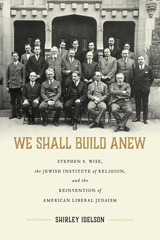 We Shall Build Anew: Stephen S. Wise, the Jewish Institute of Religion, and the Reinvention of American Liberal Judaism
Shirley Idelson
University of Alabama Press, 2022 How Rabbi Stephen S. Wise changed the trajectory of American Reform Judaism over the course of the twentieth century and well into the twenty-first
In 1922, Rabbi Stephen S. Wise, a leader of the Zionist movement, established the Jewish Institute of Religion (JIR), a nondenominational rabbinical seminary in New York City. Having already founded the thriving Free Synagogue movement and the American Jewish Congress, he intended to revolutionize American liberal Judaism. Wise believed mainstream American Jewish institutions had become outdated, and he championed a progressive Jewish nationalism that would fight alongside America’s leading proponents of social and economic justice.
We Shall Build Anew tells the little-known story of how Wise changed the trajectory of American Judaism for the next century. Through JIR, he trained a new cadre of young rabbis who shared his outlook, charged them with invigorating and reshaping Jewish life, and launched them into positions of leadership across the country. While Wise earned the ire of many mainstream Jewish leaders through his disregard for denominational distinctions, JIR became home to faculty and students of widely divergent religious and political viewpoints.
We Shall Build Anew is the first book dedicated exclusively to the history of the Jewish Institute of Religion. The story of Wise’s vision for American liberal Judaism is now more important than ever. As American Jewry becomes increasingly polarized around debates concerning religious doctrine as well as Zionism and Israel, the JIR model offers hope that progressives and conservatives, Zionists and non-Zionists, and Jews representing the full spectrum of religious life cannot only coexist but also work together in the name of a vibrant Judaism and a just and peaceful world.
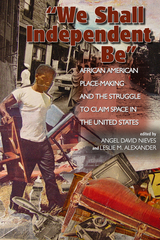 We Shall Independent Be: African American Place-Making and the Struggle to Claim Space in the United States
Angel David Nieves
University Press of Colorado, 2008 With twenty chapters from leading scholars in African American history, urban studies, architecture, women's studies, American studies, and city planning, "We Shall Independent Be " illuminates African Americans' efforts to claim space in American society despite often hostile resistance. As these essays attest, Black self-determination was central to the methods African Americans employed in their quest to establish a sense of permanence and place in the United States.
Contributors define space to include physical, social, and intellectual sites throughout the Northern and Southern regions of the United States, ranging from urban milieus to the suburbs and even to swamps and forests. They explore under-represented locations such as burial grounds, courtrooms, schools, and churches. Moreover, contributors demonstrate how Black consciousness and ideology challenged key concepts of American democracy - such as freedom, justice, citizenship, and equality - establishing African American space in social and intellectual areas.
Ultimately, "We Shall Independent Be " recovers the voices of African American men and women from the antebellum United States through the present and chronicles their quest to assert their right to a place in American society. By identifying, examining, and telling the stories of contested sites, this volume demonstrates the power of African American self-definition and agency in the process of staking a physical and ideological claim to public space
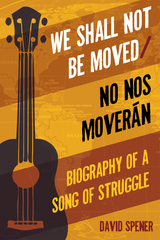 We Shall Not Be Moved/No nos moveran: Biography of a Song of Struggle
David Spener
Temple University Press, 2016 The activist anthem “We Shall Not Be Moved” expresses resolve in the face of adversity; it helps members of social movements persevere in their struggles to build a better world. The exact origins of the song are unknown, but it appears to have begun as a Protestant revival song sung by rural whites and African slaves in the southeastern United States in the early nineteenth century. The song was subsequently adopted by U.S. labor and civil rights activists, students and workers opposing the Franco dictatorship in Spain, and by Chilean supporters of that country’s socialist government in the early 1970s. In his fascinating biography, We Shall Not Be Moved, David Spener details the history and the role the song has played in each of the movements in which it has been sung. He analyzes its dissemination, function, and meaning through a number of different sociological and anthropological lenses to explore how songs can serve as an invaluable resource to participants in movements for social change.
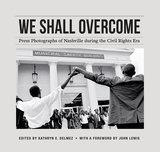 We Shall Overcome: Press Photographs of Nashville during the Civil Rights Era
Kathryn E. Delmez
Vanderbilt University Press, 2023 Named One of the "Best Art Books of 2018" by the New York Times
Fifty years after Martin Luther King Jr.'s death—and at a time when race relations and social justice are again at the forefront of our country's consciousness—this book expands on a Frist Art Museum exhibition to present a selection of approximately one hundred photographs that document an important period in Nashville's struggle for racial equality. The images were taken between 1957, the year that desegregation in public schools began, and 1968, when the National Guard was called in to surround the state capitol in the wake of the civil rights leader's assassination in Memphis.
Of central significance are photographs of lunch counter sit-ins in early 1960, led by a group of students, including John Lewis (who contributed the book's foreword) and Diane Nash, from local historically black colleges and universities. The demonstrations were so successful that King stated just a few weeks later at Fisk University: "I did not come to Nashville to bring inspiration but to gain inspiration from the great movement that has taken place in this community." The role that Nashville played in the national civil rights movement as a hub for training students in nonviolent protest and as the first Southern city to integrate places of business is a story that warrants reexamination.
The book also provides an opportunity to consider the role of images and the media in shaping public opinion, a relevant subject in today's news-saturated climate. Photographs from the archives of both daily newspapers are included: the Tennessean, which was the more liberal publication, and the Nashville Banner, a conservative paper whose leadership seemed less interested in covering events related to racial issues. Some of the photographs in the exhibition had been selected to be published in the papers, but many were not, and their disclosure reveals insight into the editorial process. In several images, other photojournalists and news crews are visible, serving as a reminder of the almost constant presence of the camera during these historic times.
Essays by Linda Wynn of Fisk University and the Tennessee Historical Commission and Susan H. Edwards, executive director of the Frist Art Museum, offer historical context on Nashville during the civil rights era and on photojournalism, respectively. Congressman John Lewis's foreword recounts memories of his time in Nashville and reminds us that there is still work to be done to build King's Beloved Community.
We Share Our Matters: Two Centuries of Writing and Resistance at Six Nations of the Grand River
Rick Monture
University of Manitoba Press, 2014 The Haudenosaunee, more commonly known as the Iroquois or Six Nations, have been one of the most widely written about Indigenous groups in the United States and Canada. But seldom have the voices emerging from this community been drawn on in order to understand its enduring intellectual traditions. Rick Monture’s We Share Our Matters offers the first comprehensive portrait of how the Haudenosaunee of the Grand River region have expressed their long struggle for sovereignty in Canada. Through careful readings of more than two centuries of letters, speeches, ethnography, poetry, fiction, nonfiction, and film, Monture argues Haudenosaunee core beliefs have remained remarkably consistent and continue to inspire ways to address current social and political realities.
 We Should Soon Become Respectable: Nashville's Own Timothy Demonbreun
Elizabeth Elkins
Vanderbilt University Press, 2022 Jacques-Timothe Boucher Sieur de Montbrun (anglicized to Demonbreun), born 1747 in Quebec, set the bar for country music's stories of cheating, gambling, drinking, and being the boss more than two centuries before anybody thought of supporting the storyline with a 1-4-5-4 chord progression and a fiddle.
Lightly called a "fur trader," he came to the city to make his fortune and fame, much like songwriters today. Looking back, it would be easy to call Demonbreun, the son of French Canadian near-royalty and brother to two nuns, a spoiled child who did what he wanted, a classic-case misogynist and polygamist, a conceited adventurer. He was a man who conned the Spanish governor out of a war, carried on graceful correspondence with Thomas Jefferson and Alexander Hamilton, owned several slaves, may have served as a spy, and was a decorated veteran. He fought in the Revolutionary War, extraordinarily so it seems, given the number of land grants he received across Kentucky and Tennessee.
He's also known around Nashville as the guy who lived in a cave.
Author Elizabeth Elkins sorts through the legends and nails down the facts in order to present the true story of "Nashville's First Citizen."
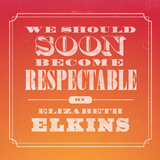 We Should Soon Become Respectable: Nashville's Own Timothy Demonbreun
Elizabeth Elkins
Vanderbilt University Press, 2022 Jacques-Timothe Boucher Sieur de Montbrun (anglicized to Demonbreun), born 1747 in Quebec, set the bar for country music's stories of cheating, gambling, drinking, and being the boss more than two centuries before anybody thought of supporting the storyline with a 1-4-5-4 chord progression and a fiddle.
Lightly called a "fur trader," he came to the city to make his fortune and fame, much like songwriters today. Looking back, it would be easy to call Demonbreun, the son of French Canadian near-royalty and brother to two nuns, a spoiled child who did what he wanted, a classic-case misogynist and polygamist, a conceited adventurer. He was a man who conned the Spanish governor out of a war, carried on graceful correspondence with Thomas Jefferson and Alexander Hamilton, owned several slaves, may have served as a spy, and was a decorated veteran. He fought in the Revolutionary War, extraordinarily so it seems, given the number of land grants he received across Kentucky and Tennessee.
He's also known around Nashville as the guy who lived in a cave.
Author Elizabeth Elkins sorts through the legends and nails down the facts in order to present the true story of "Nashville's First Citizen."
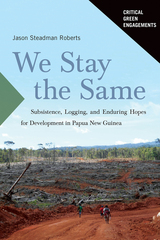 We Stay the Same: Subsistence, Logging, and Enduring Hopes for Development in Papua New Guinea
Jason Steadman Roberts
University of Arizona Press, 2024 On a remote island in the South Pacific, the Lavongai have consistently struggled to obtain development through logging and commercial agriculture. Yet many Lavongai still long to move beyond the grind of subsistence work that has seemingly defined their lives on New Hanover, Papua New Guinea, for generations.
Following a long history of smaller-scale and largely unsuccessful resource development efforts, New Hanover became the site of three multinational-controlled special agricultural and business leases (SABLs) that combined to cover over 75 percent of the island for ninety-nine-year lease terms. These agroforestry projects were part of a national effort to encourage “sustainable” rural development by tapping into the growing global demand for agricultural lands and crops like oil palm and biofuels. They were supposed to succeed where the smaller-scale projects of the past had failed. Unfortunately, these SABLs resulted in significant forest loss and livelihood degradation, while doing little to promote the type of economic development that many Lavongai had been hoping for.
It is within this context that We Stay the Same grounds questions of hope for transformative economic change within Lavongai assessments of the inequitable relationships between global processes of resource development and the local lives that have become increasingly defined by the necessities and failures of these processes. Written in a clear and relatable style for students, We Stay the Same combines ethnographic and ecological research to show how the Lavongai continue to survive and make meaningful lives in a situation where their own hopes for a better future have often been used against them as a mechanism of a more distantly profitable dispossession.
WE STILL HOLD THESE TRUTHS: Rediscovering Our Principles, Reclaiming Our Future
Matthew Spalding
Intercollegiate Studies Institute, 2010
“Invaluable . . . The book that Americans need now.” —National Review
The Essential Guide to Rolling Back the Progressive Assault and Putting America Back on Course
Many Americans are concerned, frightened, angry. The country, it seems, is on the wrong track.
But what is the right course for America? Knowing what we stand against is not the same as knowing what we stand for.
Just in time, Matthew Spalding provides the plan for translating angst into proper action in this essential book—a #2 Washington Post bestseller. We Still Hold These Truths offers a bracing analysis of how and why we have lost our bearings as a nation and lays out the strategy to rescue our future from arbitrary and unlimited government.
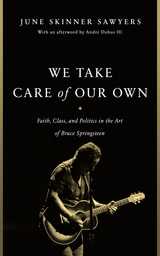 We Take Care of Our Own: Faith, Class, and Politics in the Art of Bruce Springsteen
June Skinner Sawyers
Rutgers University Press, 2024 We Take Care of Our Own traces the evolution of Bruce Springsteen’s beliefs, beginning with his New Jersey childhood and ending with his most recent works from Springsteen on Broadway to Letter to You. The author follows the singer’s life, examining his albums and a variety of influences (both musical and nonmusical), especially his Catholic upbringing and his family life, to show how he became an outspoken icon for working-class America—indeed for working-class life throughout the world. In this way, the author emphasizes the universality of Springsteen’s canon and depicts how a working-class sensibility can apply to anyone anywhere who believes in fairness and respect. In addition, the author places Springsteen in the historical context not only of literature (especially John Steinbeck) but also of the art world (specifically the work of Thomas Hart Benton and Edward Hopper). Among the themes explored in the book include community, a sense of place, America as the Promised Land, the myth of the West, and, ultimately, mortality.
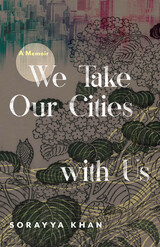 We Take Our Cities with Us: A Memoir
Sorayya Khan
Ohio State University Press, 2022 Even when we leave them, our cities never leave us. After her Dutch mother’s death, Sorayya Khan confronts her grief by revisiting their relationship, her parents’ lives, and her own Pakistani-Dutch heritage in a multicultural memoir that unfolds over seven cities and three continents. We Take Our Cities with Us ushers us from Khan’s childhood independence forged at her grandparents’ home in Lahore; to her adolescence in Pakistan’s new capital, Islamabad; to Syracuse and Ithaca, New York, where Khan finds her footing as the mother of young, brown sons in post-9/11 America; to her birthplace, Vienna, where her parents die; and finally to Amsterdam and Maastricht, the cities of her mother’s conflicted youth. In Khan’s gripping telling of her immigrant experience, she shows us what it is to raise children and lose parents in worlds other than your own. Drawing on family history, geopolitics, and art in this stunning story of loss, identity, and rediscovery, Khan beautifully illuminates the complexities of our evolving global world and its most important constant: love.
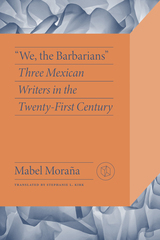 "We, the Barbarians": Three Mexican Writers in the Twenty-First Century
Mabel Moraña; Translated by Stephanie L. Kirk
Vanderbilt University Press, 2024 “We, the Barbarians” embarks on a careful and exhaustive reading of three of the most prominent authors in the latest wave of Mexican fiction: Yuri Herrera, Fernanda Melchor, and Valeria Luiselli. Originally published in Mexico in 2021, this work is divided into three parts, one for each author’s narrative production. The book analyzes all of the literary works published by Herrera, Melchor, and Luiselli from the beginning of their writing careers until 2021, allowing for a diachronic interpretation of their respective narrative projects as well as for comparative approaches to their aesthetic and ideological contours.
Characterized by the fragmentation of civil society and the decomposition of the myths that accompanied the consolidation of the modern nation, Mexican visual and literary arts have explored a myriad of representational avenues to approach the phenomena of violence, institutional decay, and political instability. The critical and theoretical approaches in “We, the Barbarians” explore a variety of alternative symbolic representations of topics such as nationalism, community, and affect in times impacted by systemic violence, precariousness, and radical inequality. Moraña perceives the negotiations between regional/local imaginaries and global scenarios characterized by the devaluation and resignification of life, both at individual and collective levels. Though it uses three authors as its focus, this book seeks to more broadly theorize the question of the relationship between literature and the social in the twenty-first century.
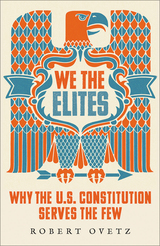 We the Elites: Why the US Constitution Serves the Few
Robert
Pluto Press, 2022 An adroit collection of essays exposing the constitution for what it really is – a rulebook to protect capitalism for the elites. Written by 55 of the richest white men of early America, and signed by only 39 of them, the constitution is the sacred text of American nationalism. Popular perceptions of it are mired in idolatry, myth, and misinformation - many Americans have opinions on the constitution but have no idea what’s in it. The misplaced faith of social movements in the constitution as a framework for achieving justice actually obstructs social change - incessant lengthy election cycles, staggered terms, and legislative sessions have kept social movements trapped in a redundant loop. This stymies progress on issues like labor rights, public health, and climate change, projecting the American people and the rest of the world towards destruction. Robert Ovetz’s reading of the constitution shows that the system isn’t broken. Far from it. It works as it was designed.
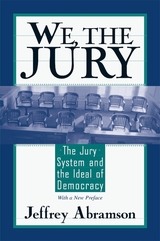 We, the Jury: The Jury System and the Ideal of Democracy, With a New Preface
Jeffrey Abramson
Harvard University Press, 2000 In a new preface to this foundational book on the American jury, Jeffrey Abramson responds to his critics, defends his views on the jury as an embodiment of deliberative democracy in action, and reflects on recent jury trials and reforms.
Praise for the previous edition:
“Power to the persuasive! That’s the message of Jeffrey Abramson’s incisive, thoroughly researched, demanding book about the role of the jury in American democracy…At a rare moment when the media have whetted the public appetite for commentary about the jury, of all things, a fresh, substantial [book] has come along.”—Washington Post Book World
“Anyone tempted to ridicule juries…should read Jeffrey Abramson’s profound and eloquent defense of the American jury system…Mr. Abramson has faith in juries because they are a form of democratic justice. He describes in fascinating detail how democracy in America has developed over the years in tandem with the jury system.”—The Economist
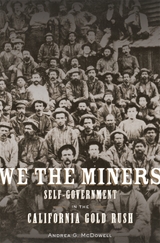 We the Miners: Self-Government in the California Gold Rush
Andrea G. McDowell
Harvard University Press, 2022 A Financial Times Best History Book of the Year
A surprising account of frontier law that challenges the image of the Wild West. In the absence of state authority, Gold Rush miners crafted effective government by the people—but not for all the people.
Gold Rush California was a frontier on steroids: 1,500 miles from the nearest state, it had a constantly fluctuating population and no formal government. A hundred thousand single men came to the new territory from every corner of the nation with the sole aim of striking it rich and then returning home. The circumstances were ripe for chaos, but as Andrea McDowell shows, this new frontier was not nearly as wild as one would presume. Miners turned out to be experts at self-government, bringing about a flowering of American-style democracy—with all its promises and deficiencies.
The Americans in California organized and ran meetings with an efficiency and attention to detail that amazed foreign observers. Hundreds of strangers met to adopt mining codes, decide claim disputes, run large-scale mining projects, and resist the dominance of companies financed by outside capital. Most notably, they held criminal trials on their own authority. But, mirroring the societies back east from which they came, frontiersmen drew the boundaries of their legal regime in racial terms. The ruling majority expelled foreign miners from the diggings and allowed their countrymen to massacre the local Native Americans. And as the new state of California consolidated, miners refused to surrender their self-endowed authority to make rules and execute criminals, presaging the don’t-tread-on-me attitudes of much of the contemporary American west.
In We the Miners, Gold Rush California offers a well-documented test case of democratic self-government, illustrating how frontiersmen used meetings and the rules of parliamentary procedure to take the place of the state.
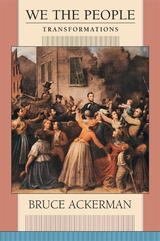 We the People
Bruce Ackerman
Harvard University Press, 1998 Constitutional change, seemingly so orderly, formal, and refined, has in fact been a revolutionary process from the first, as Bruce Ackerman makes clear in We the People: Transformations. The Founding Fathers, hardly the genteel conservatives of myth, set America on a remarkable course of revolutionary disruption and constitutional creativity that endures to this day. After the bloody sacrifices of the Civil War, Abraham Lincoln and the Republican Party revolutionized the traditional system of constitutional amendment as they put principles of liberty and equality into higher law. Another wrenching transformation occurred during the Great Depression, when Franklin Roosevelt and his New Dealers vindicated a new vision of activist government against an assault by the Supreme Court.
These are the crucial episodes in American constitutional history that Ackerman takes up in this second volume of a trilogy hailed as "one of the most important contributions to American constitutional thought in the last half-century" (Cass Sunstein, New Republic). In each case he shows how the American people--whether led by the Founding Federalists or the Lincoln Republicans or the Roosevelt Democrats--have confronted the Constitution in its moments of great crisis with dramatic acts of upheaval, always in the name of popular sovereignty. A thoroughly new way of understanding constitutional development, We the People: Transformations reveals how America's "dualist democracy" provides for these populist upheavals that amend the Constitution, often without formalities.
The book also sets contemporary events, such as the Reagan Revolution and Roe v. Wade, in deeper constitutional perspective. In this context Ackerman exposes basic constitutional problems inherited from the New Deal Revolution and exacerbated by the Reagan Revolution, then considers the fundamental reforms that might resolve them. A bold challenge to formalist and fundamentalist views, this volume demonstrates that ongoing struggle over America's national identity, rather than consensus, marks its constitutional history.
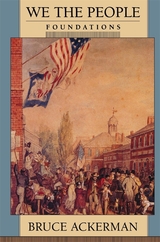 We the People
Bruce Ackerman
Harvard University Press, 1991 Bruce Ackerman offers a sweeping reinterpretation of our nation’s constitutional experience and its promise for the future. Integrating themes from American history, political science, and philosophy, We the People confronts the past, present, and future of popular sovereignty in America. Only this distinguished scholar could present such an insightful view of the role of the Supreme Court. Rejecting arguments of judicial activists, proceduralists, and neoconservatives, Ackerman proposes a new model of judicial interpretation that would synthesize the constitutional contributions of many generations into a coherent whole. The author ranges from examining the origins of the dualist tradition in the Federalist Papers to reflecting upon recent, historic constitutional decisions. The latest revolutions in civil rights, and the right to privacy, are integrated into the fabric of constitutionalism. Today’s Constitution can best be seen as the product of three great exercises in popular sovereignty, led by the Founding Federalists in the 1780s, the Reconstruction Republicans in the 1860s, and the New Deal Democrats in the 1930s.
Ackerman examines the roles played during each of these periods by the Congress, the Presidency, and the Supreme Court. He shows that Americans have built a distinctive type of constitutional democracy, unlike any prevailing in Europe. It is a dualist democracy, characterized by its continuing effort to distinguish between two kinds of politics: normal politics, in which organized interest groups try to influence democratically elected representatives; and constitutional politics, in which the mass of citizens mobilize to debate matters of fundamental principle. Although American history is dominated by normal politics, our tradition places a higher value on mobilized efforts to gain the consent of the people to new governing principles. In a dualist democracy, the rare triumphs of constitutional politics determine the course of normal politics.
More than a decade in the making, and the first of three volumes, We the People, Volume 1: Foundations speaks to all who seek to renew and redefine our civic commitments in the decades ahead.
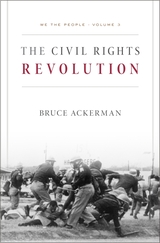 We the People
Bruce Ackerman
Harvard University Press, 2014 The Civil Rights Revolution carries Bruce Ackerman’s sweeping reinterpretation of constitutional history into the era beginning with Brown v. Board of Education. From Rosa Parks’s courageous defiance, to Martin Luther King’s resounding cadences in “I Have a Dream,” to Lyndon Johnson’s leadership of Congress, to the Supreme Court’s decisions redefining the meaning of equality, the movement to end racial discrimination decisively changed our understanding of the Constitution.
“The Civil Rights Act turns 50 this year, and a wave of fine books accompanies the semicentennial. Ackerman’s is the most ambitious; it is the third volume in an ongoing series on American constitutional history called We the People. A professor of law and political science at Yale, Ackerman likens the act to a constitutional amendment in its significance to the country’s legal development.”
—Michael O’Donnell, The Atlantic
“Ackerman weaves political theory with historical detail, explaining how the civil rights movement evolved from revolution to mass movement and then to statutory law…This fascinating book takes a new look at a much-covered topic.”
—Becky Kennedy, Library Journal
We, the People: Politics of National Peculiarity in Southeastern Europe
Diana Mishkova
Central European University Press, 2009 Analyzes the processes of nation-building in nineteenth and early-twentieth-century south-eastern Europe. A product of transnational comparative teamwork, this collection represents a coordinated interpretation based on ten varied academic cultures and traditions.
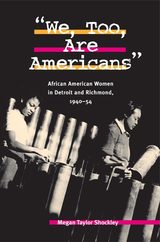 We, Too, Are Americans: African American Women in Detroit and Richmond, 1940-54
Megan Taylor Shockley
University of Illinois Press, 2003 During World War II, factories across America retooled for wartime production, and unprecedented labor opportunities opened up for women and minorities. In We, Too, Are Americans, Megan Taylor Shockley examines the experiences of the African American women who worked in two capitols of industry--Detroit, Michigan, and Richmond, Virginia--during the war and the decade that followed it, making a compelling case for viewing World War II as the crucible of the civil rights movement.
As demands on them intensified, the women working to provide American troops with clothing, medical supplies, and other services became increasingly aware of their key role in the war effort. A considerable number of the African Americans among them began to use their indispensability to leverage demands for equal employment, welfare and citizenship benefits, fair treatment, good working conditions, and other considerations previously denied them.
Shockley shows that as these women strove to redefine citizenship, backing up their claims to equality with lawsuits, sit-ins, and other forms of activism, they were forging tools that civil rights activists would continue to use in the years to come.
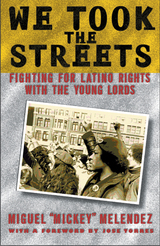 We Took the Streets: Fighting for Latino Rights with the Young Lords
Miguel "Mickey" Melendez
Rutgers University Press In this memoir, Melendez describes with the unsparing eye of an insider the idealism, anger, and vitality of the Lords as they rose to become the most respected and powerful voice of Puerto Rican empowerment in the country. He also traces the internal ideological disputes that led the group, but not the mission, to fracture in 1972. Written with passion and compelling detail, We Took the Streets tells the story of how one group took on the establishment—and won. In 1968 Miguel “Mickey” Melendez was a college student, developing pride in his Cuban and Puerto Rican cultural identity and becoming increasingly aware of the effects of social inequality on Latino Americans. Joining with other like-minded student activists, Melendez helped form the central committee of the New York branch of the Young Lords, one of the most provocative and misunderstood radical groups to emerge during the 1960s. Incorporating techniques of direct action and community empowerment, the Young Lords became a prominent force in the urban northeast. From their storefront offices in East Harlem, they defiantly took back the streets of El Barrio. In addition to running clothing drives, day-care centers, and food and health programs, they became known for their media-savvy tactics and bold actions, like the takeovers of the First People’s Church and Lincoln Hospital.
We Wanna Boogie: The Rockabilly Roots of Sonny Burgess and the Pacers
Marvin Schwartz
Butler Center for Arkansas Studies, 2014 Rock and roll pioneer and Newport native Sonny Burgess is a member of the Rockabilly Hall of Fame. In this book full of personal interviews and remembrances, Burgess and his band tell of their original recordings for Sun Records in the 1950s; their shows with greats such as Elvis Presley, Johnny Cash, and Jerry Lee Lewis; and their success in the contemporary rockabilly revival. This also is the history of a once prominent and spirited Delta community of extensive agricultural wealth. Newport was home to numerous music clubs that hosted national artists as well as illicit backroom gambling. Burgess is a product of this history, and his vivacious music is shaped by his hometown and the dramatic transformation of southern rural life it witnessed.
We Were a Handful
Karel Polácek
Karolinum Press, 2007 A favorite work of Czech humor, We Were a Handful depicts the adventures of five boys from a small Czech town through the diary of Petr Bajza, the grocer’s son. Written by Karel Poláček at the height of World War II before his deportation to Auschwitz in 1944, this book draws on the happier years of Poláček’s own childhood as inspiration. As we look upon the world through Petr’s eyes, we, too, marvel at the incomprehensible world of grownups; join in fights between gangs of neighborhood kids; and laugh at the charming language of boys, a major source of the book’s humor. This translation at last offers English-language readers the opportunity to share in Petr’s (and Poláček’s) childhood and reminds us that joy and laughter are possible even in the darkest times.
We Were a Handful
Karel Polácek
Karolinum Press, 2007 A favorite work of Czech humor, We Were a Handful depicts the adventures of five boys from a small Czech town through the diary of Petr Bajza, the grocer’s son. Written by Karel Poláček at the height of World War II before his deportation to Auschwitz in 1944, this book draws on the happier years of Poláček’s own childhood as inspiration. As we look upon the world through Petr’s eyes, we, too, marvel at the incomprehensible world of grownups; join in fights between gangs of neighborhood kids; and laugh at the charming language of boys, a major source of the book’s humor. This translation at last offers English-language readers the opportunity to share in Petr’s (and Poláček’s) childhood and reminds us that joy and laughter are possible even in the darkest times.
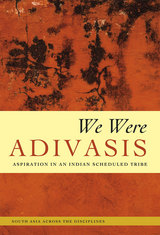 We Were Adivasis: Aspiration in an Indian Scheduled Tribe
Megan Moodie
University of Chicago Press, 2015 In We Were Adivasis, anthropologist Megan Moodie examines the Indian state’s relationship to “Scheduled Tribes,” or adivasis—historically oppressed groups that are now entitled to affirmative action quotas in educational and political institutions. Through a deep ethnography of the Dhanka in Jaipur, Moodie brings readers inside the creative imaginative work of these long-marginalized tribal communities. She shows how they must simultaneously affirm and refute their tribal status on a range of levels, from domestic interactions to historical representation, by relegating their status to the past: we were adivasis.
Moodie takes readers to a diversity of settings, including households, tribal council meetings, and wedding festivals, to reveal the aspirations that are expressed in each. Crucially, she demonstrates how such aspiration and identity-building are strongly gendered, requiring different dispositions required of men and women in the pursuit of collective social uplift. The Dhanka strategy for occupying the role of adivasi in urban India comes at a cost: young women must relinquish dreams of education and employment in favor of community-sanctioned marriage and domestic life. Ultimately, We Were Adivasis explores how such groups negotiate their pasts to articulate different visions of a yet uncertain future in the increasingly liberalized world.
|
|
